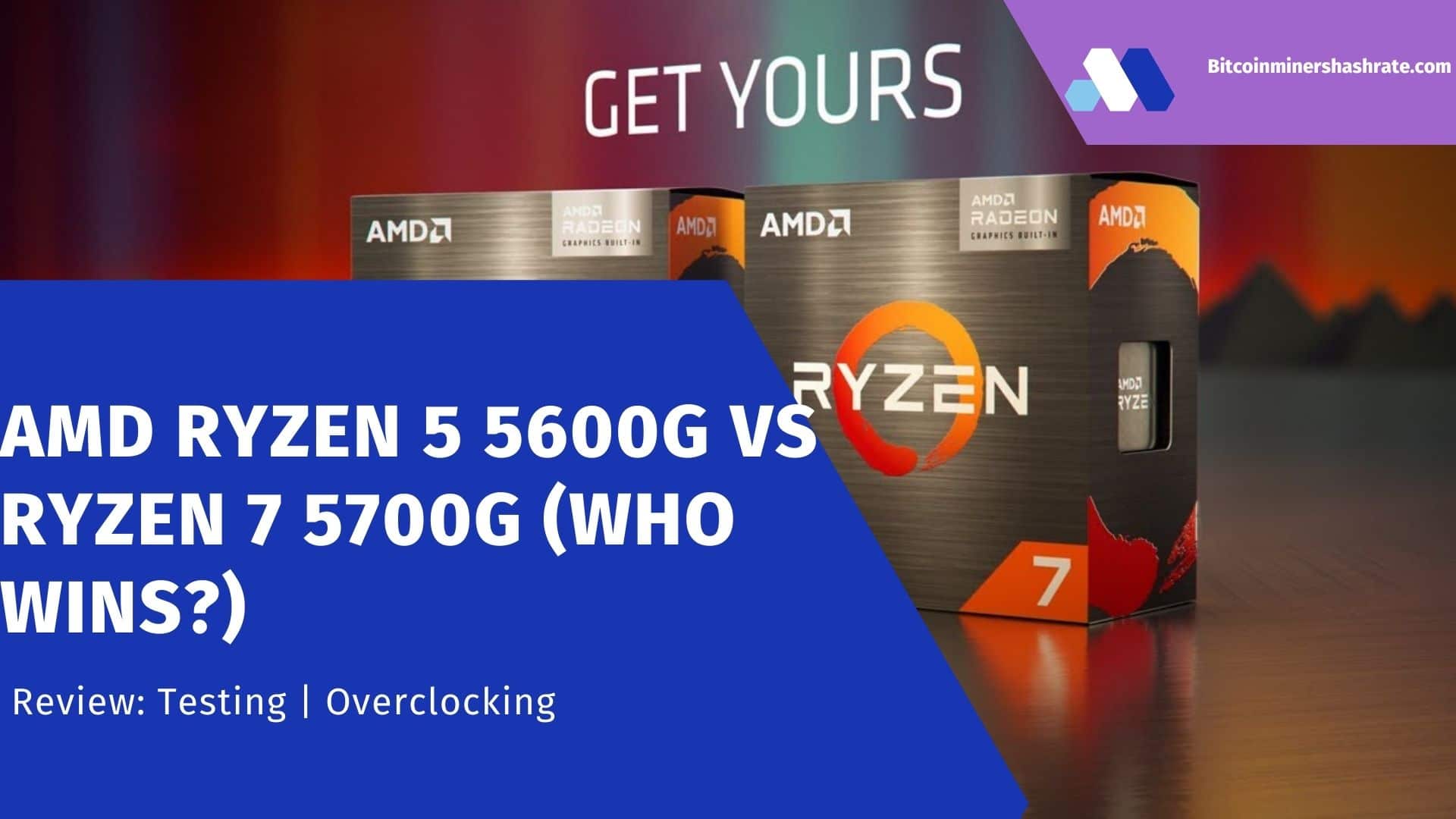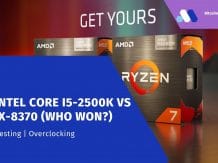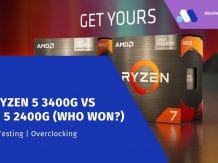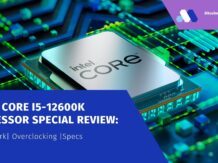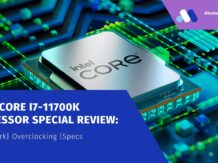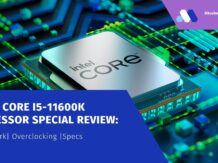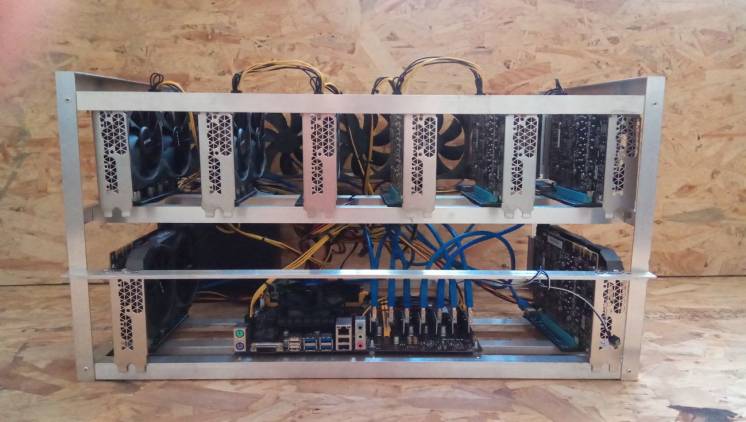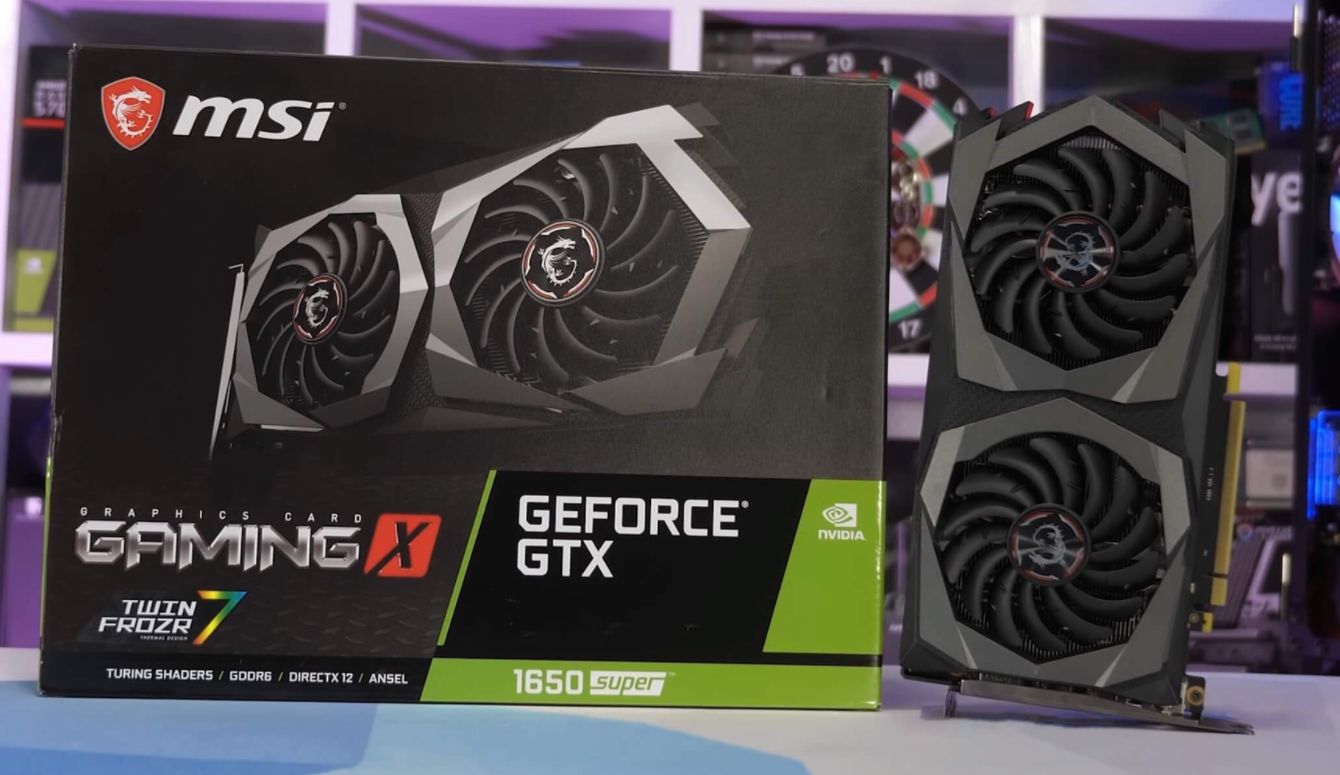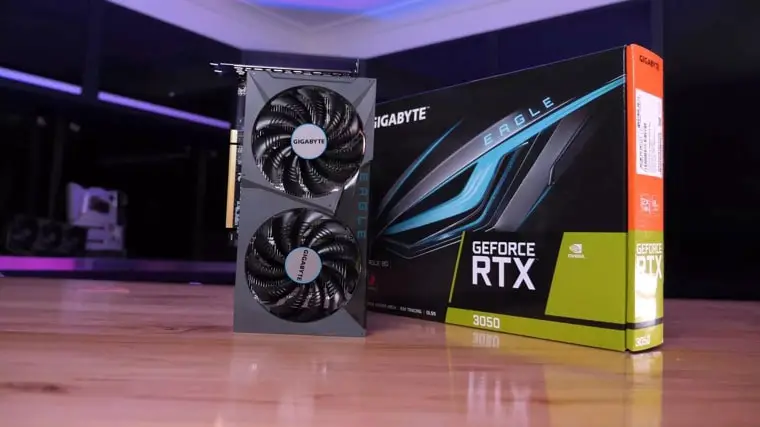AMD Ryzen 5 5600G vs Ryzen 7 5700G: Review/ Benchmark /Overclocking/ Testing – A full test of the processor part and integrated graphics in stock and overclocking.
Hello. Cool thing these your processors with integrated graphics. Is not it? More recently, the Ryzen 5600G and 5700G have appeared on sale. You look at the price – almost the same as the 5600X and 5800X, respectively. You look at the cores – the same ZEN 3. And they say about the integrated graphics that it is at the level of the GTX 1050, which, by the way, now costs 10 thousand on Avito! Solid pluses, but is everything as great as it looks? Let’s figure it out.
Let’s start with a comparison of the graphics subsystem. Here, on paper, there are no changes compared to the previous generation. In the case of the 5600G, we have the same Vega 7 as the 4650G with a frequency of 1900 MHz. Ryzen 7 similarly contains Vega 8 with 100 MHz higher frequency.
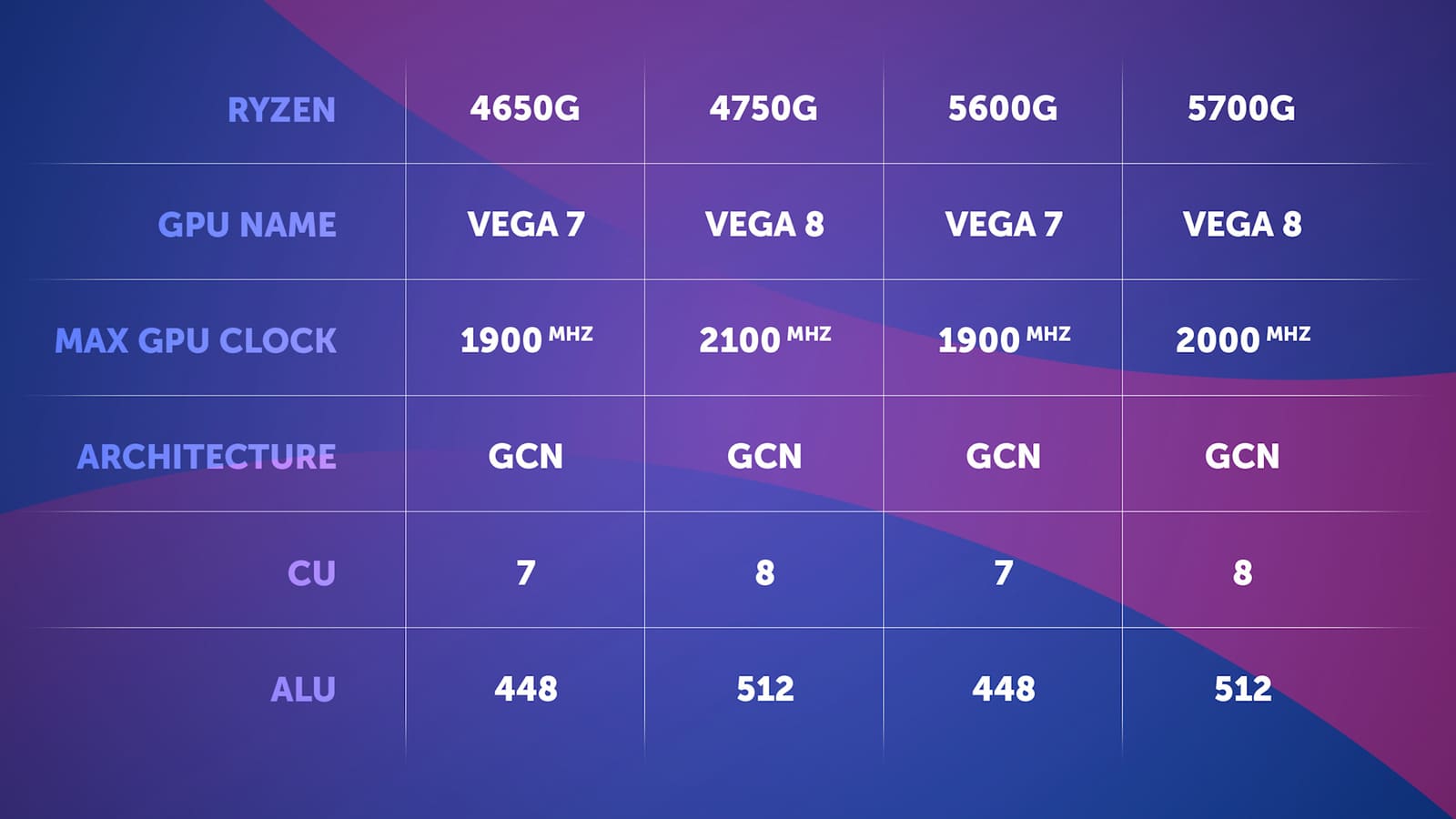
All the changes were made specifically to the processor part, but graphics tests are indispensable, so let’s designate a test bench and rivals. Since the GTX 1050 is heard as an analogue in terms of performance, then we can compare it with it, and with the help of the Ryzen 5 4650G we will check whether there really are no changes.
AMD Ryzen 5 5600G vs Ryzen 7 5700G: Test stand:
- Graphics Card #1: MSI GTX GeForce 1050 2G OC
- Video Card # 2: Palit GeForce RTX 3080 Ti GameRock OC
- Processor #1: AMD Ryzen 5 3600
- Processor #2: AMD Ryzen 5 4650G
- Processor #3: AMD Ryzen 5 5600G
- Processor #4: AMD Ryzen 7 5700G
- Processor #5: AMD Ryzen 5 5600X
- Processor #2: AMD Ryzen 7 5800X
- Motherboard #1: ASUS ROG Strix X570-E Gaming
- Cooling system: Gamer Storm Castle 360RGB v2
- RAM: OLOy WarHawk RGB 16GB (2 x 8GB) ND4U0836163BCWDX
- Storage: Silicon Power Ace A58 1TB
- Power supply: Deepcool DQ850-M-V2L
- Корпус: Open Stand
Stock iGPU benchmarks
Synthetic tests and benchmarks
Let’s start with synthetics, finish with games.
Aida64, GPGPU Benchmark: both on paper and in practice, Vega 7 has identical performance in different processors. The GTX 1050 lags behind the built-in in one half of the tests, and outperforms it in the other.
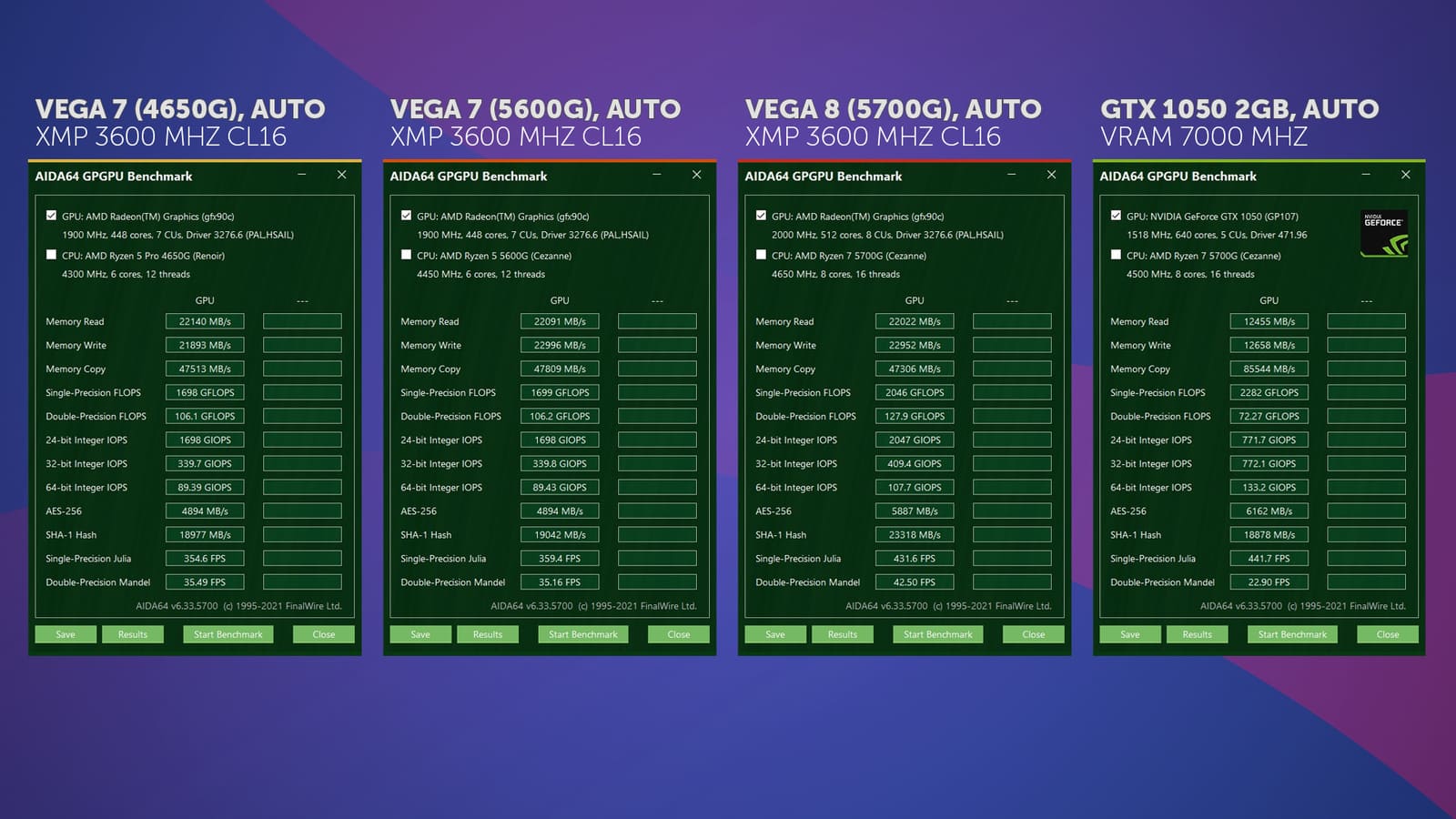
Adobe Premiere Pro, our usual segment with tests lasting a little more than 5 minutes was taken as a project, except that color correction was added. And 1050 is unable to render even such a small piece of the project. When its video memory is full, an error occurs, which has been found on most Nvidia video cards for many years.
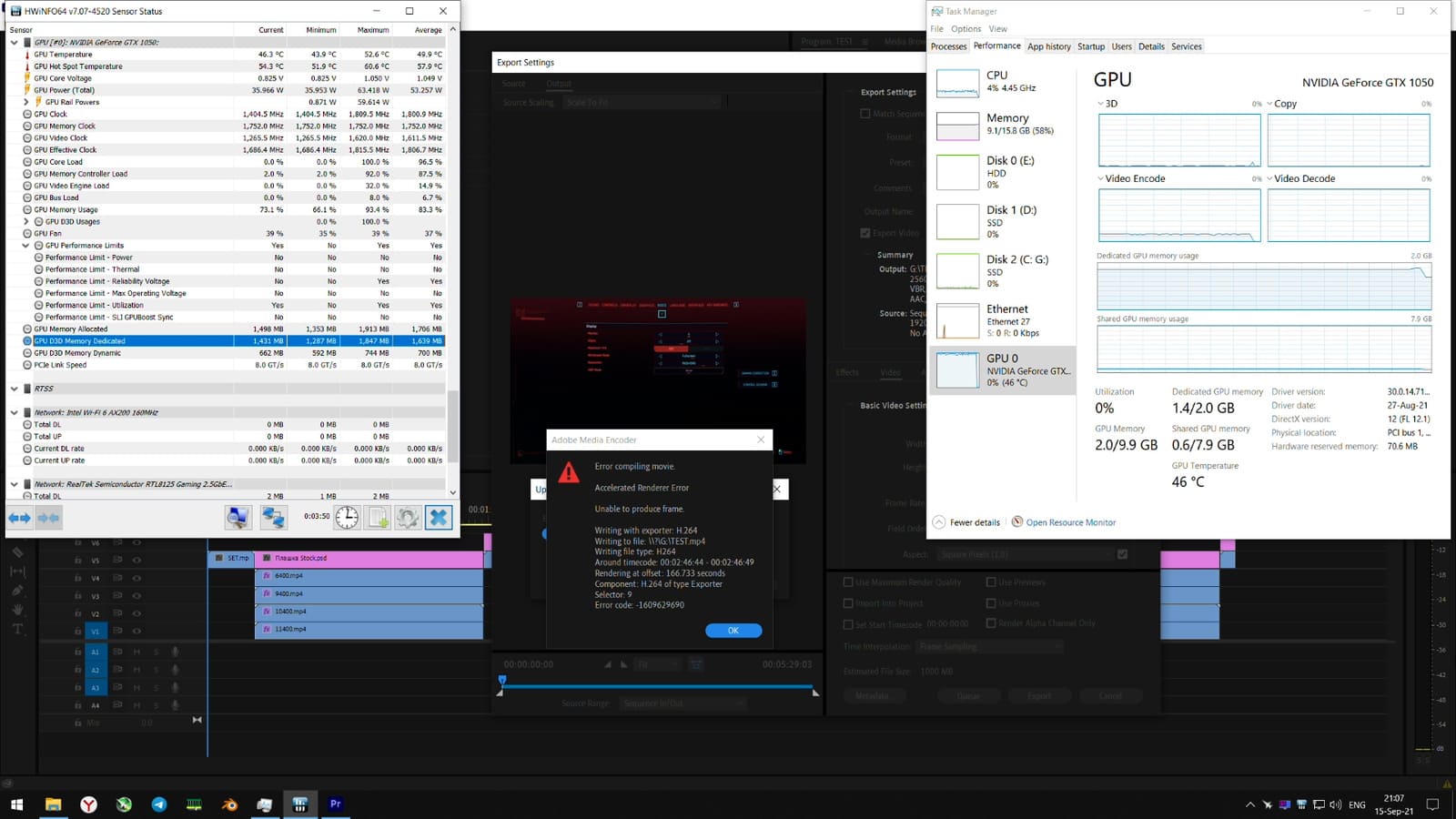
The inserts differ slightly from each other. However, there should be no difference between the first two rivals at all.
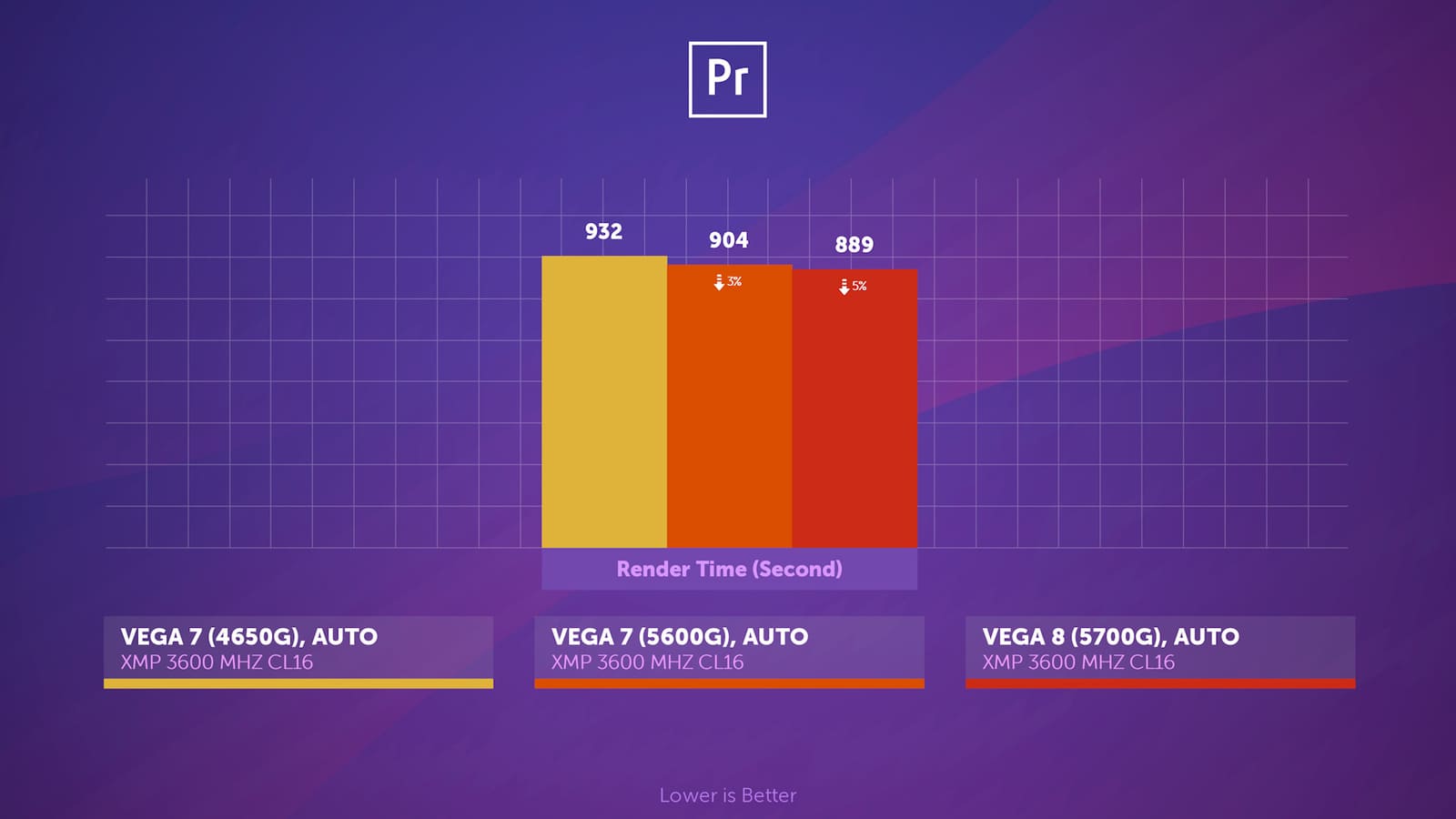
Davinci Resolve 5600G is also faster than 4650G, and the difference between them is stronger than between vega 7 and vega 8 in the modern version. And the latter, by the way, has 14% more cores and their frequency is 5% higher. The GTX 1050 here works like clockwork and demonstrates an almost twofold superiority over vegas.
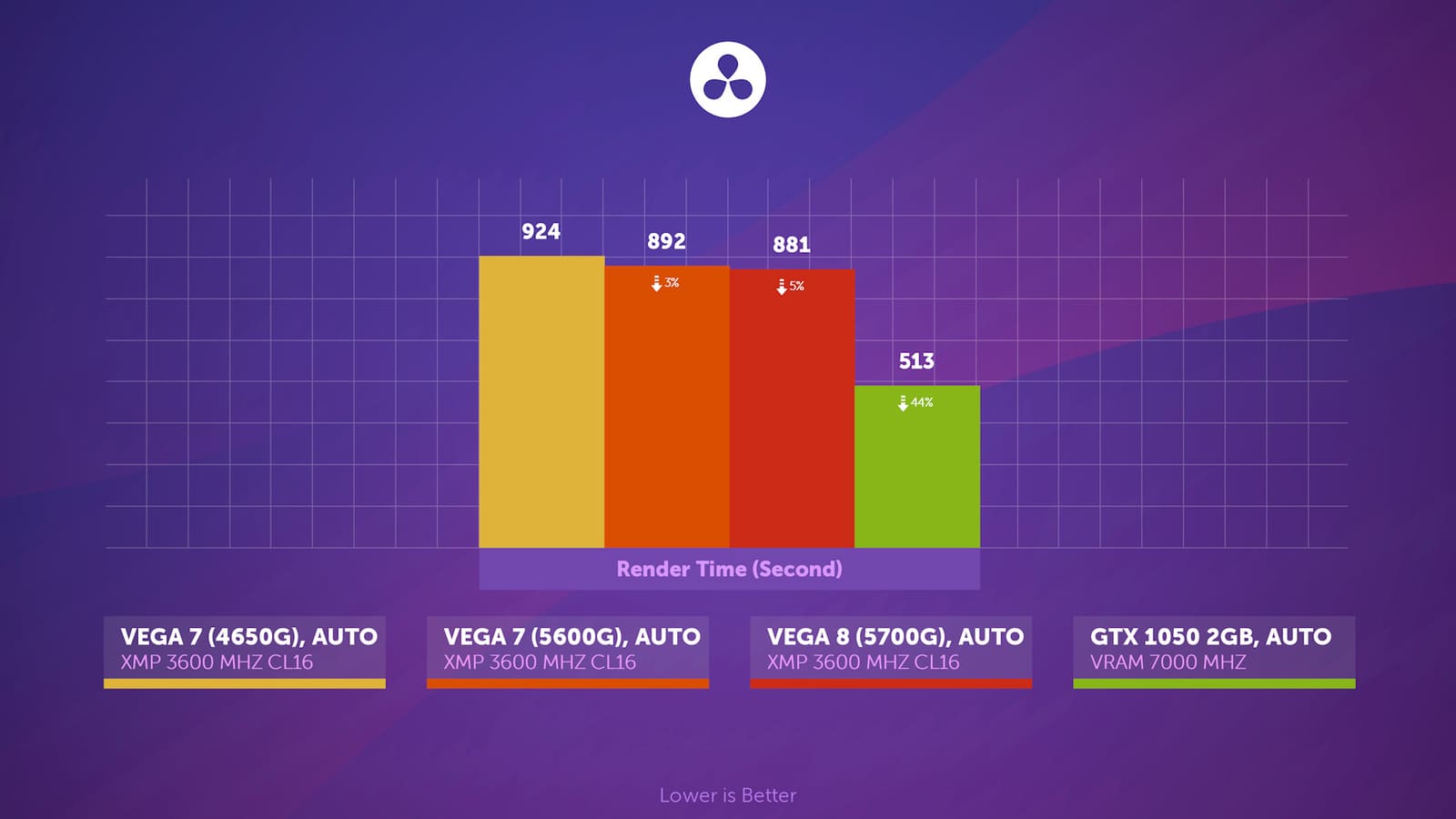
Games
Assassins Creed Valhalla. Graphics preset low, Full HD, resolution modifier 70%, that is, slightly lower than 768p. Recording was carried out by a capture card from a third-party computer without affecting performance. A 2GB GTX 1050 isn’t enough for this game. This is signaled to us in the graphics settings menu, but we do not observe any strong penalty. However, the frametime on the vegs is smoother, although they are worse in terms of average FPS. The 4650G again falls behind the Ryzen with similar integrated graphics for some reason.
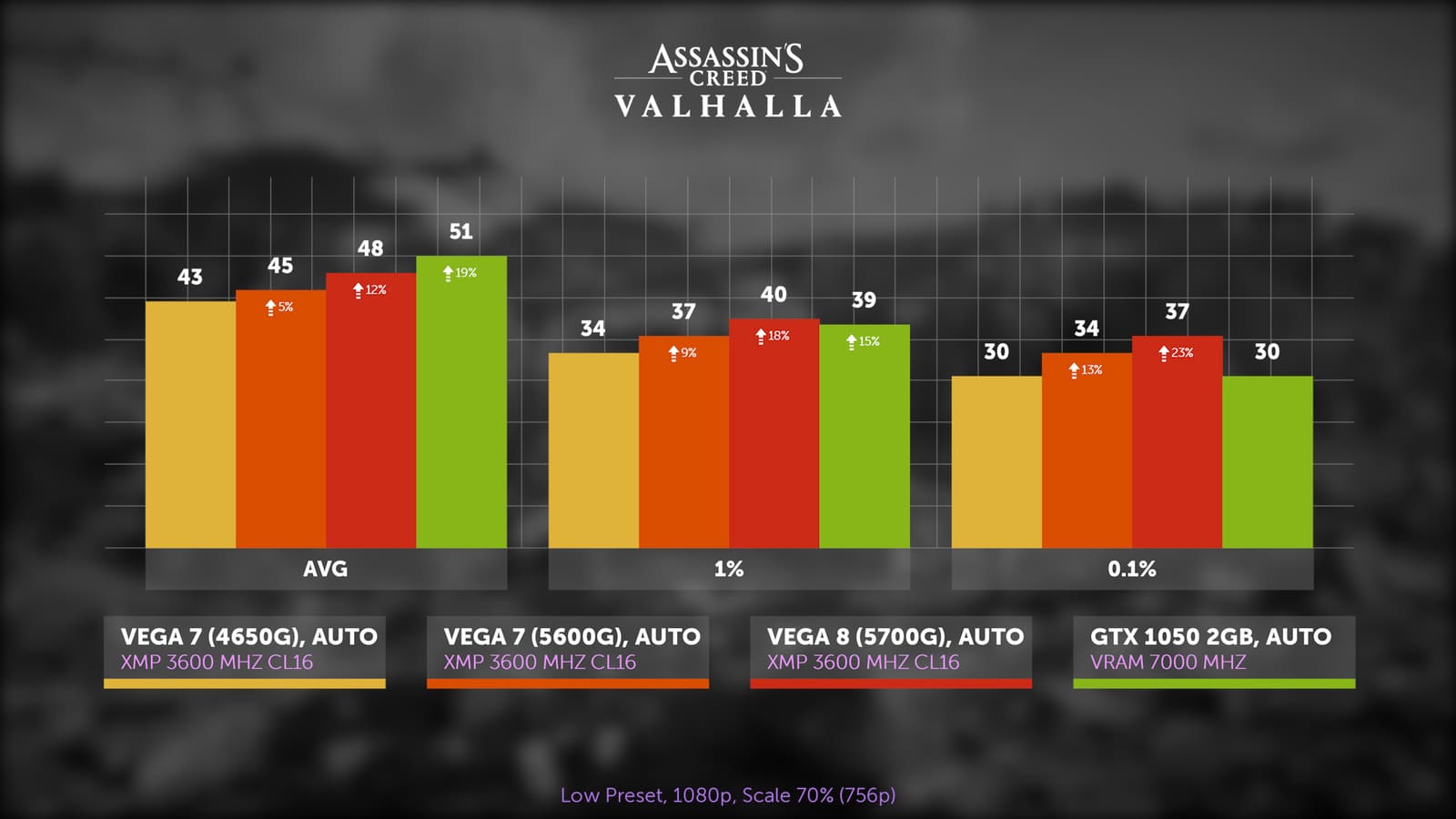
Cyberpunk 2077, also at minimum settings, but the resolution modifier had to be lowered more, to 50%. The final resolution is 540p. Is it possible to play with it? Maybe. Dmitryaga spent 2 hours running through missions, however, with overclocking. You can also increase the resolution by lowering the FPS to console 30, but this is clearly an amateur. There is no noticeable difference between the participants, but we would like to see a greater advantage from the 5700G.
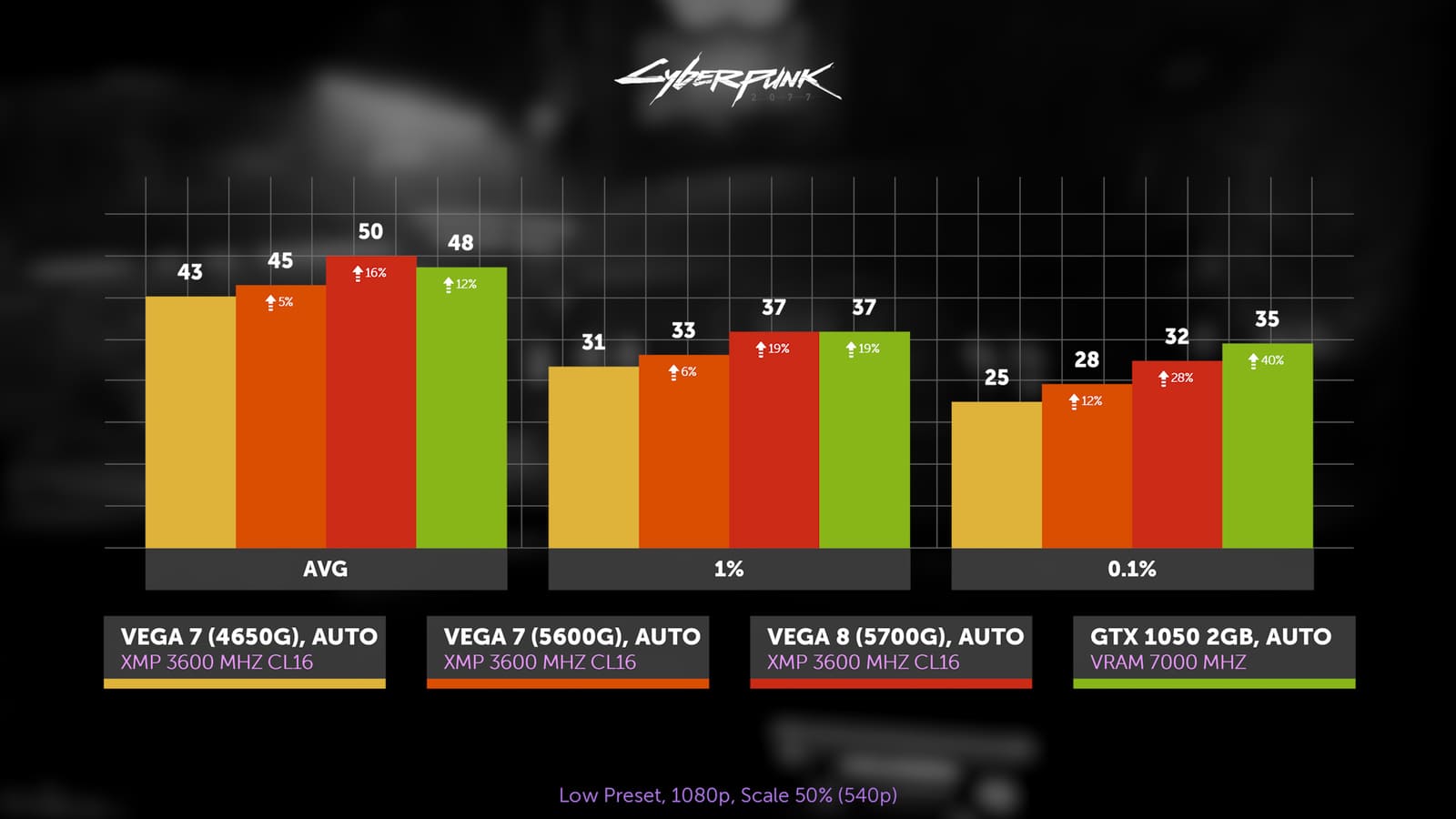
Red Dead Redemption 2, minimums again and ⅔ of 1080p. Here it is analogous to 720p. The resolution modifier cannot be set higher for 1050 without interfering with the config file, since the game signals a lack of video memory. GT 1030 made it clear that this should not be done. As a result, the 1050 breathes deeply and outperforms everyone in average FPS. Vega 7 as part of 4650G for unknown reasons sags heavily in the same areas of the location, and it looks like an incomplete loading of the integrated video core, but the processor part of the 4650G will be able to prepare 40 FPS, so such strange behavior remains a mystery to us.
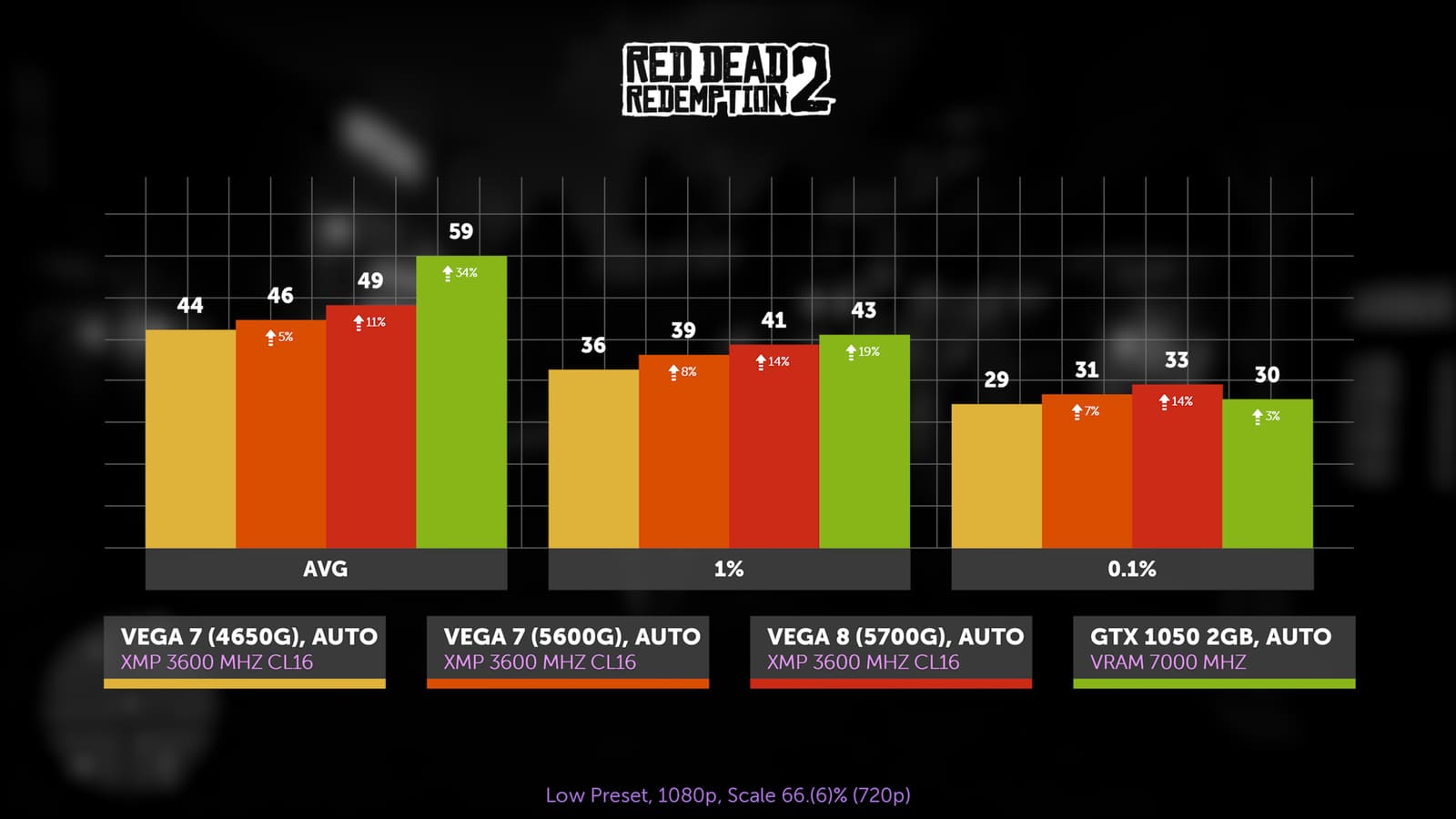
Resident Evil Village, settings at minimum, 1080p, FSR in quality mode. Let’s say right away that the performance of the GTX 1050 is conditional here. Due to the lack of video memory, FPS sags a lot and it varies greatly from pass to pass. And before and after the cutscene, the FPS is 3 times higher. We ran around the locations at the beginning of the game and it turned out that this is not the case everywhere. In some places it is comfortable to play at 60 FPS, but you should look in the wrong place and, voila – already 30. Surely, more complex locations will be encountered further.
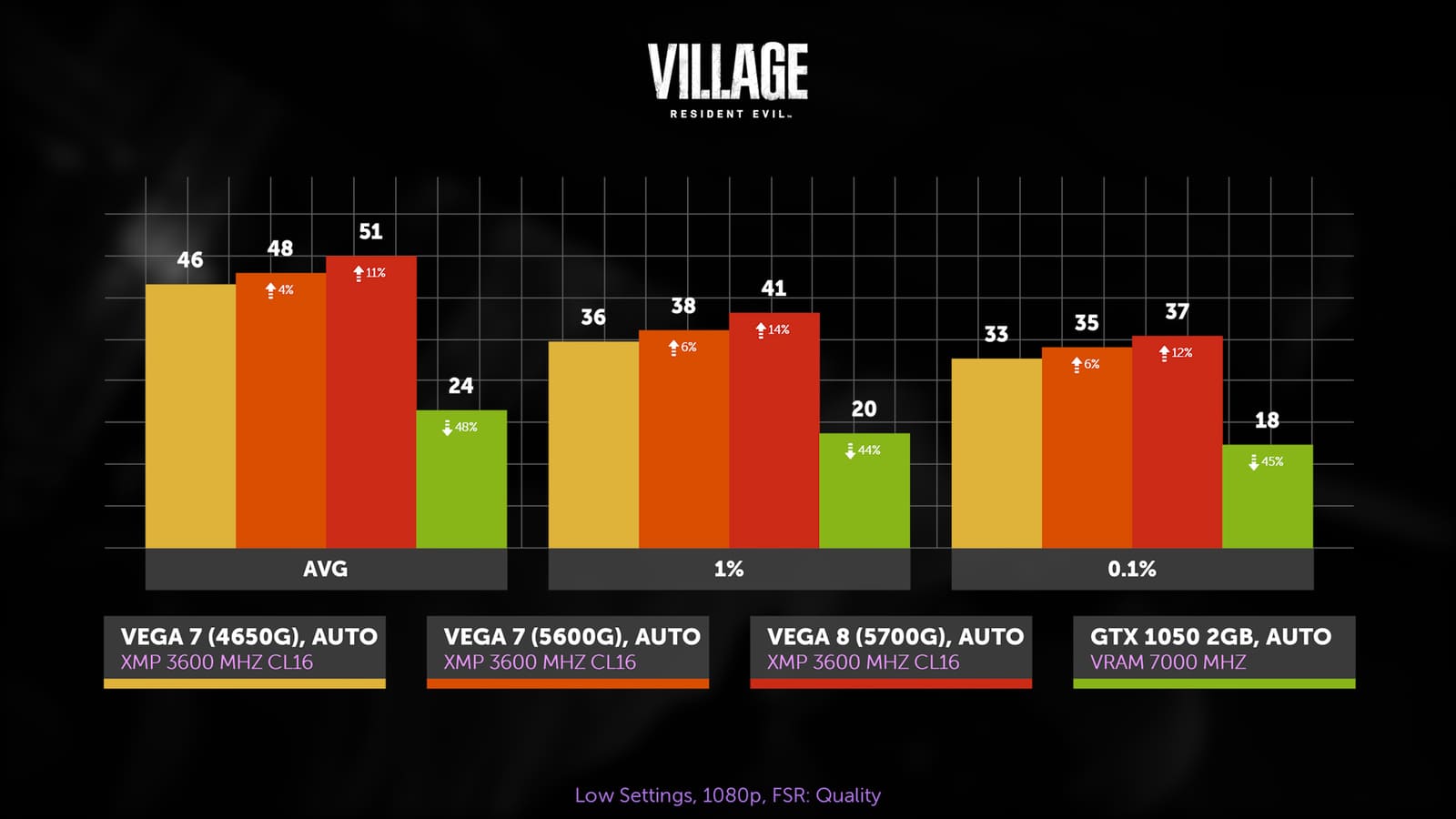
World of Tanks, 1080p, graphics preset high. With tanks, we immediately designate a whole category of games. GTA V, Dota 2, CS:GO – in all of them, the GT 1030 fought on equal terms with the overclocked 4650G. Obviously, the 1050 will lead by a wide margin in them. Therefore, there can be no talk of any analogues. Yes, somewhere the lack of video memory reduces the FPS to the veg level, but somewhere it is much higher, and somewhere lower. Therefore, it is impossible to call the built-in Vega and 1050 analogues.
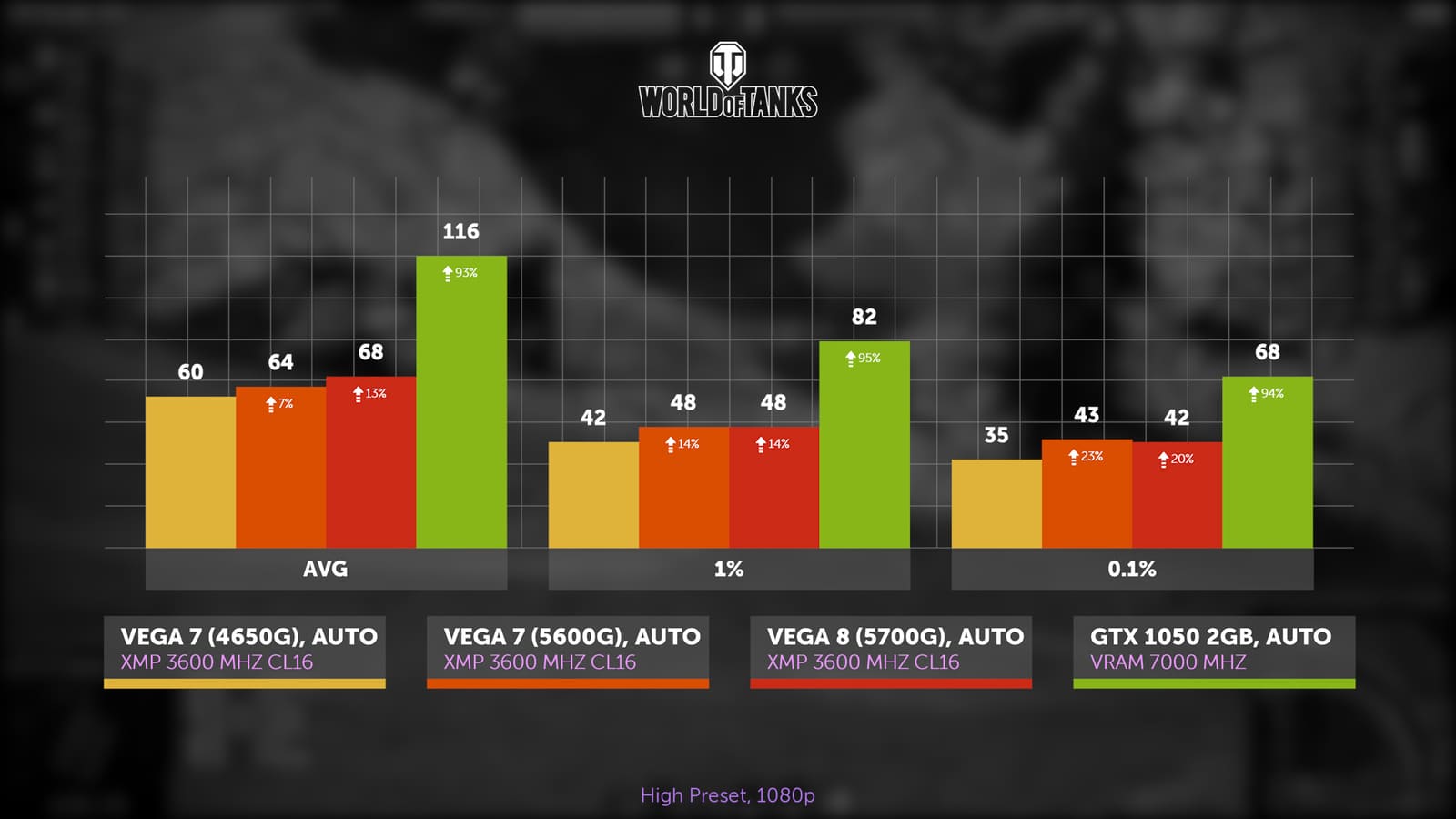
According to tests in stock, it becomes clear that the vegs differ from each other by less than 10%. In general, 4650G and 5600G should not have differed, but, perhaps, the matter is in memory latency. If you look at the results in Hades, then other things being equal, its delays are 10 ns higher.
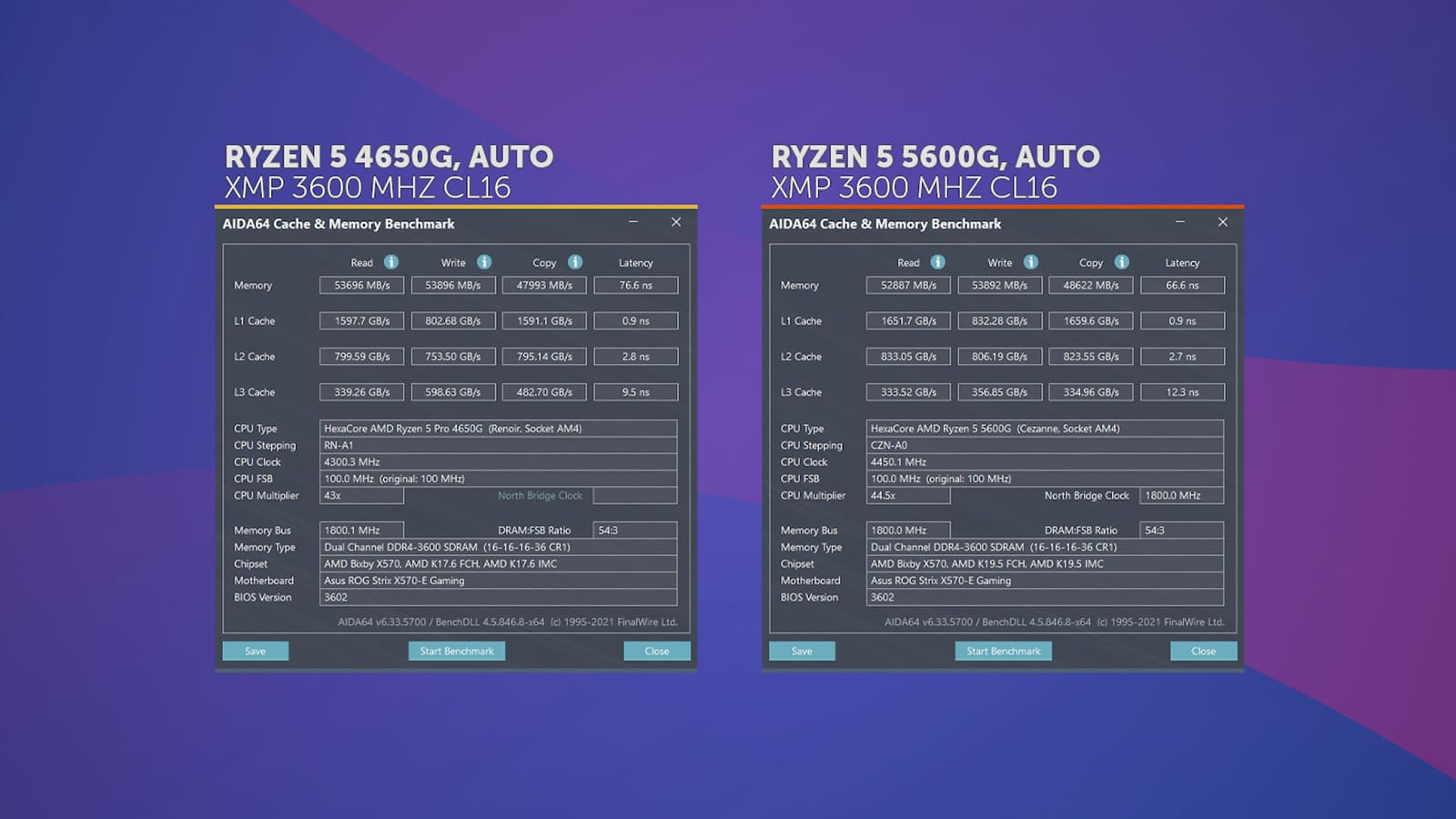
The 5700G’s integrated graphics performance is a little disappointing. With the previously mentioned advantage in the form of an additional block of calculations and a slightly higher frequency, it has very little advantage. The encoder doesn’t seem to have changed either. AV1 is not supported, as well as decoding 8k videos on YouTube.
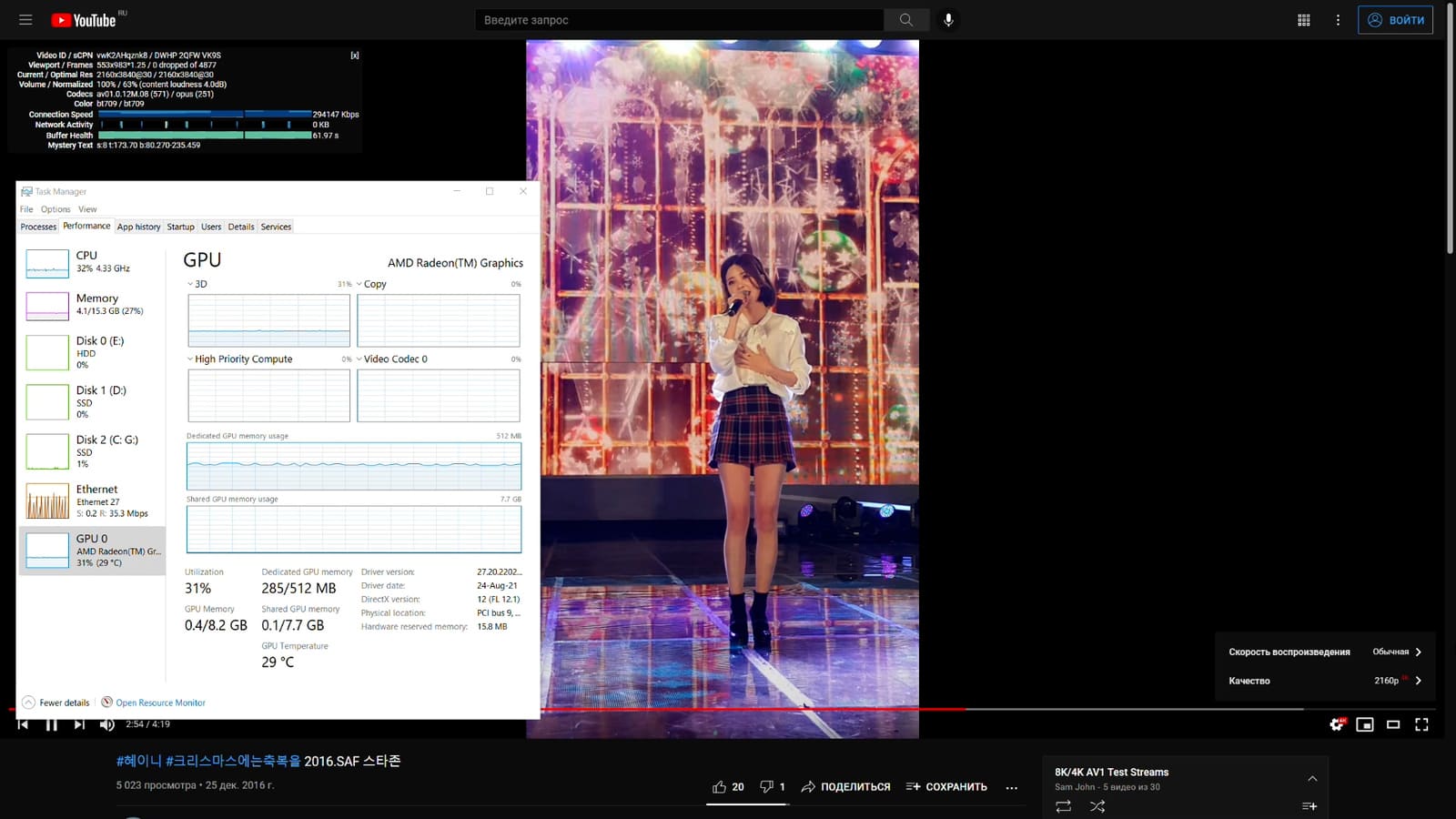
iGPU overclocking tests
Benchmarks and synthetics
Well, maybe slow memory is holding back the potential of integrated graphics? Let’s move on to acceleration.
For the 1050, the usual core frequency offset of 135 MHz was used, and the effective memory frequency allowed itself to be increased by 1600 MHz.
Our overclocked 5600- and 5700G samples are completely identical. 4.5 GHz for cores at 1.3v, 4533 MHz for memory with the first timing of 16, even the integrated video core conquered no more than 2300 MHz in all cases. Moreover, the 4650G also has the same built-in overclocking. The new generation did not please with a large overclocking potential. Unless in terms of cores and memory, the old generation had worse results. The frequency of the processor cores at the same voltage is 4.25 GHz, and the memory cannot be driven above 4333 MHz.
Yes, in case anyone missed it, APUs have two memory controllers that allow you to work with a 1 to 1 divider up to 4600 MHz in the case of the 4000 series, and with the 5000 this limit is even higher. So why did we stop at 4333 MHz if the memory and motherboard are definitely capable of more? The point is the voltage on the SoC. For hybrid processors, its relatively safe limit is higher than that of conventional processors, but there are no clear boundaries. In the case of 4000 ryzens, we decided for ourselves not to set higher than 1.2v; for the 5000 series, by analogy with conventional processors, where the limit has shifted upwards – 1.25v. Also, the overclocking of the graphics core directly depends on this voltage, so the monitoring shows exactly the voltage on the SoC, and not the GFX.
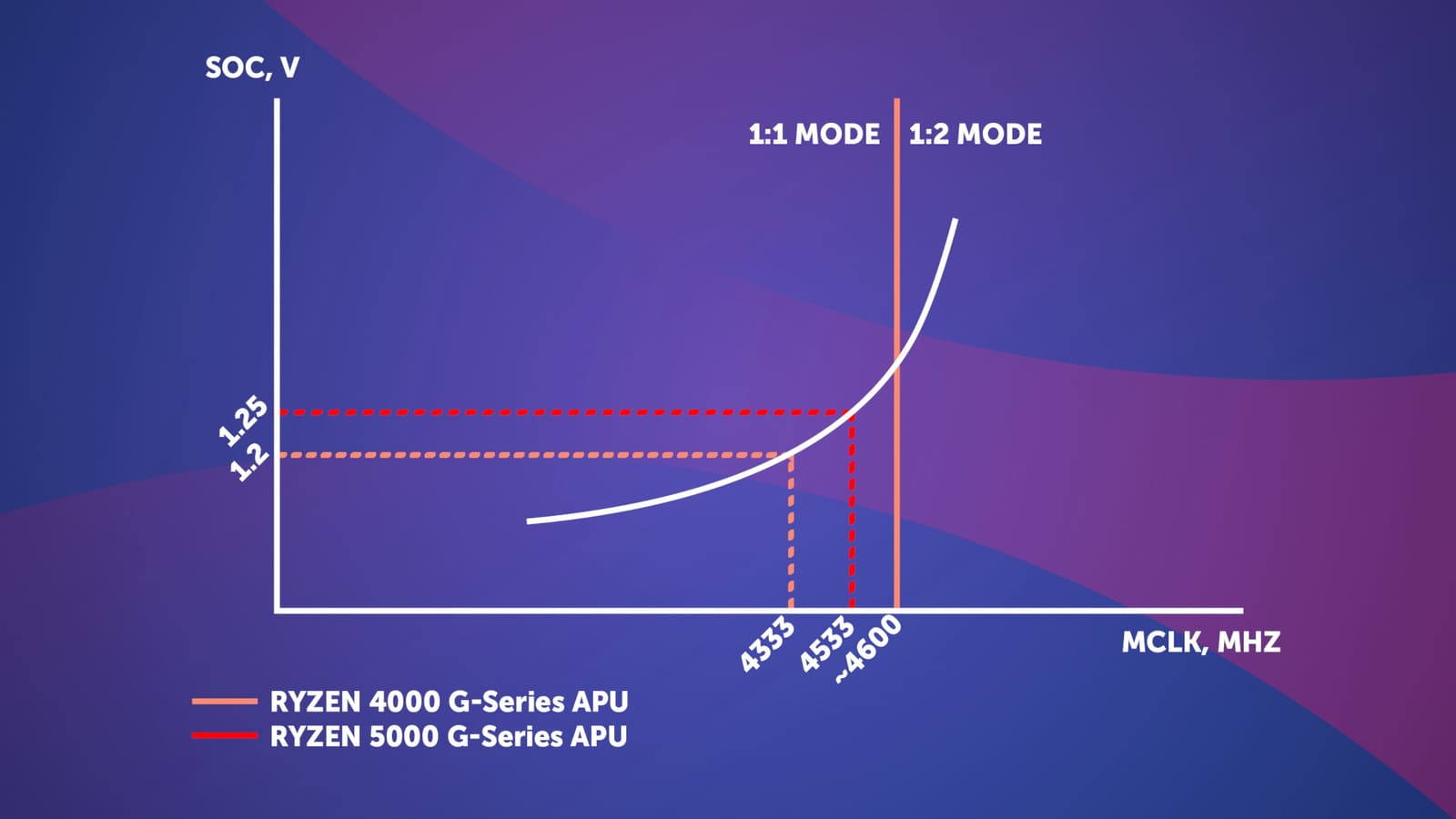
Again we turn to Aida64. Only the first three memory measurements show a slightly higher overclock in the case of the 5600G. In other disciplines, there are no differences from the 4650G again.
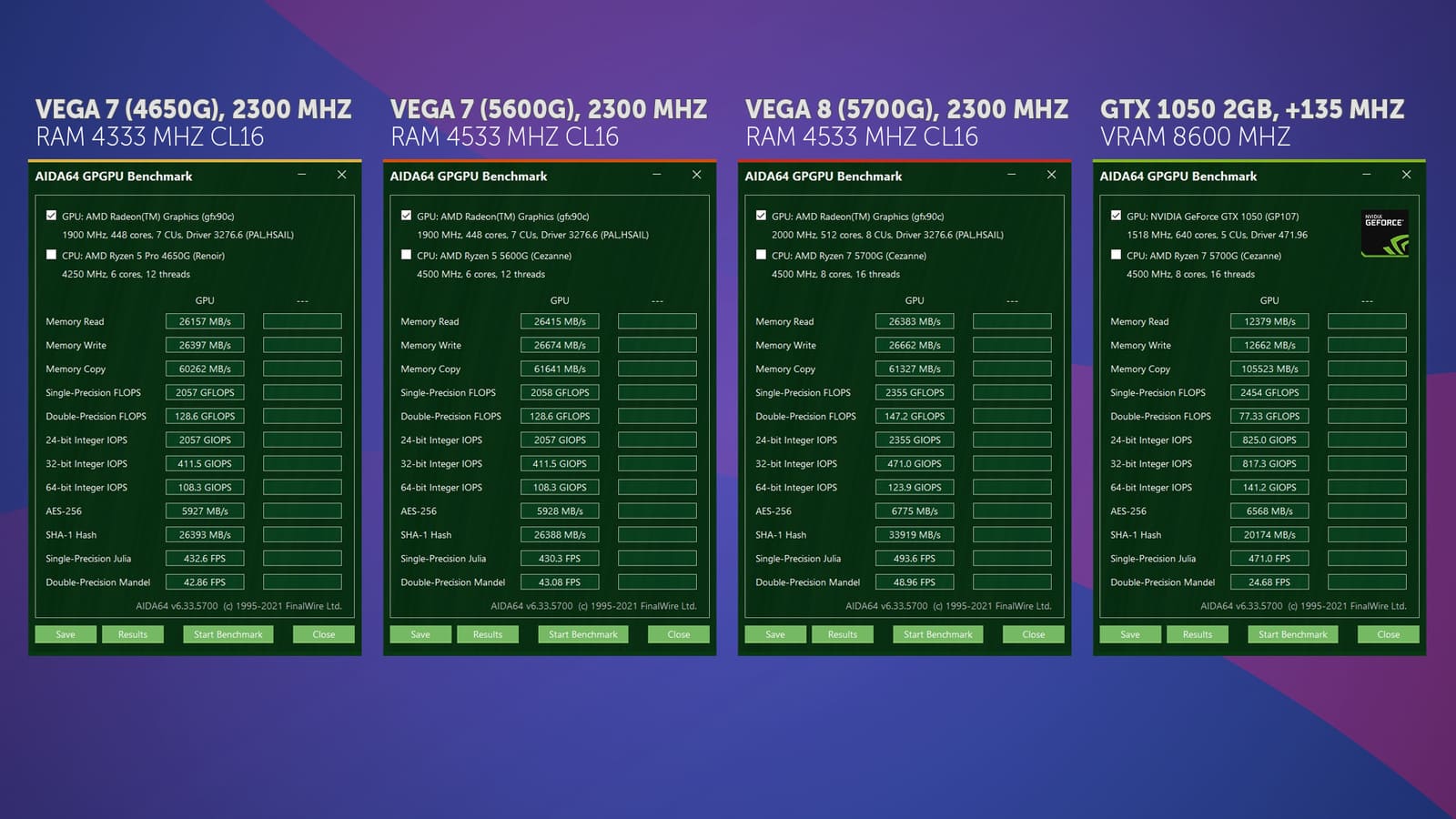
Scene rendering in Premiere Pro sped up by 28-30%. Naturally, overclocking 1050 did not help to get rid of errors. It is said that switching to a different video format in the render settings menu can help.
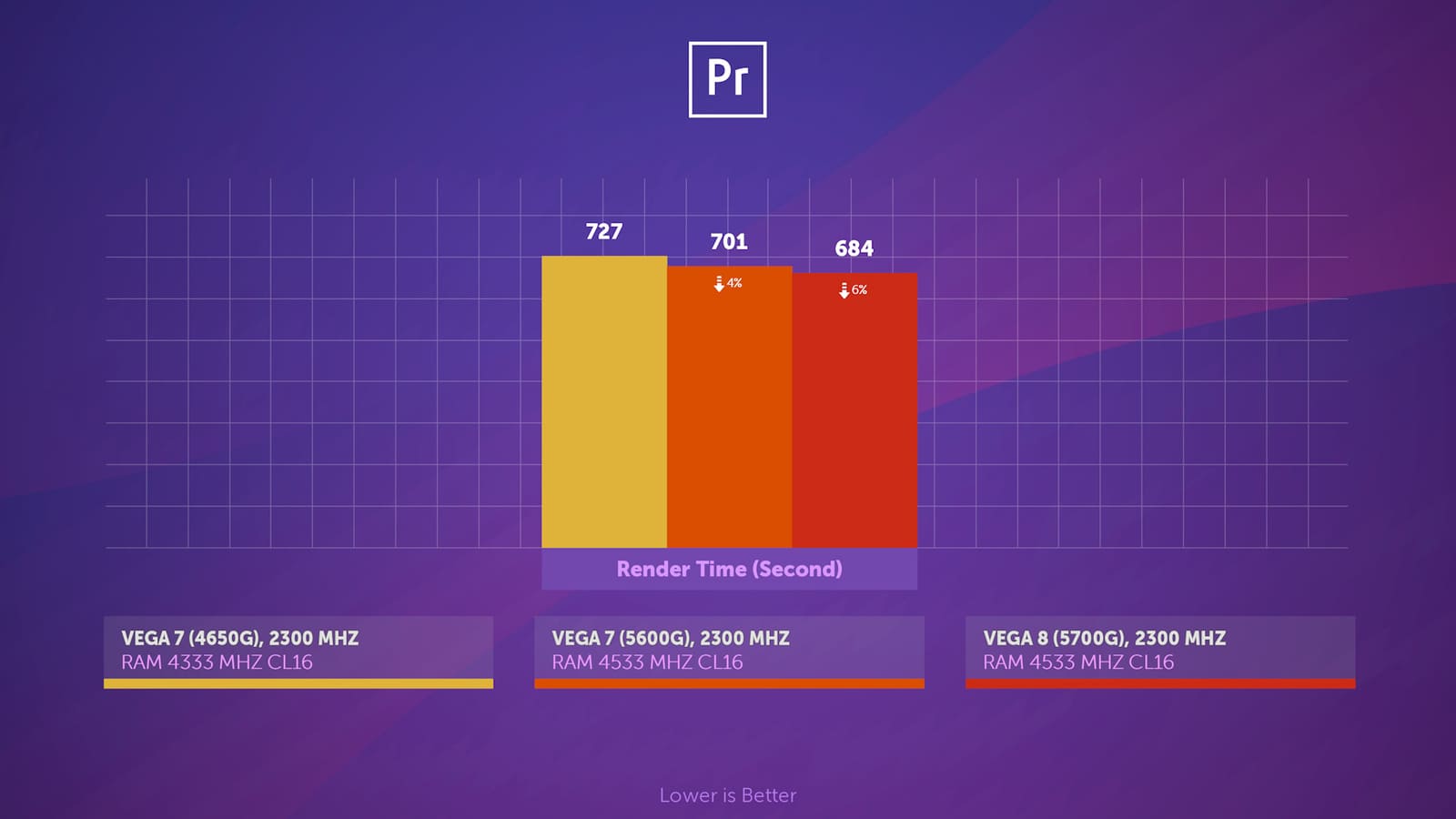
In Davinci, overclocking gave approximately the same results for vegs: + 30-31%. The growth of 1050 pleased – 17%. In terms of gaming, the overclocking of discrete video cards has not been impressive for a long time, even 10% can not always be squeezed out with standard cooling, but here it is 17.
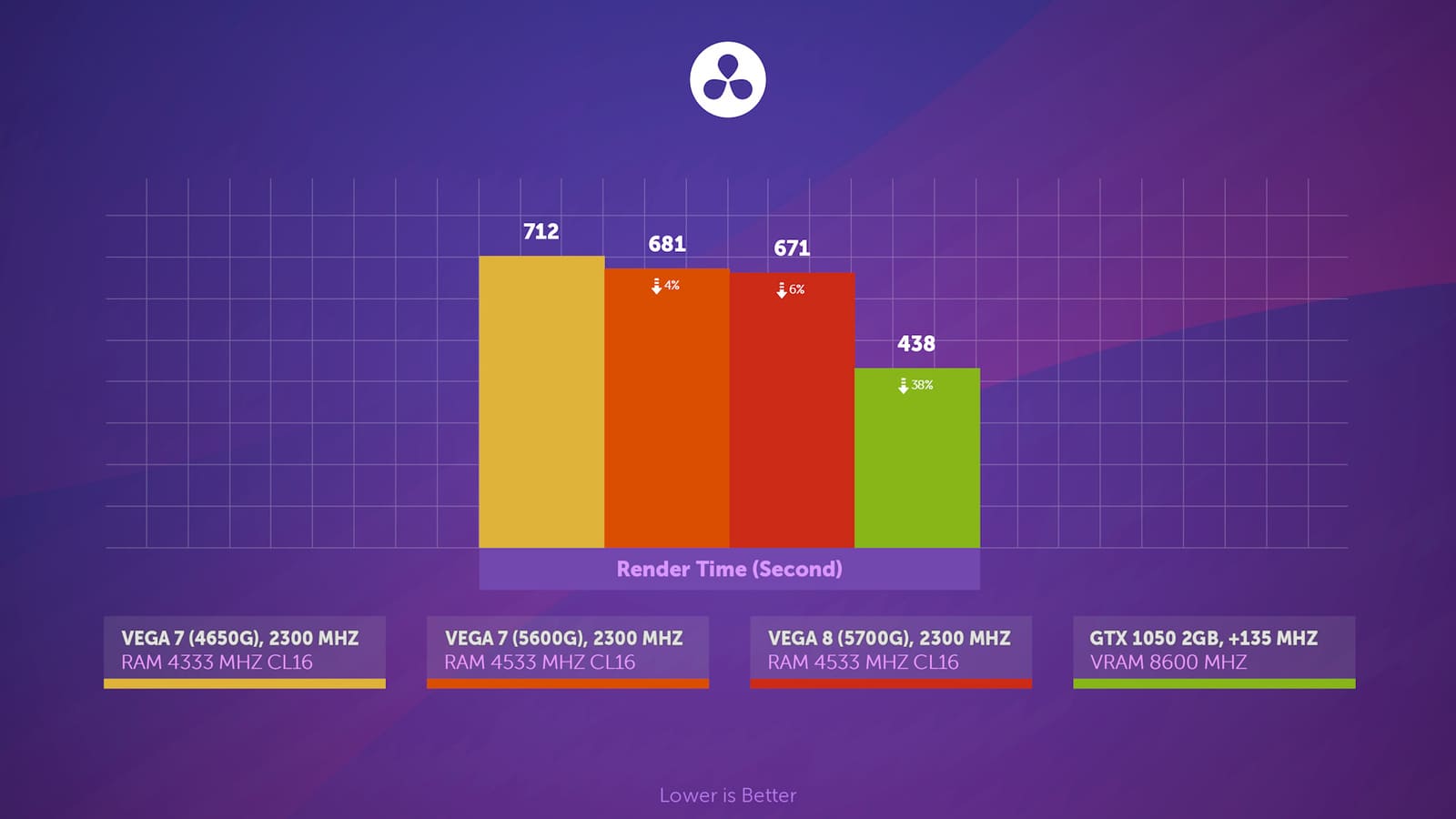
Tests in games
There is a nice picture in Assassin. Namely: the coveted 60 FPS, obtained through overclocking, which gave more than 30% additional frames. It was on this basis that the graphics settings were chosen. Myltso, but smooth.
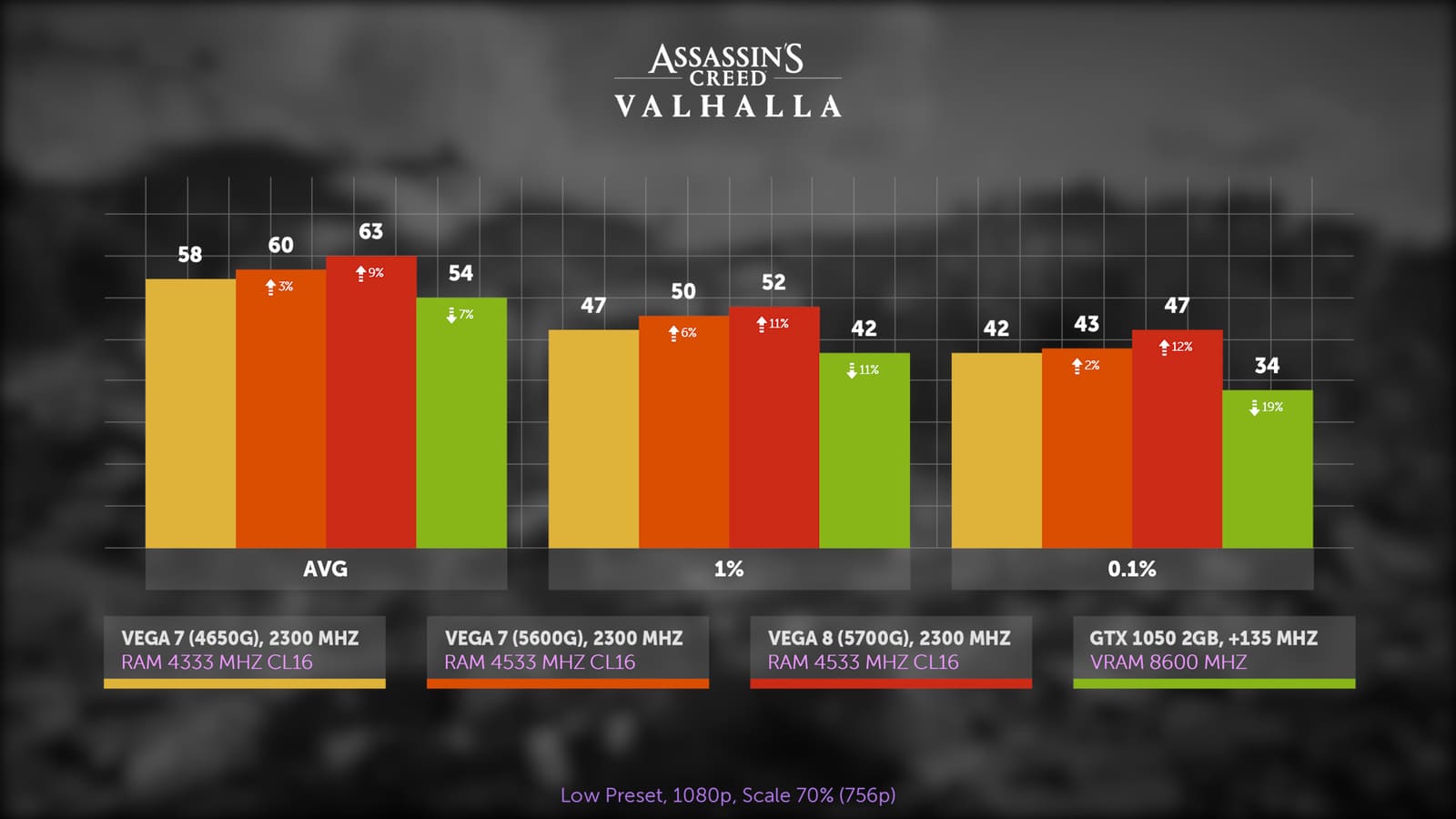
Also in cyberpunk. It is difficult to see the enemy, but if you see it, aiming is not a problem. The frametime is quite even, however, stutters occasionally slip through the vegs. By the way, we have not touched the setting of allocated memory for integrated graphics. By default, 500 MB is provided, and remember – almost a year ago, during the test of the 4650G with such a volume, small stutters constantly appeared with a constant frequency? Maybe they fixed it with a new driver, maybe with a BIOS, but now they are gone.
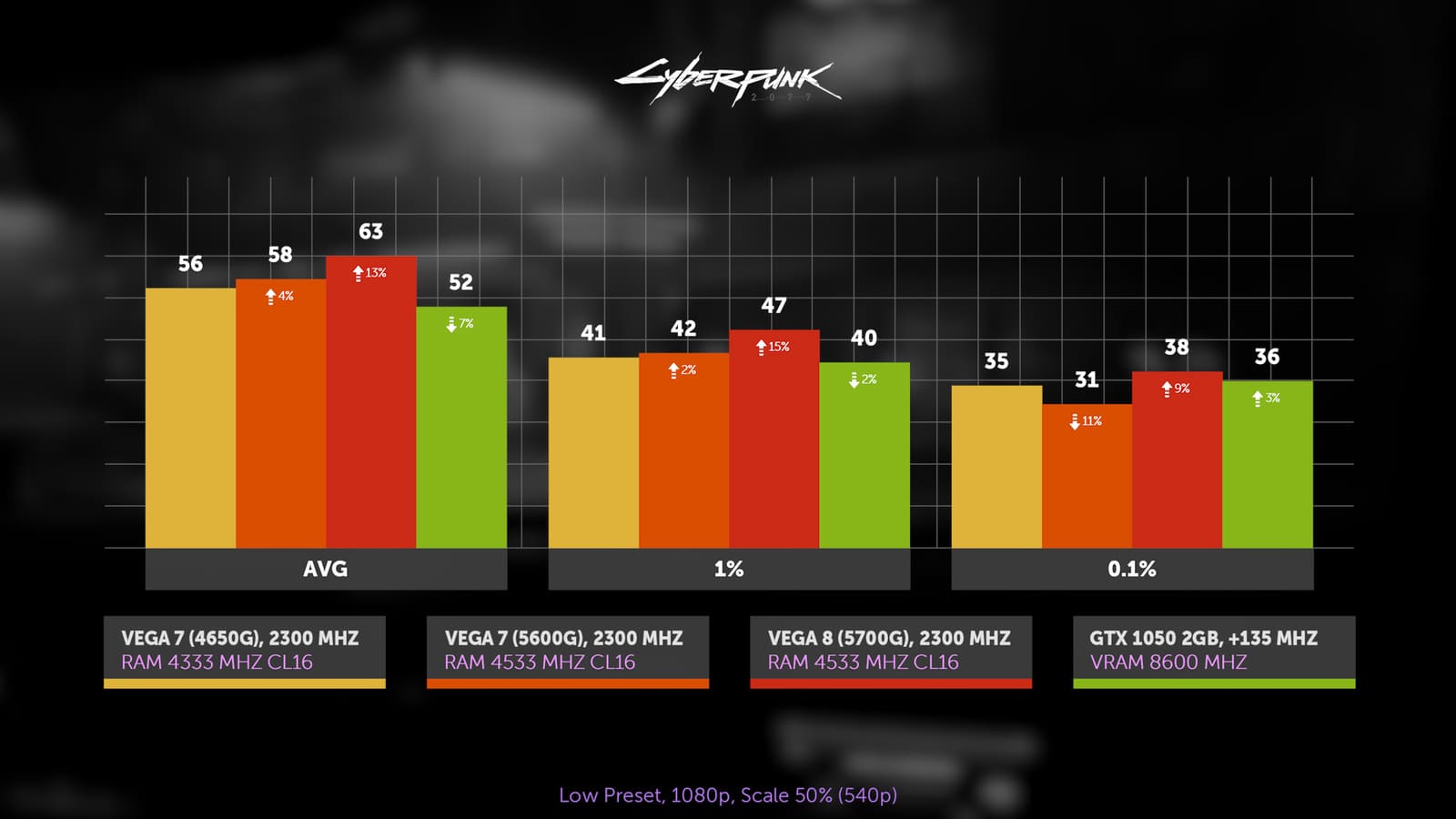
In RDR2, you can also get 60 FPS by spending time on overclocking and sacrificing resolution. Now imagine that all these games have Fidelity Super Resolution, which allows you to noticeably improve the picture. Craftsmen have already learned how to fasten it to most games, and not only to them. But if they can, then why not developers?
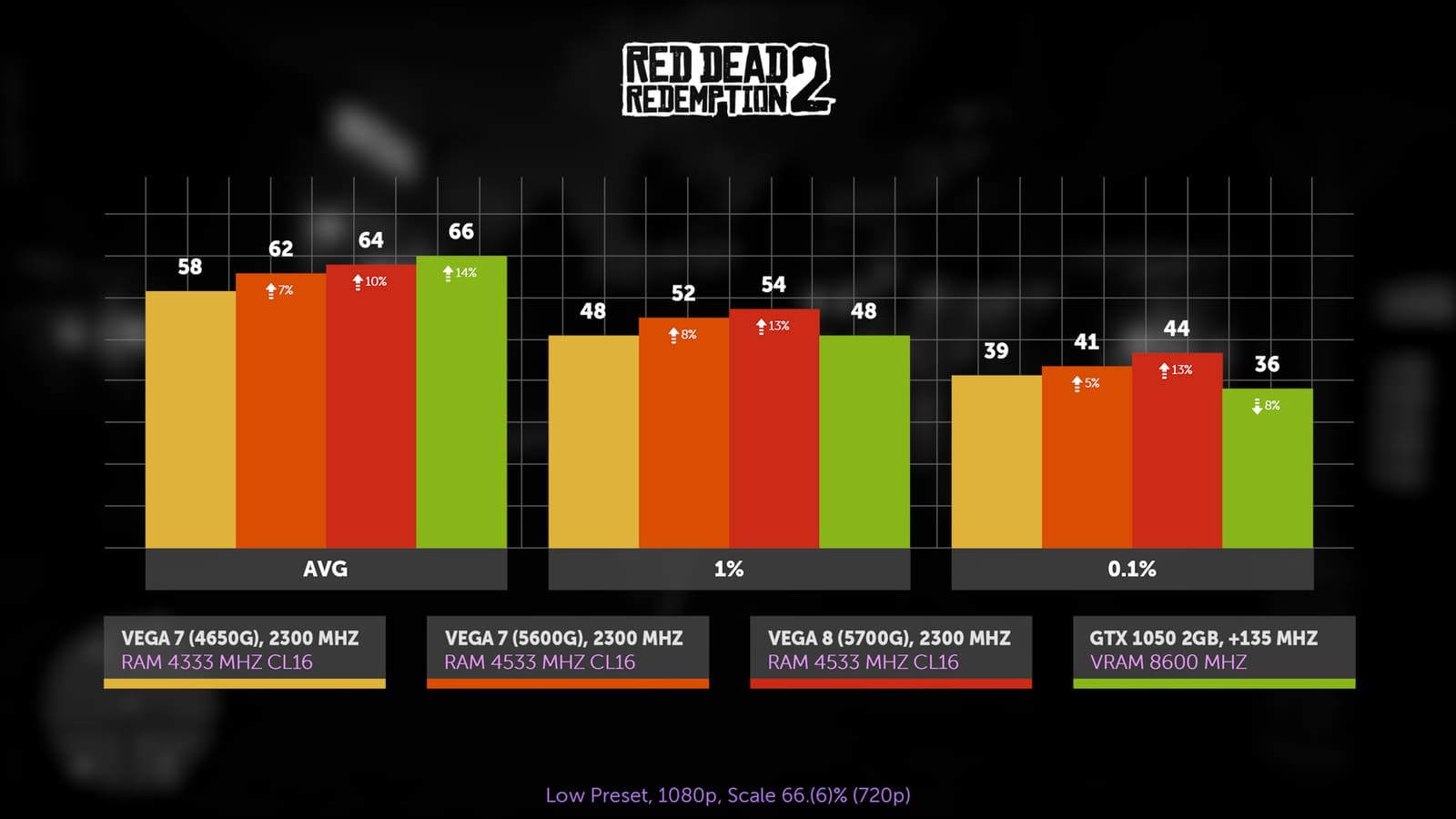
There is an FSR in the resident, and thanks to it, the clarity of the image does not suffer much, and the FPS is pleasant. And we don’t need more. With overclocking in all games, obviously, the scales have shifted. The 1050 has lost its weight, because the gain from its setting simply pales in comparison with that of the APU. On average, the seventh vegs increased their performance in games by a third. For Vega 8, the increase turned out to be slightly less, because. in stock, it had a higher video core frequency.
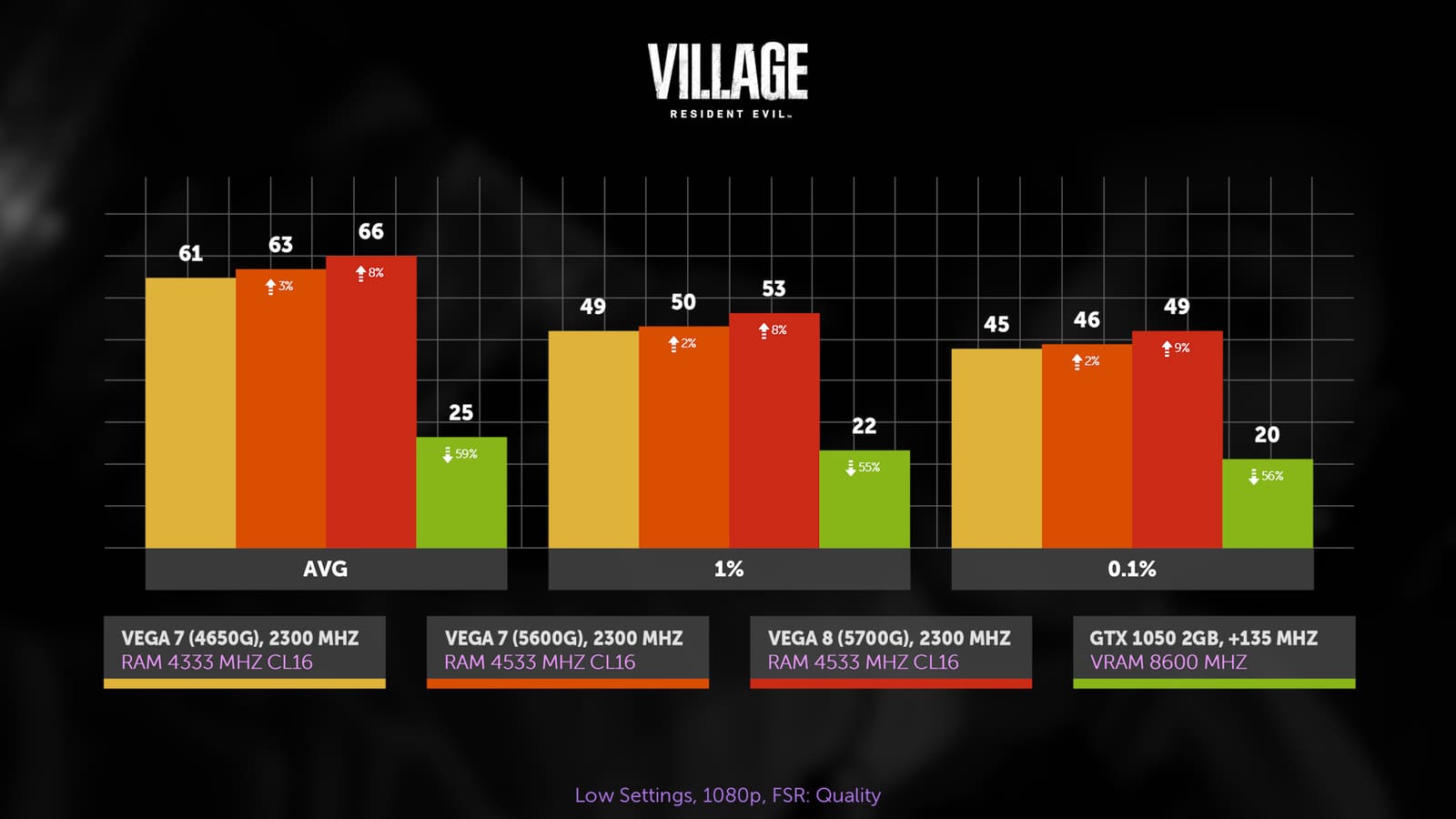
In tanks and similar games, 1050 has not lost its lead. No amount of overclocking will help here. So let’s fix it again. For modern AAA games, embeds are better suited. Their microarchitecture performs well in modern APIs, and the absence of a video memory penalty allows you to increase one of the most noticeable graphics settings – texture quality. The main thing is that there is enough RAM. However, if your goal is to get more FPS in stale online toys, then 1050 will suit them much better.
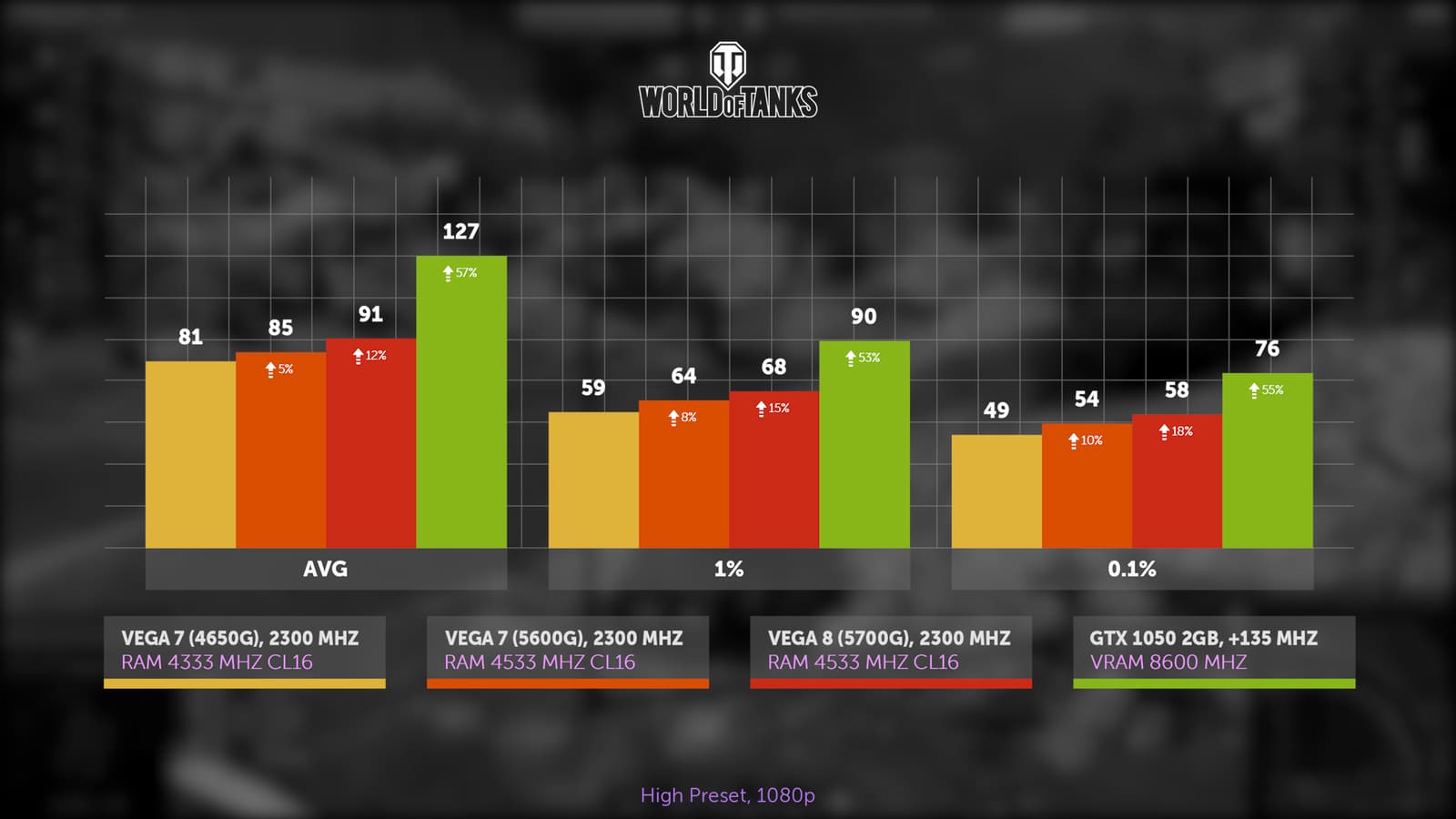
You can also add Geforce Experience to its advantages. In addition to many filters, it can record gameplay in excellent quality with a slight loss of performance.
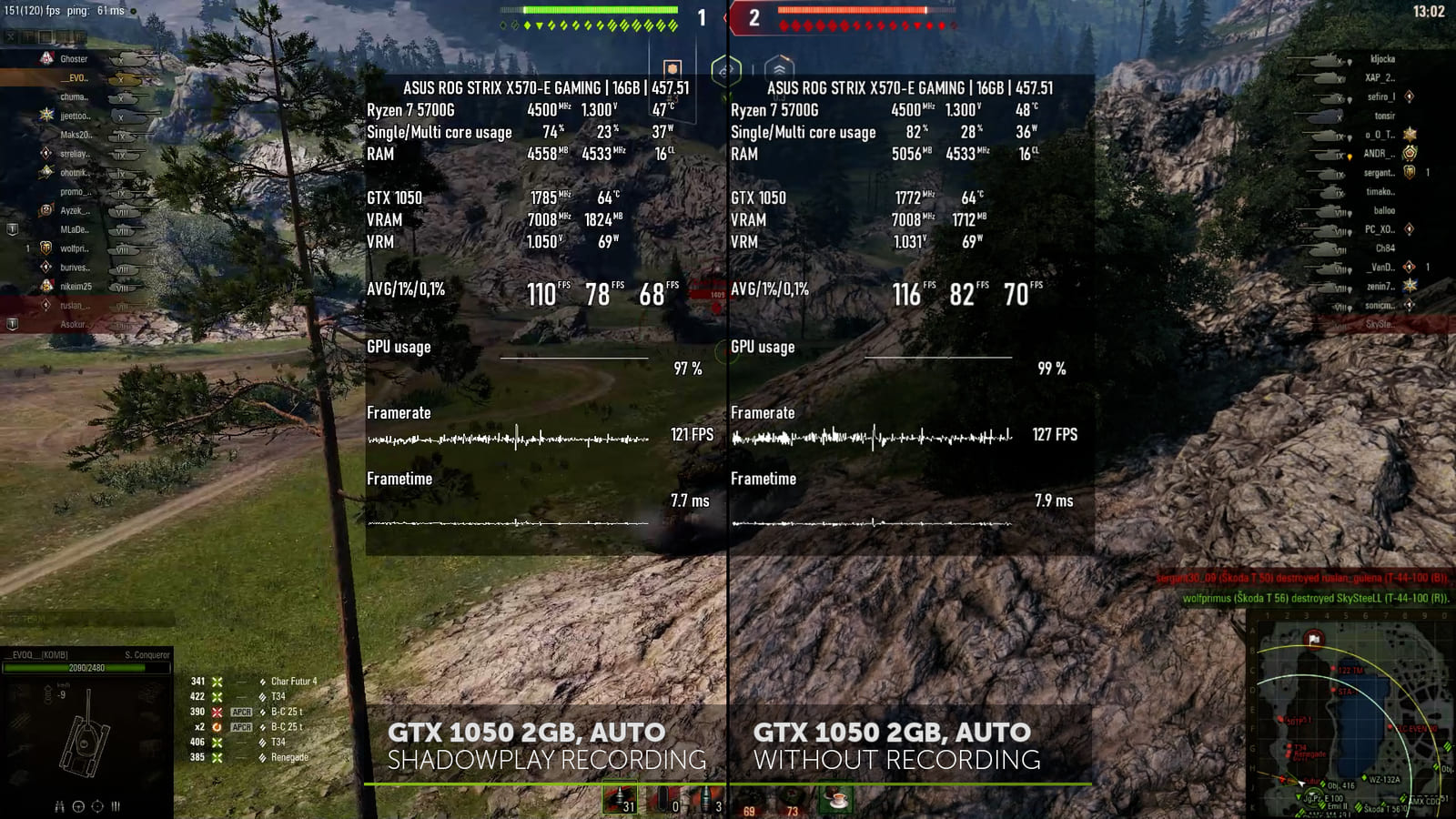
For embedded Radeon Relive is not available, although they can encode video. And the same OBS during the game can record gameplay with skipping frames, plus the performance drops a lot. It’s not a fact that it will come out to set it up properly, while in the proprietary software I pressed the button and the recording started.
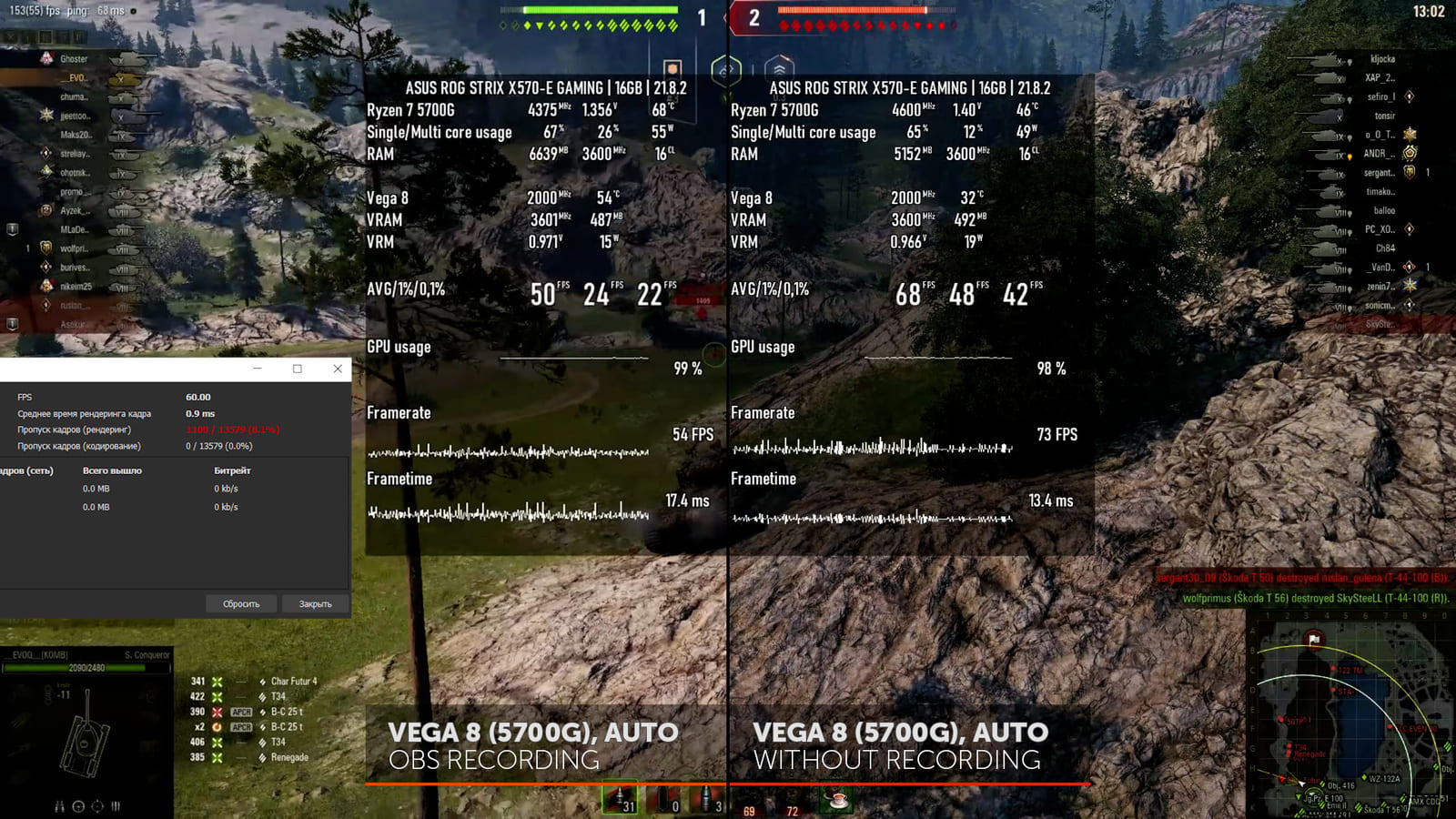
We study the processor part
Again, Vega 7 and Vega 8 are not very different from each other. An overpayment of about 8 thousand rubles for the 5700G does not look justified, but we also have a processor part that has undergone much more changes. So what’s new in it?
The slide from the presentation does not quite reflect reality. For example, the maximum frequency is 50 MHz higher than stated, and 65 watts is clearly not the consumption that you will encounter, because PBO is enabled by default.
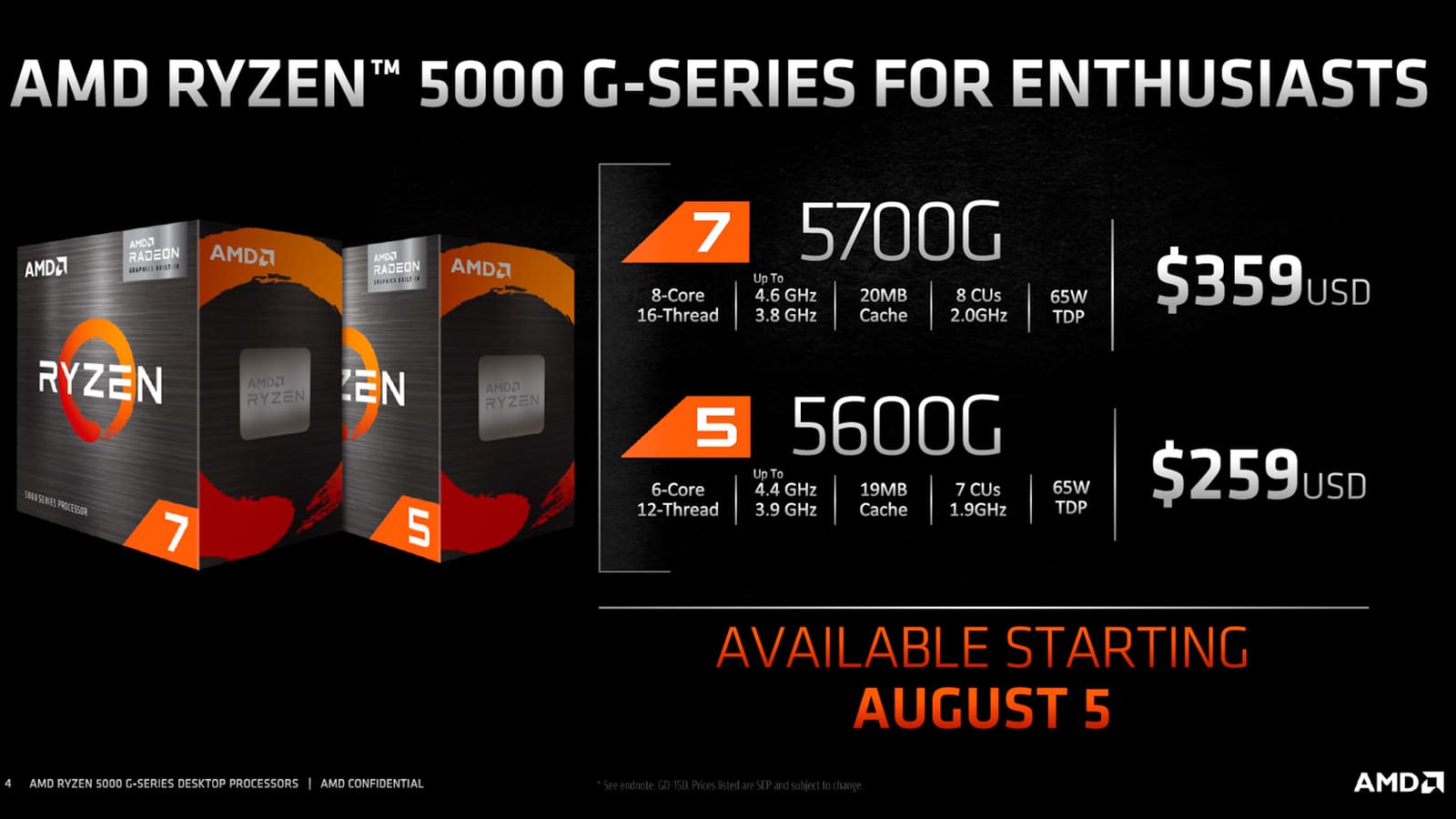
In our case, when using a discrete graphics card, both processors consumed about 80 watts in a stress test with peaks up to 84.
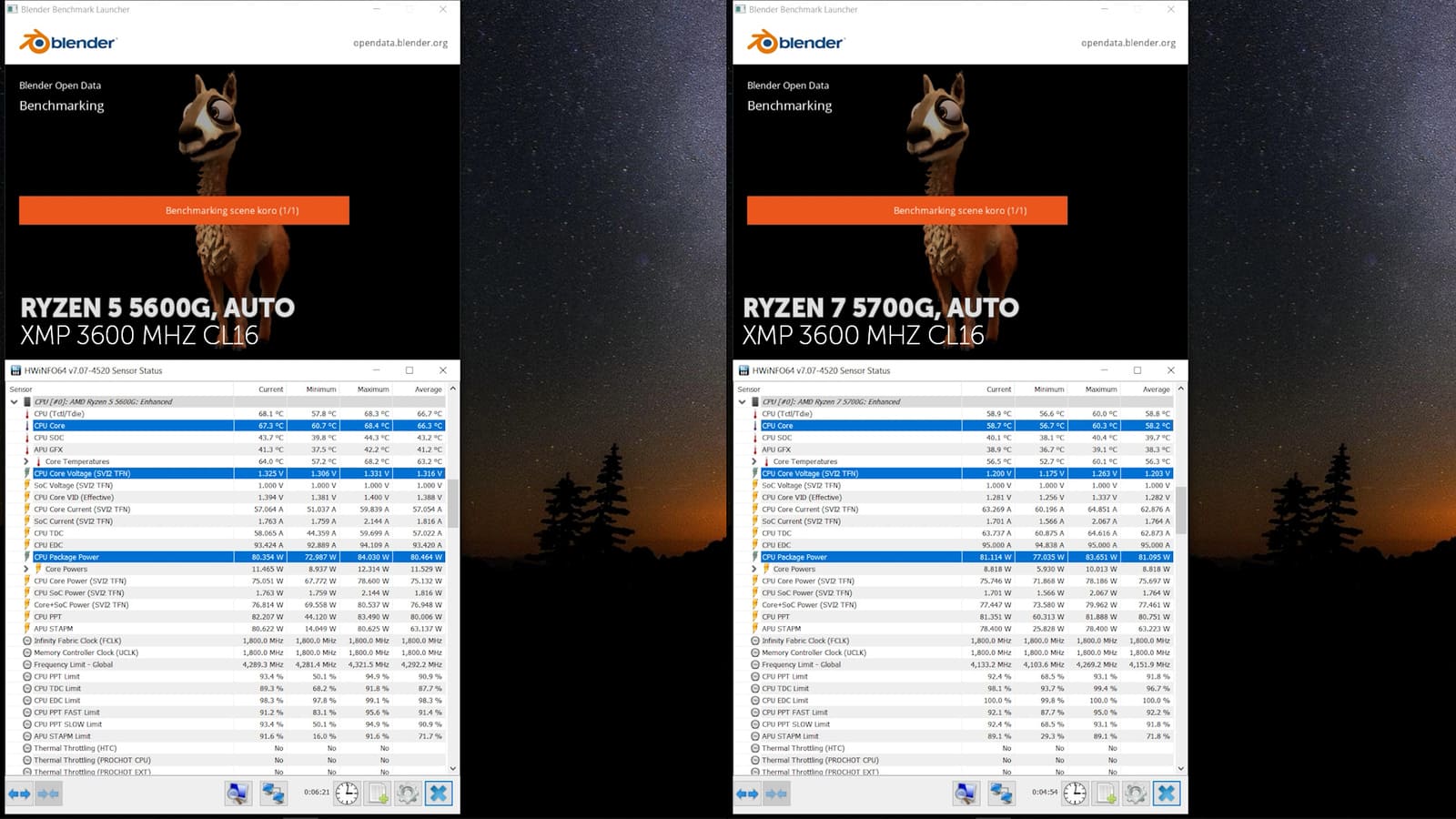
With a simultaneous stress test of the processor and graphics cores, up to 90 watts will be allocated.
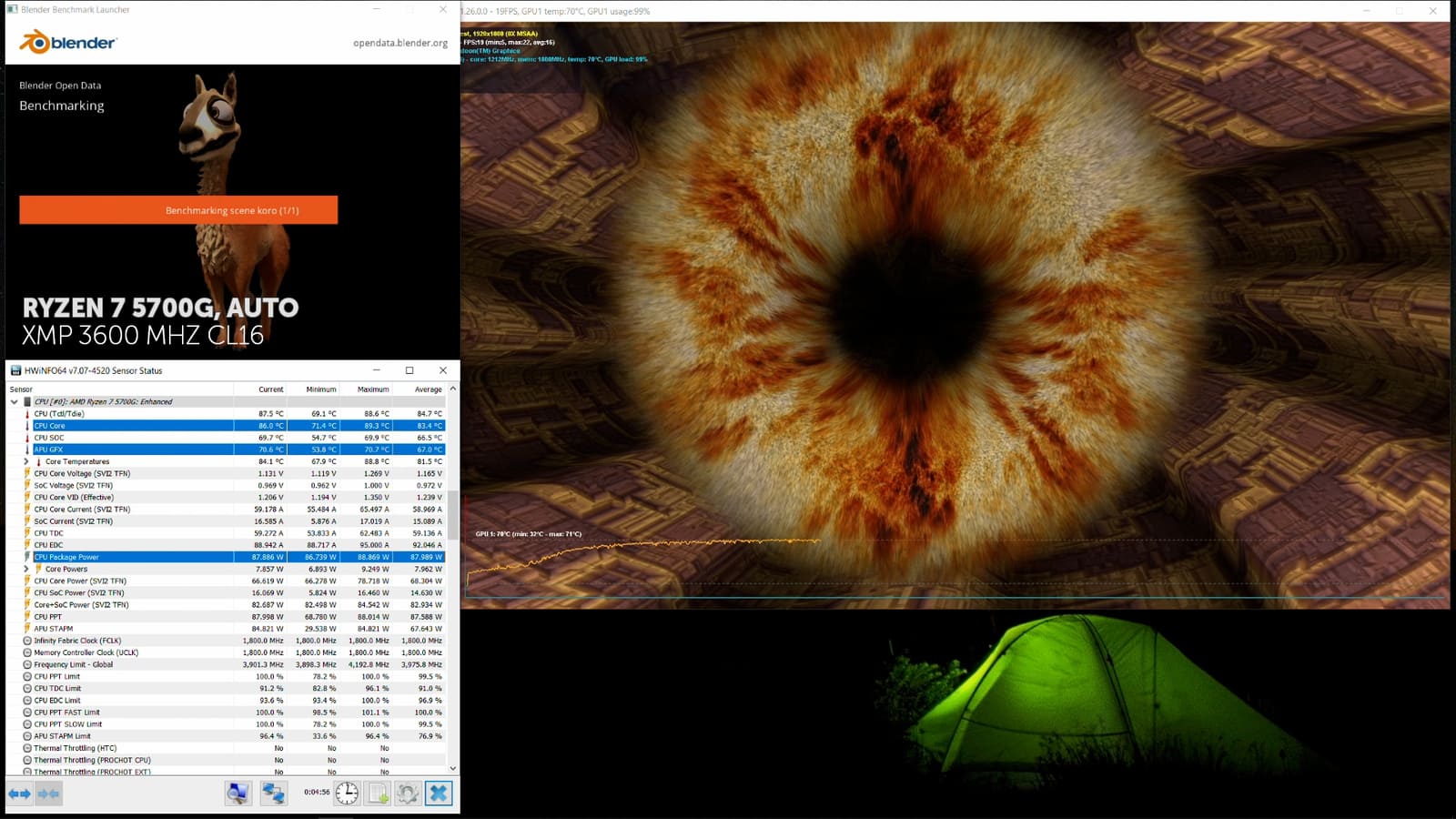
And the boxed cooler, surprisingly, can withstand it. In Russia, there are no OEM versions for sale now, so it will not be superfluous to find out the efficiency of the cooler. The bundled coolers for the 5600- and 5700G are different. The ryzen 7 has the same one as the 5600X, and the 5600G boxed cooler looks better. The gap between the fan and the heatsink is much smaller, half of the air flow will not escape from the heatsink. Plus, due to this, it is lower, and the pre-applied thermal paste covers almost the entire processor cover. However, the fan speed is 500 rpm slower.
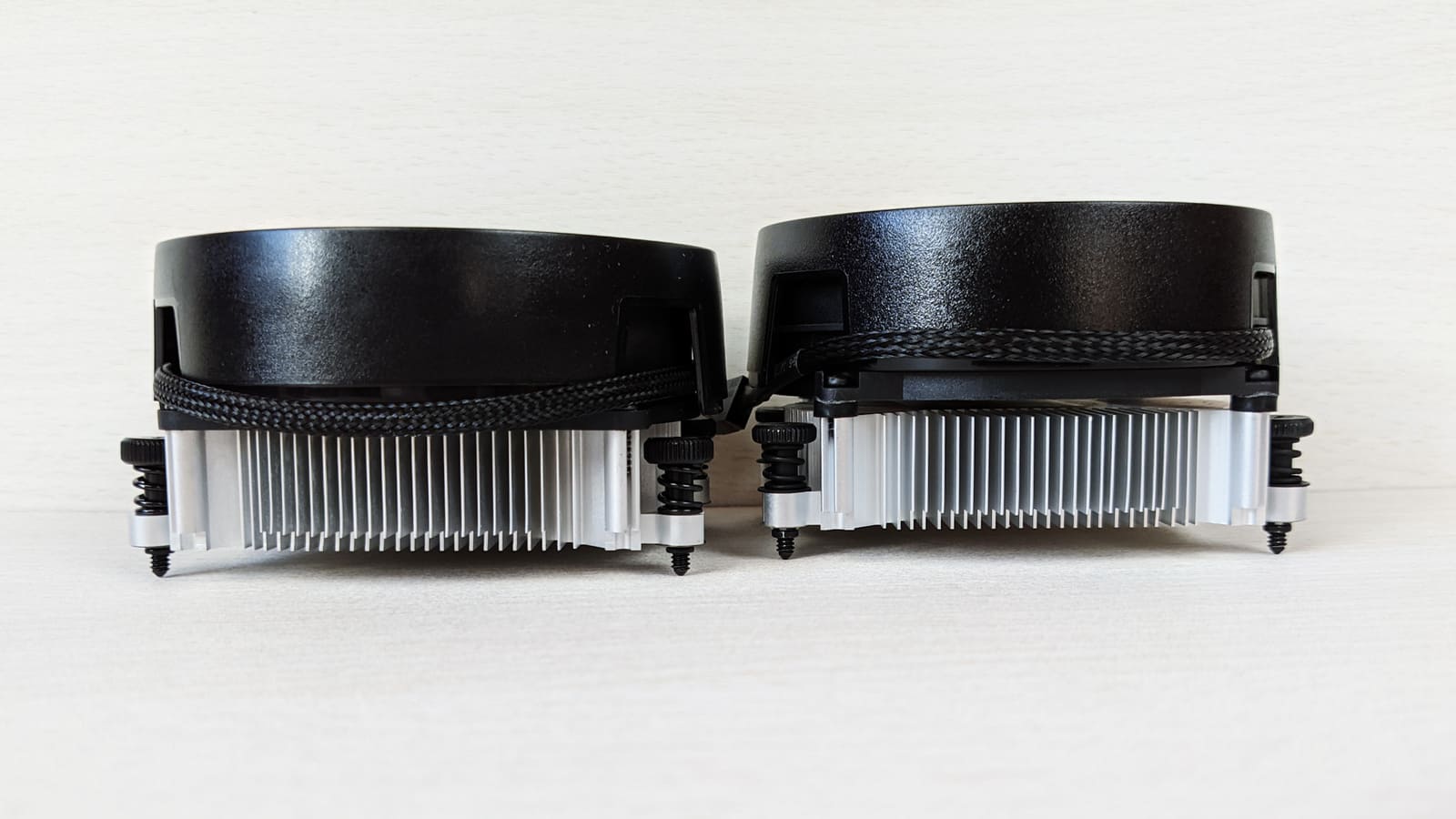
Both fans are audible at arm’s length, but they can’t be called noisy. Tolerable.
When using a discrete graphics card, the stock 5700G heats up to 85C in the stress test, which is unpleasant, in games the temperature will be 10’C lower. This is clearly better than the i5-11400, but considering what coolers AMD is capable of making, it could be better.
As in conventional processors of the 5000 line, hybrid cores switched to the new Zen 3 microarchitecture. However, in addition to combining the L3 cache, we got it doubling compared to the previous generation, that is, now we are not four times behind in L3 cache size, but two times. However, PCI Express 3.0 is an eyesore from other limitations.
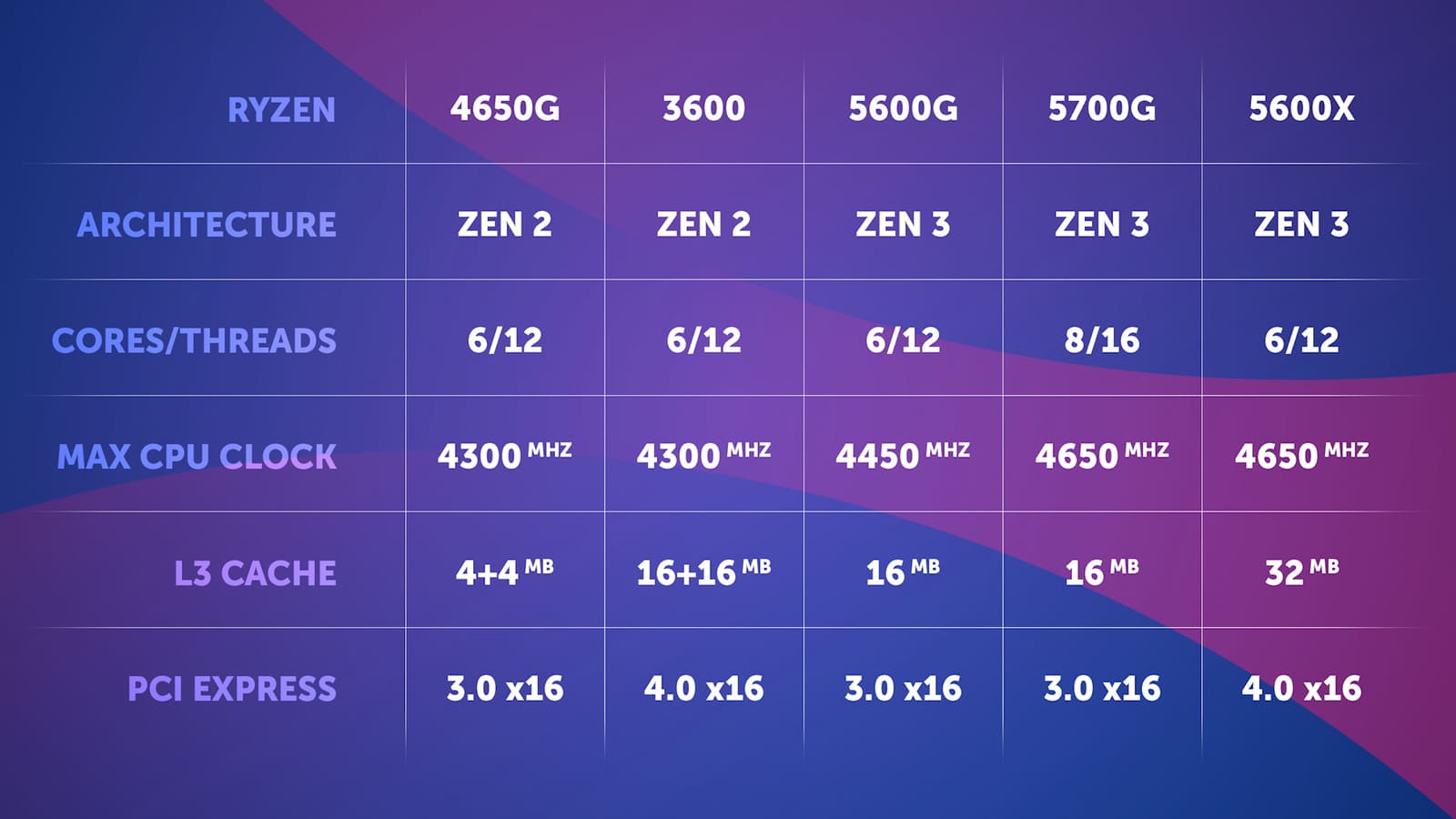
Stock processor test
Synthetics
Synthetics: in the test of memory and caches of Aida, not only the high latency of the 4650G memory relative to the 5000 series of hybrid processors, but also the lower latency of the 5600X catches the eye.
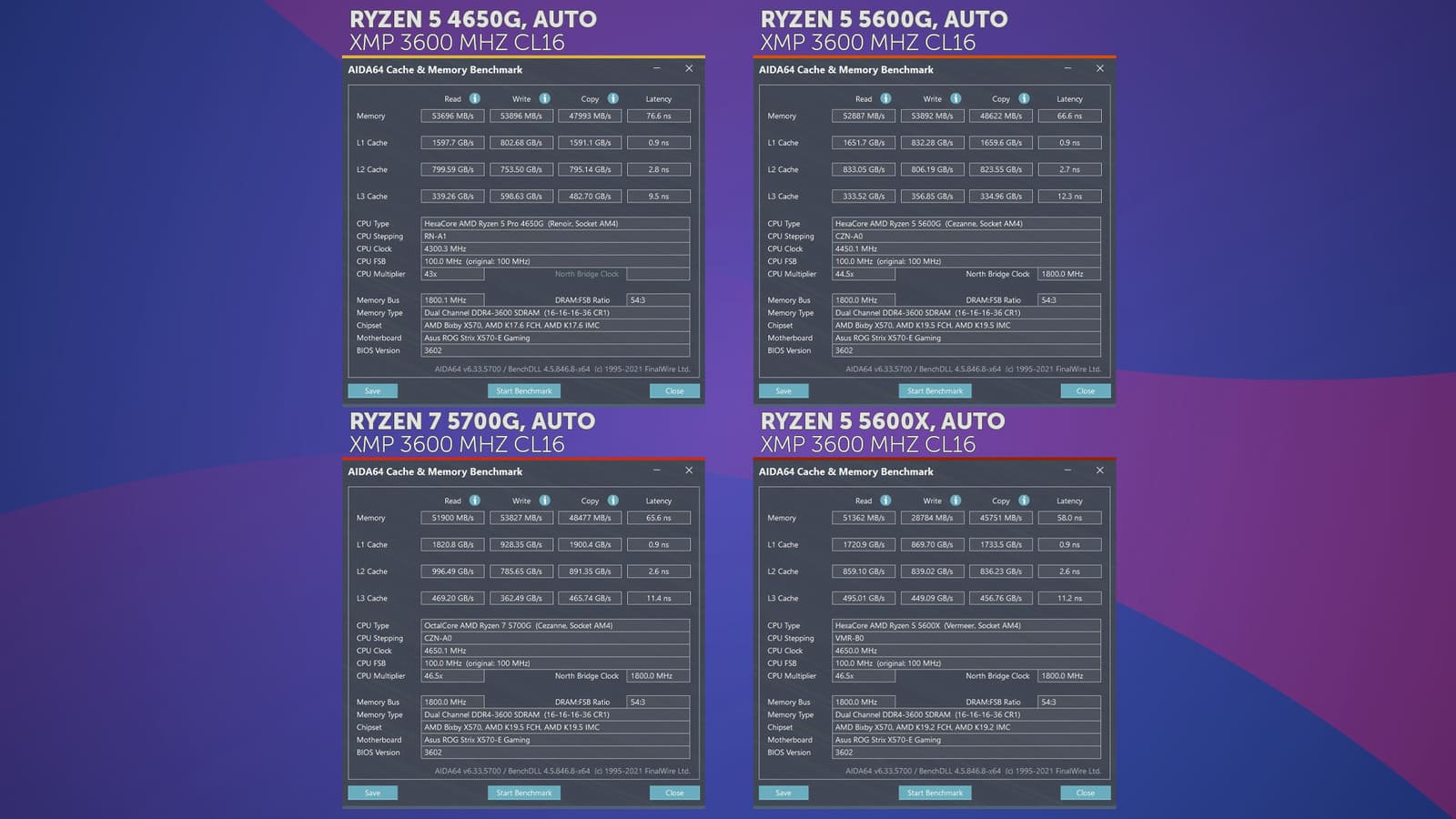
In Cinebench R23, the smaller cache size doesn’t show up. 5000 series ryzens have differences between themselves related to the number of cores and their frequency.
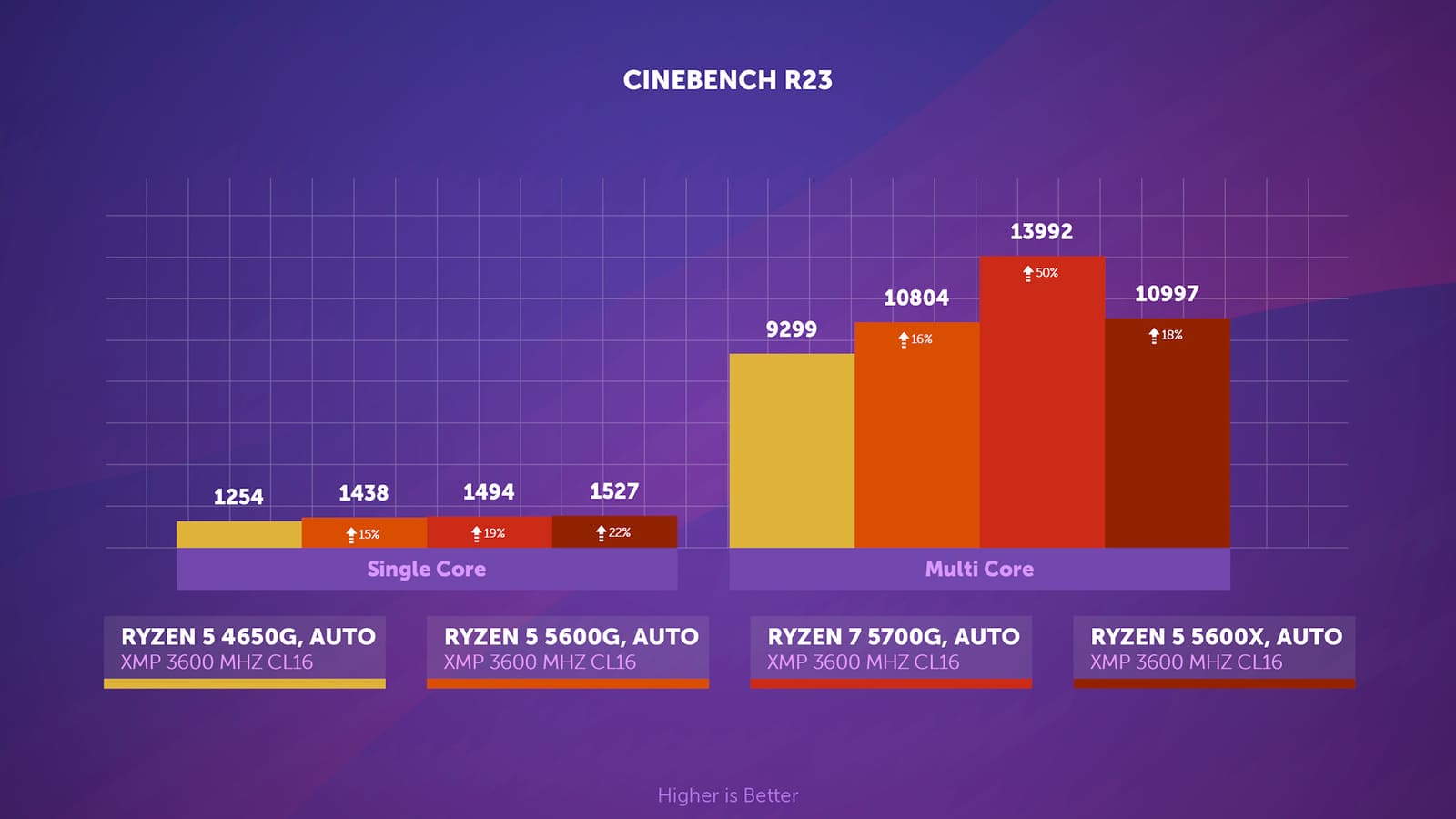
In Geekbench 5, the 5600X lead slightly increased. The gap between the 4650G and its successor has decreased by a couple of percent, and now the 5600G is slightly less than 15% faster than it.
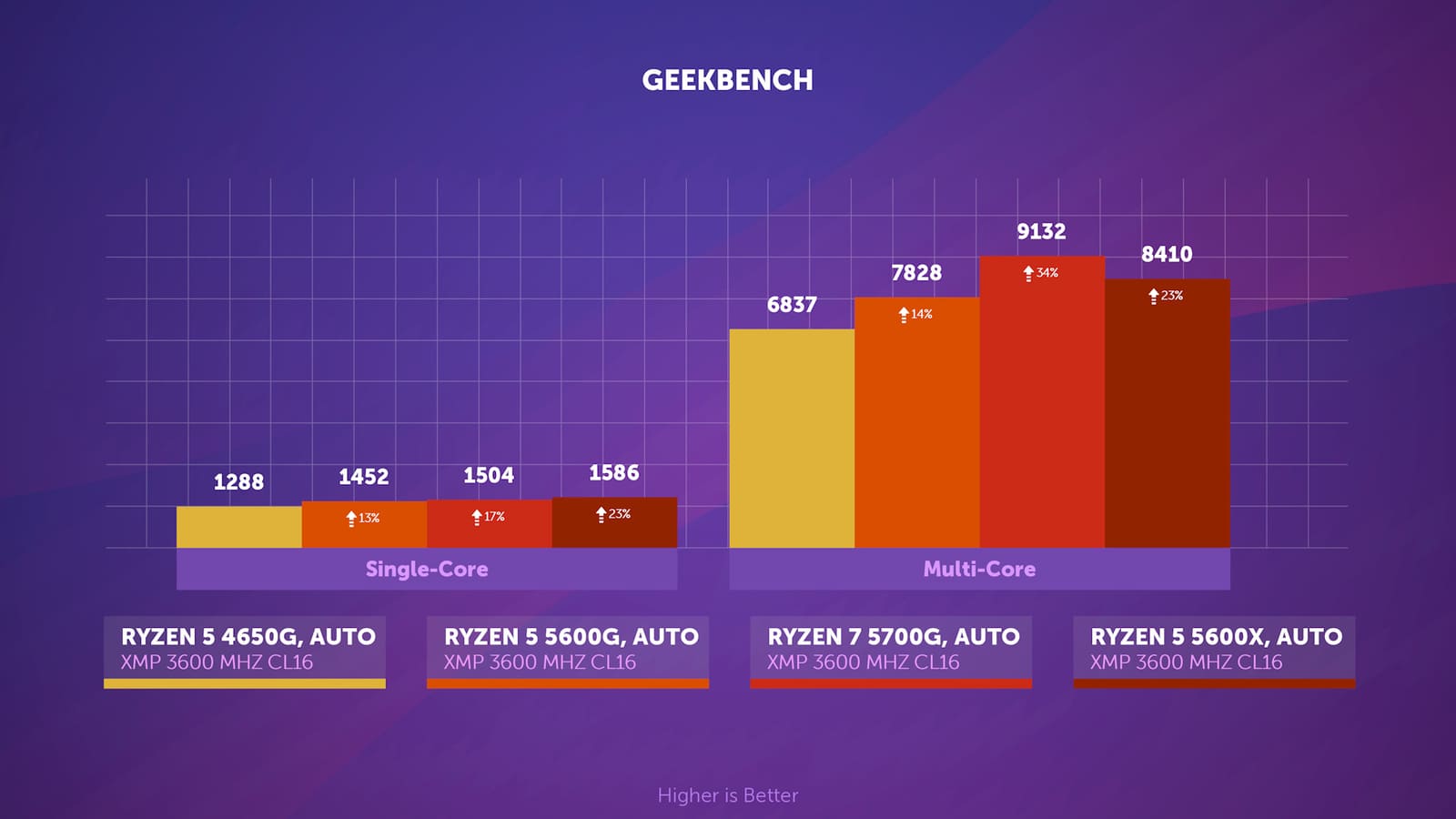
In CPU-Z, the situation is similar to bluebench. Two additional cores and a slightly higher frequency allow an eight-core hybrid to score 37% more points than a six-core hybrid of the same line.
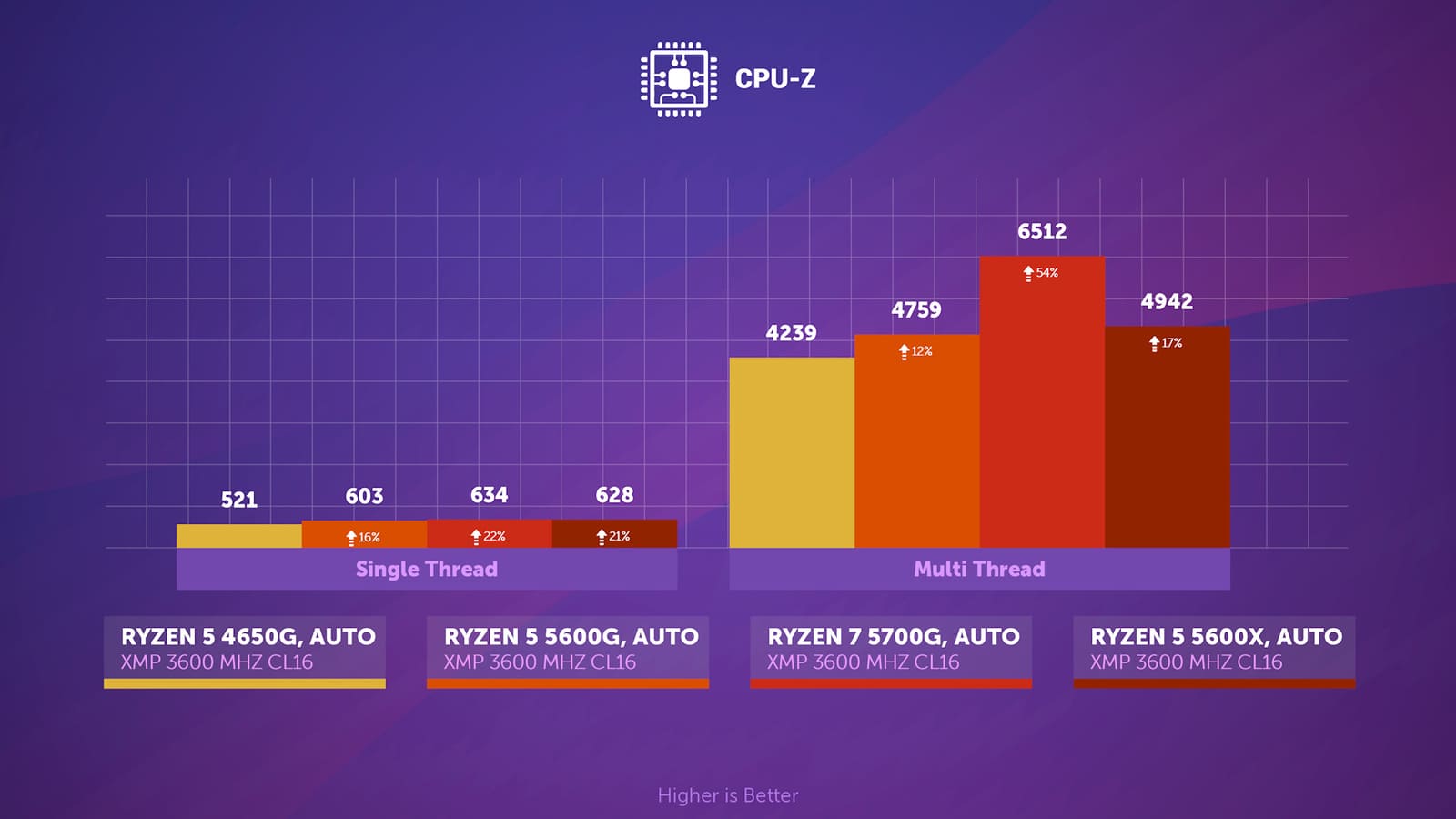
Let’s supplement the results of synthetic tests with the process of passing them. In a blender, the 5600G is the hottest among the stock processors, since it has a higher power limit compared to the 5600X, and the 5700G has a large heat dissipation area with the same heat pack. We add the 5800X to the comparison, and its 140 watts make themselves felt – the temperature of the cores is 22 degrees higher. However, it should be borne in mind that with such a TDP, the 5700G drops frequencies more strongly.
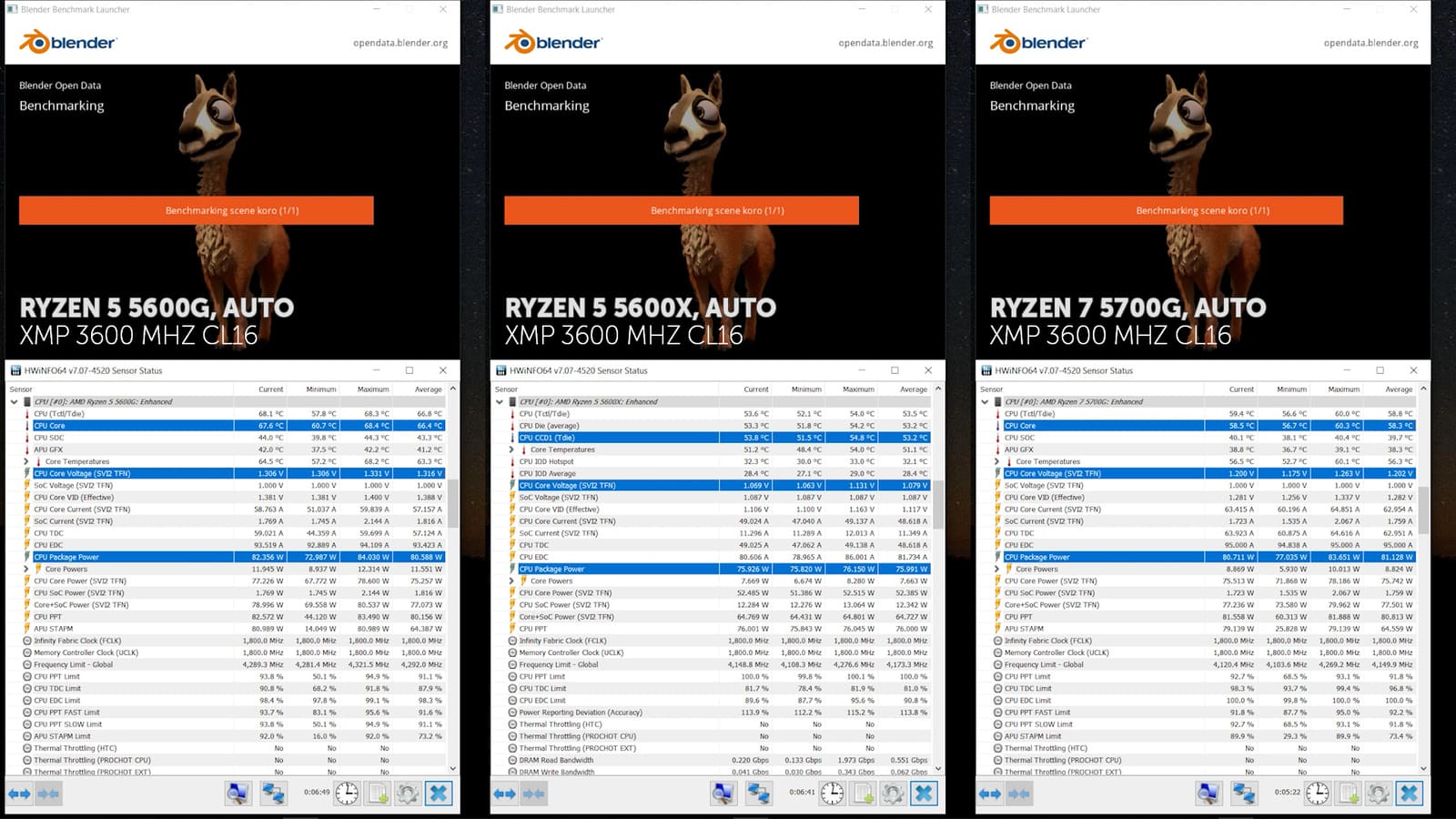
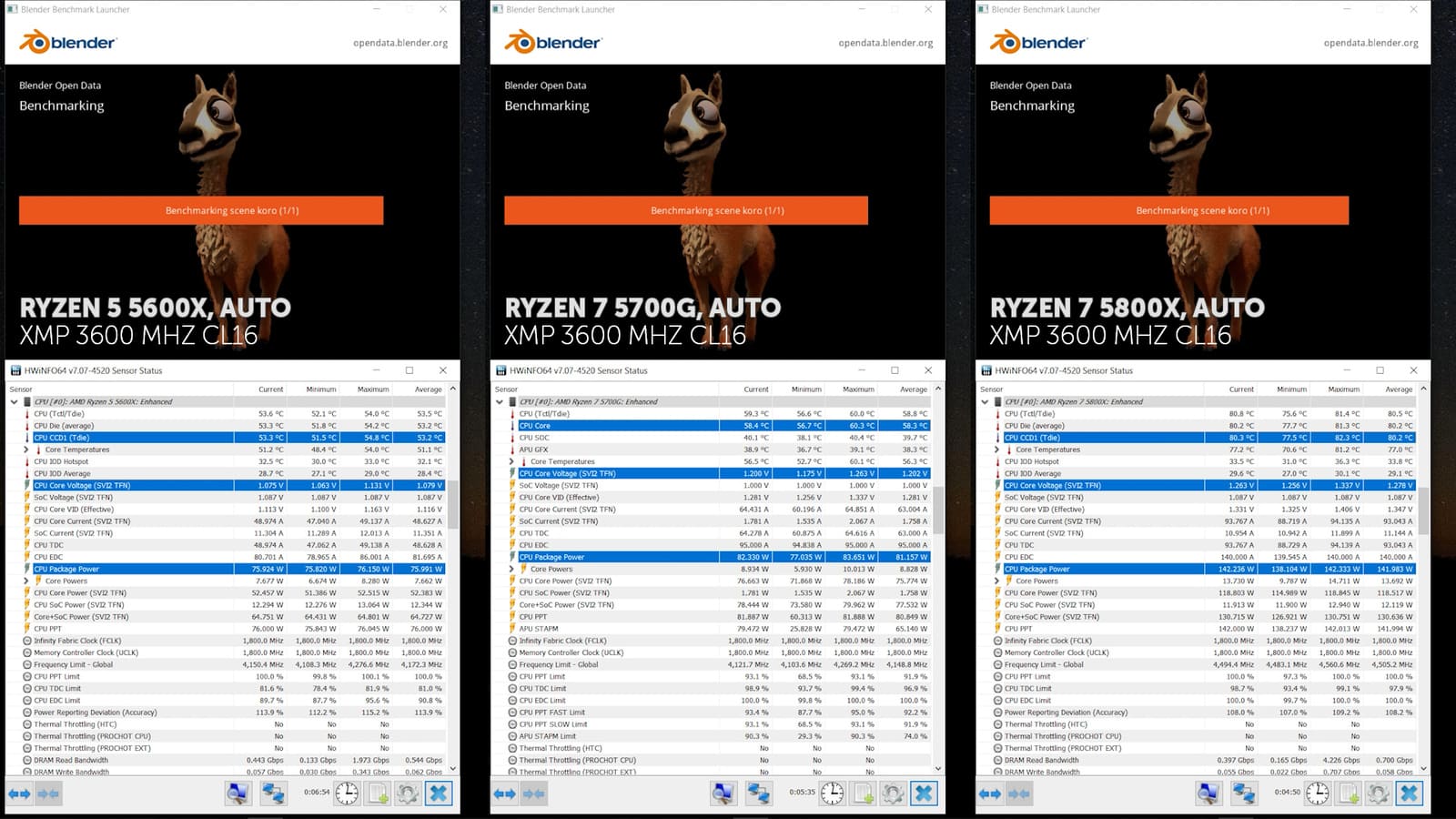
Games
Let’s return to this comparison in the overclocking section to learn about another interesting fact. And now there will be tests in games.
Cyberpunk graphics preset – ultra ray tracing, high crowd density and DLSS – performance. This game prefers to ignore the presence of SMT on 8-core ryzens, while on 6-core ryzens it is actively used and gives a decent increase. As a result, the 5700G is slightly weaker than the 5600G. The latter outperforms the 4650G by 26%, but the performance of the 5600X lacks 10 FPS, that is, 13% additional frames. We also tested the ryzen 5 3600 as a bonus to give you an idea of whether the hybrids are closer to the past or the current generation of conventional processors.
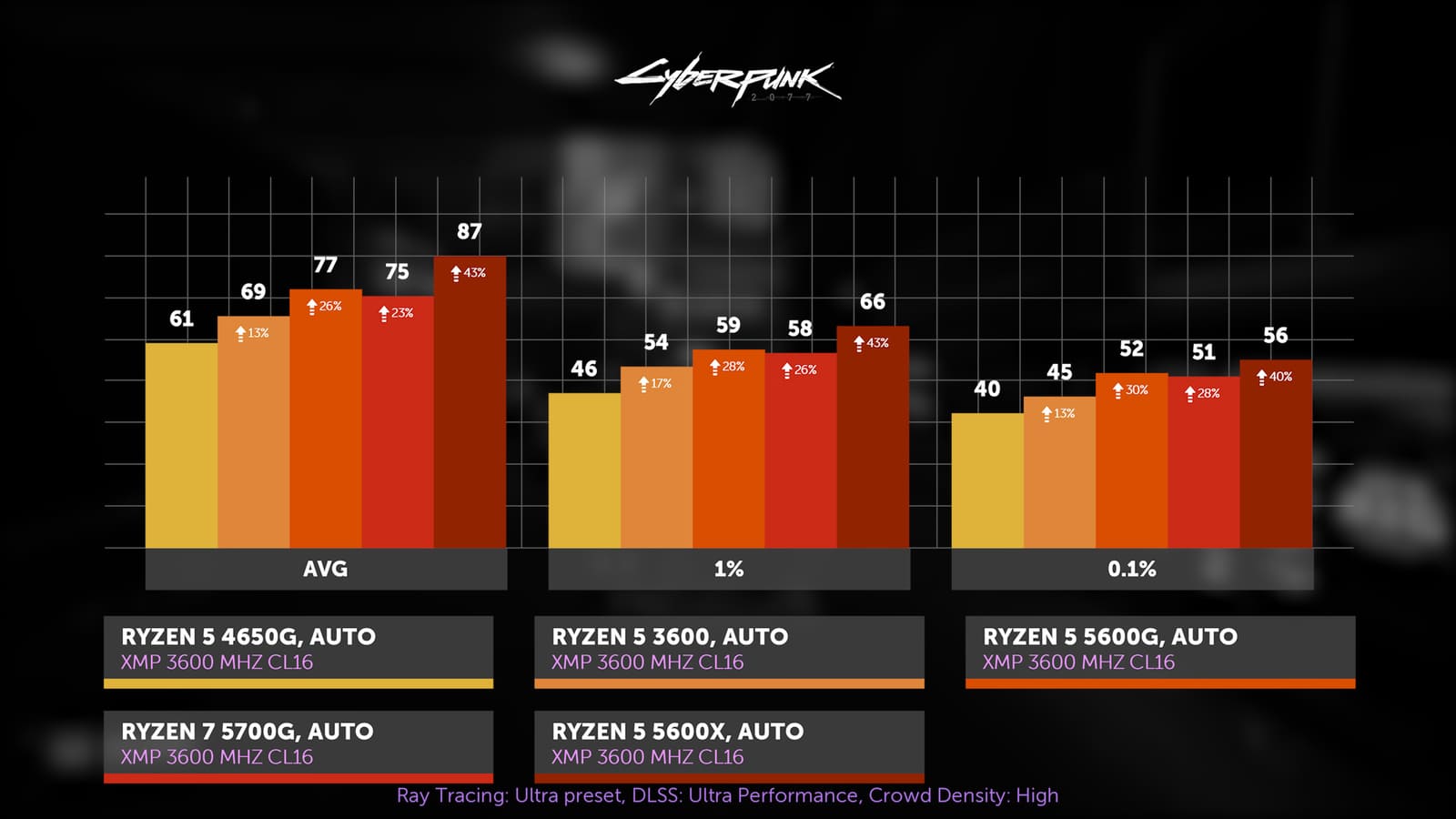
Shadow of Lara, highest preset, 600p. The difference in gaming performance mostly depends on the size of the L3 cache. And, as we can see, in the chest, an additional 16 MB gave a good boost to the 5600X, thanks to which even the 5700G is not even close to it. Actually, that’s why when fighting top processors, Intel loses in this benchmark. Not enough cache. The 5600G is almost 30% faster than its predecessor, but the 5600X prepares 36% more frames than the 3600.
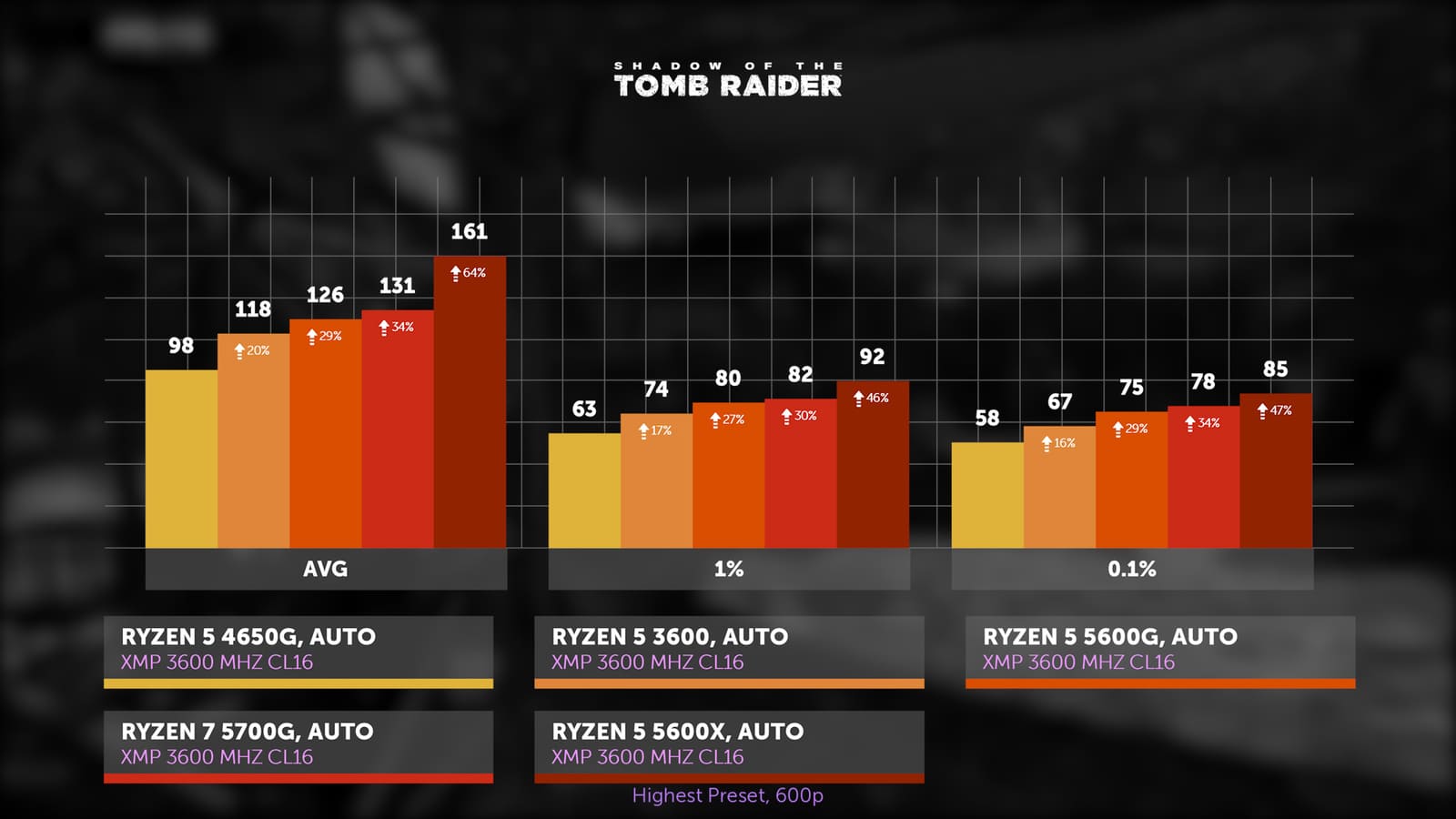
Watch Dogs Legion, ultra preset, DLSS – performance. It can be assumed that both 32 MB L3 cache and 16 MB are not enough for dogs. Of course, there is an increase from it, but not as impressive as in the chest. I also recall the large memory latency in Hades with the same XMP in hybrids. It probably contributes too. 4 additional 5700G streams give their increase, but it is small. It won’t be enough. And even in such a game, the 5600G is a little closer to the performance of the 3600 than the 5600X.
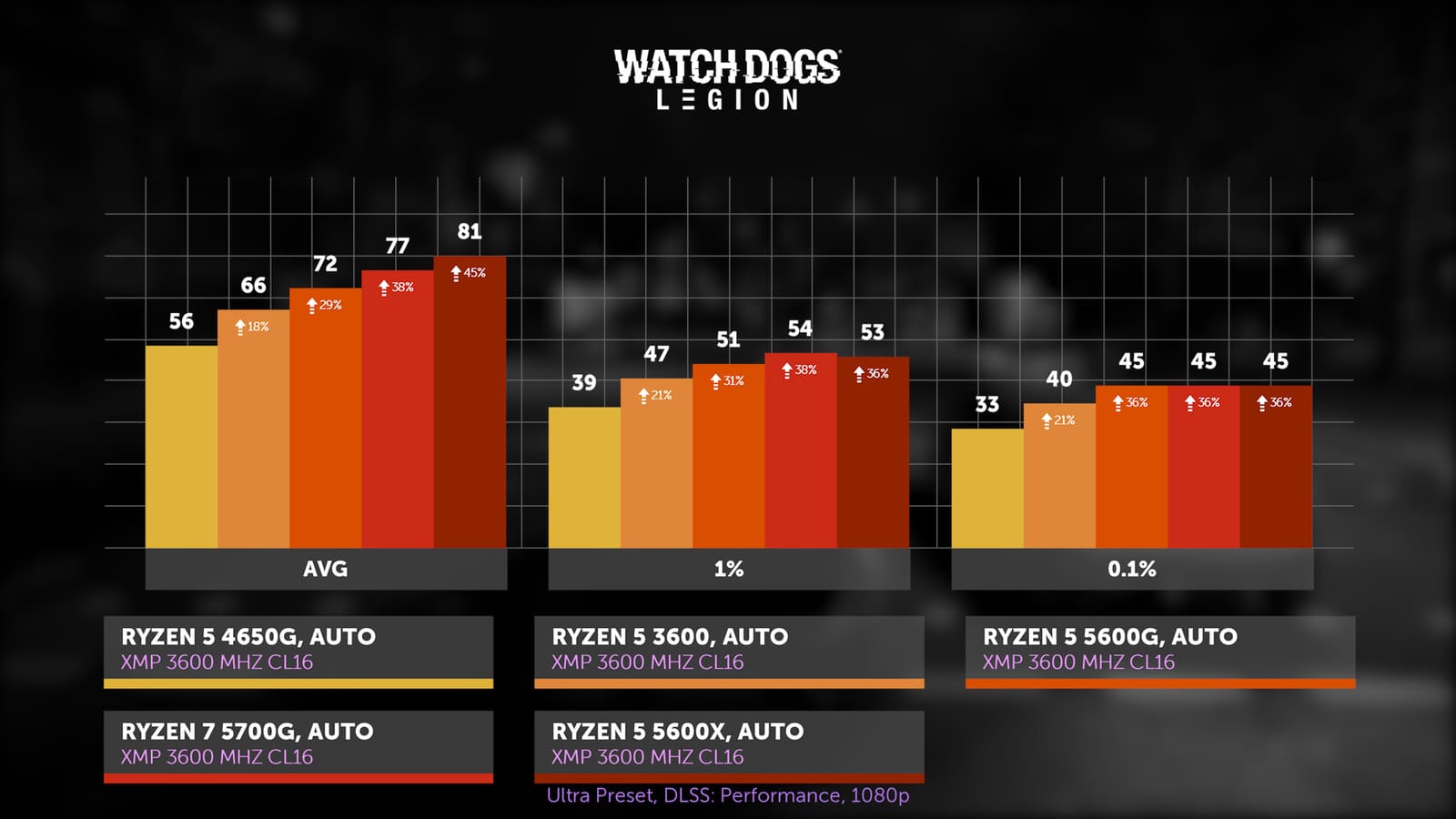
StarCraft II, maximum graphics settings. Here, too, 5000 ryzens immediately took a leading position upon release due, for the most part, to the unification of the L3 cache and the pumped prediction block. A 2 times smaller volume in APUs of the same line has a serious impact. Their productivity is lower by a quarter. This is the level of the ryzen 3600, if it has the same core frequency.
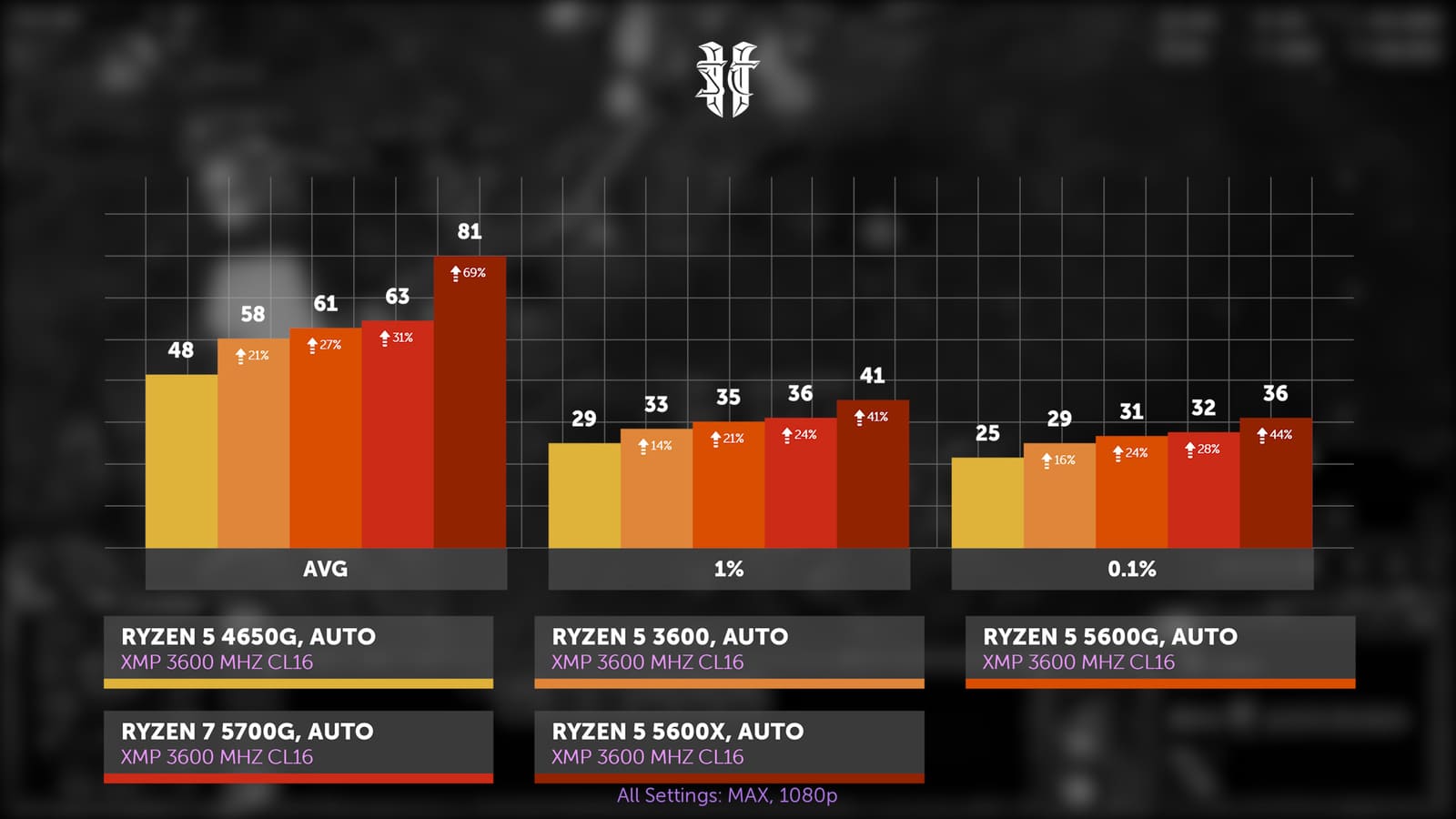
Total War Saga: Troy. Ultra graphics preset, unit size and grass detail are raised to an extreme level. Resolution modifier – 50%. Without proper memory overclocking, the 5700G cores can’t show themselves, which is why it’s only marginally faster than the 5600X. The 4650G is also slightly behind. There is a strong limitation on the part of the memory subsystem.
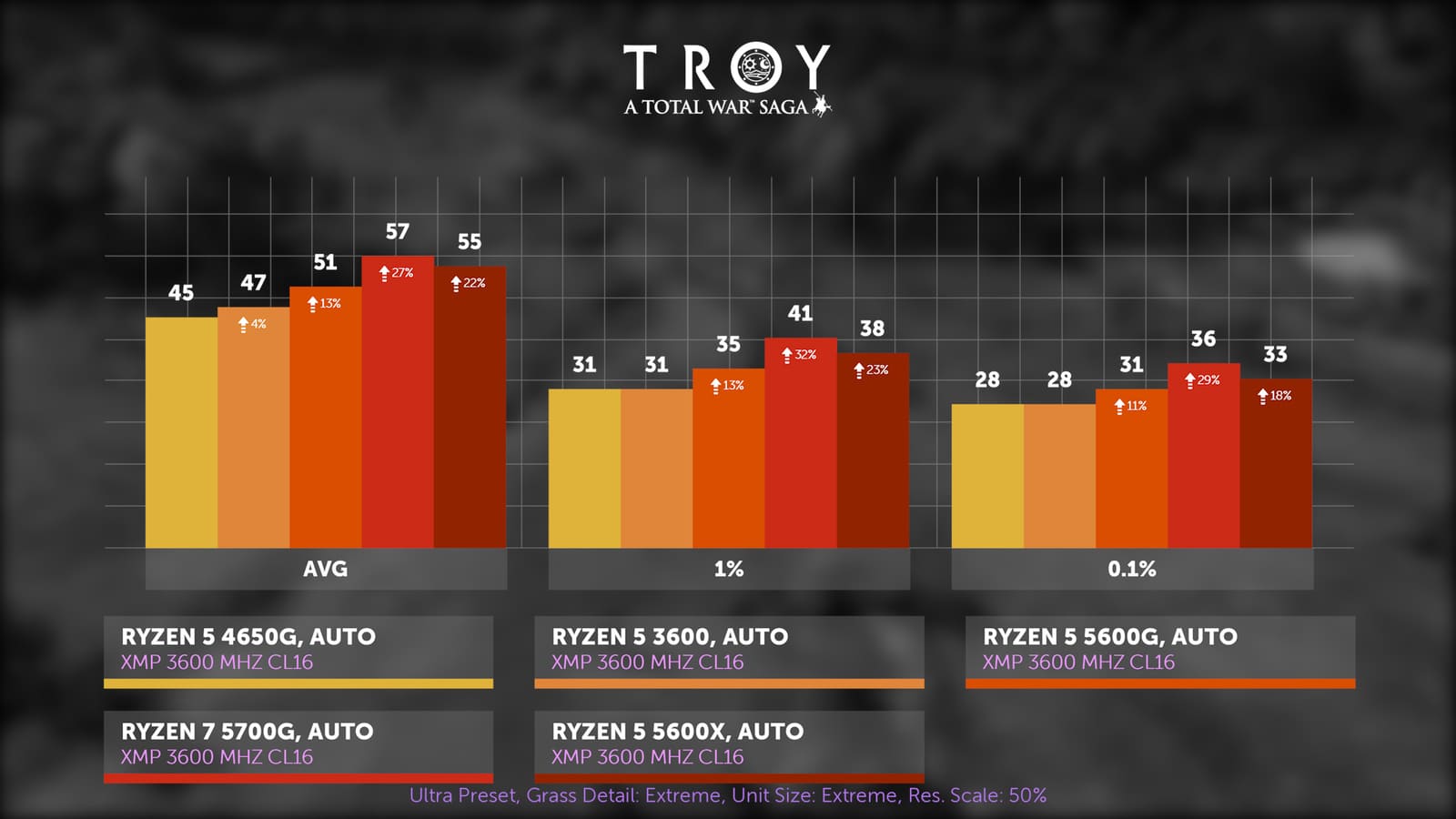
CS:GO, minimal settings, tournament replay. 5600X destroyed everyone. Who would have thought that some additional 16 MB of memory built into the processor could give 100 FPS out of the blue, which is as much as 30% of additional frames. The same third the 5600G is faster than the 4650G. I wonder how much faster the newer ryzens with more cache will be.
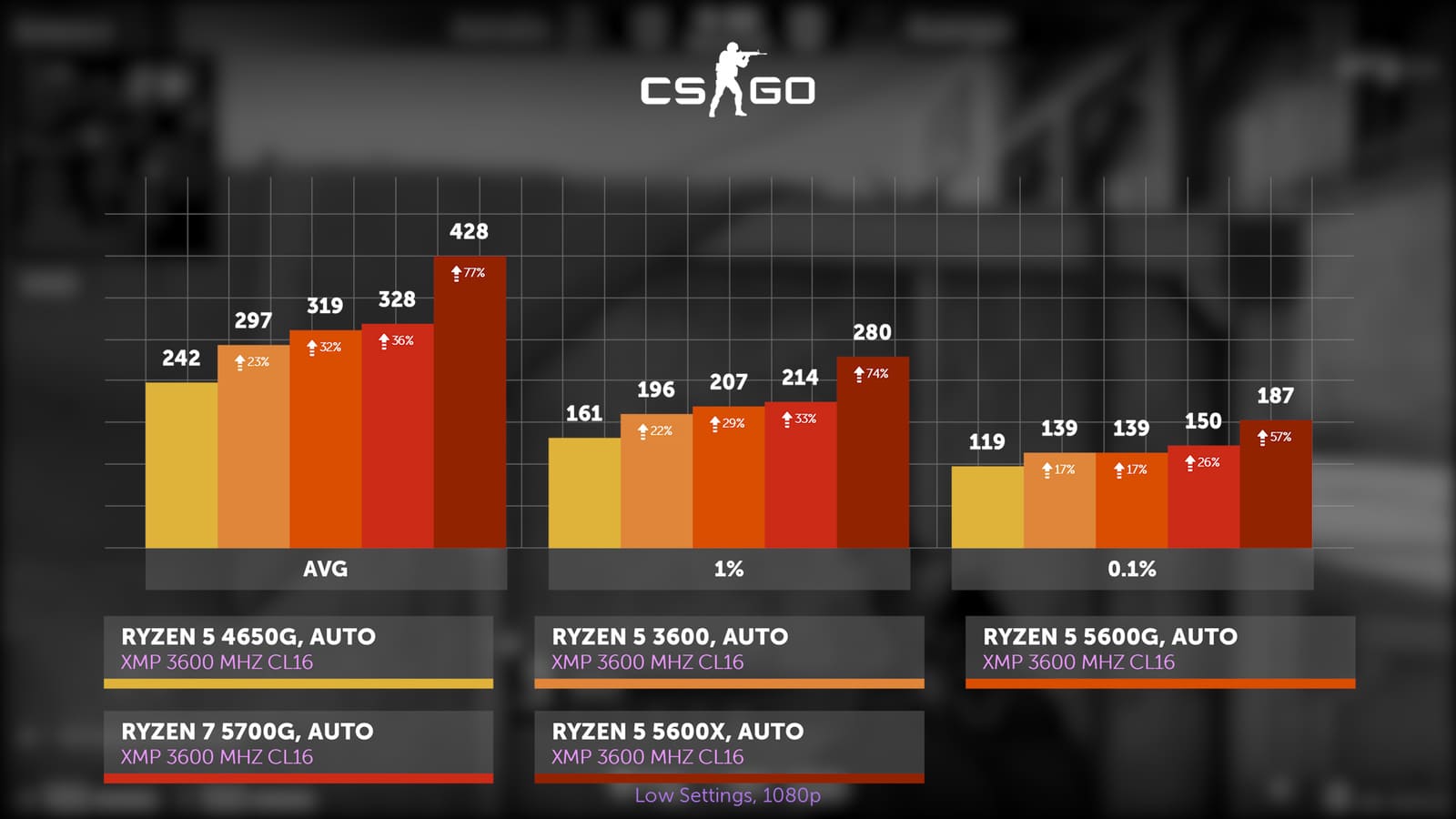
On average, the results for the ward are disappointing. In addition to all the improvements that have occurred in the usual processes of ZEN 3, the hybrid ones have also doubled the L3 cache, reducing the backlog in terms of its volume from analogs deprived of graphics from four to two times. However, the 5600X is on average 31% faster than the 3600, while on the APU side, the transition to the new generation brought only 26% additional frames. Therefore, just as the 4650G was closer to the 2600 than the 3600, the situation with the 5600G ryzen was similar.
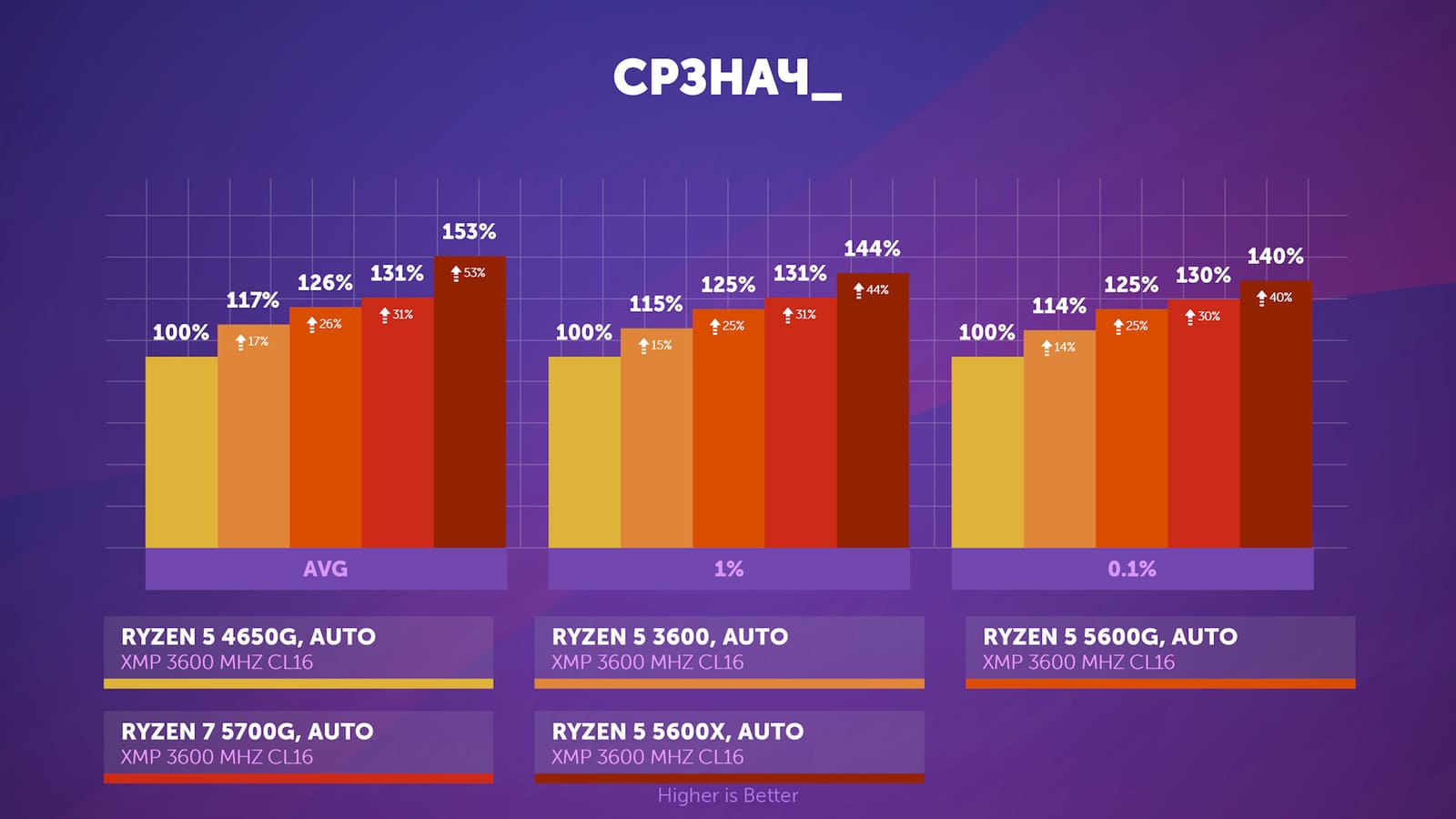
Overclocking memory and processors
Memory overclocking can save the situation, because the 5600X, like the 3600, is often limited to 3800 MHz, while on the 5600G we reached 4533 MHz. Timings for processors without built-in are identical. Core overclocking is different. At the same 1.3v, the 5600X is stable at 4650 MHz, while the 3600 is 300 MHz slower.
And if with identical XMP the latency of 5600X was the lowest, now it is in third place, and in terms of read, write and copy speed it is in last place. And yes, for hybrid processors with a monolithic crystal, the write speed is not cut by 2 times. Until now, many hayat ryzens for this shortcoming, however, this did not really help the APUs.
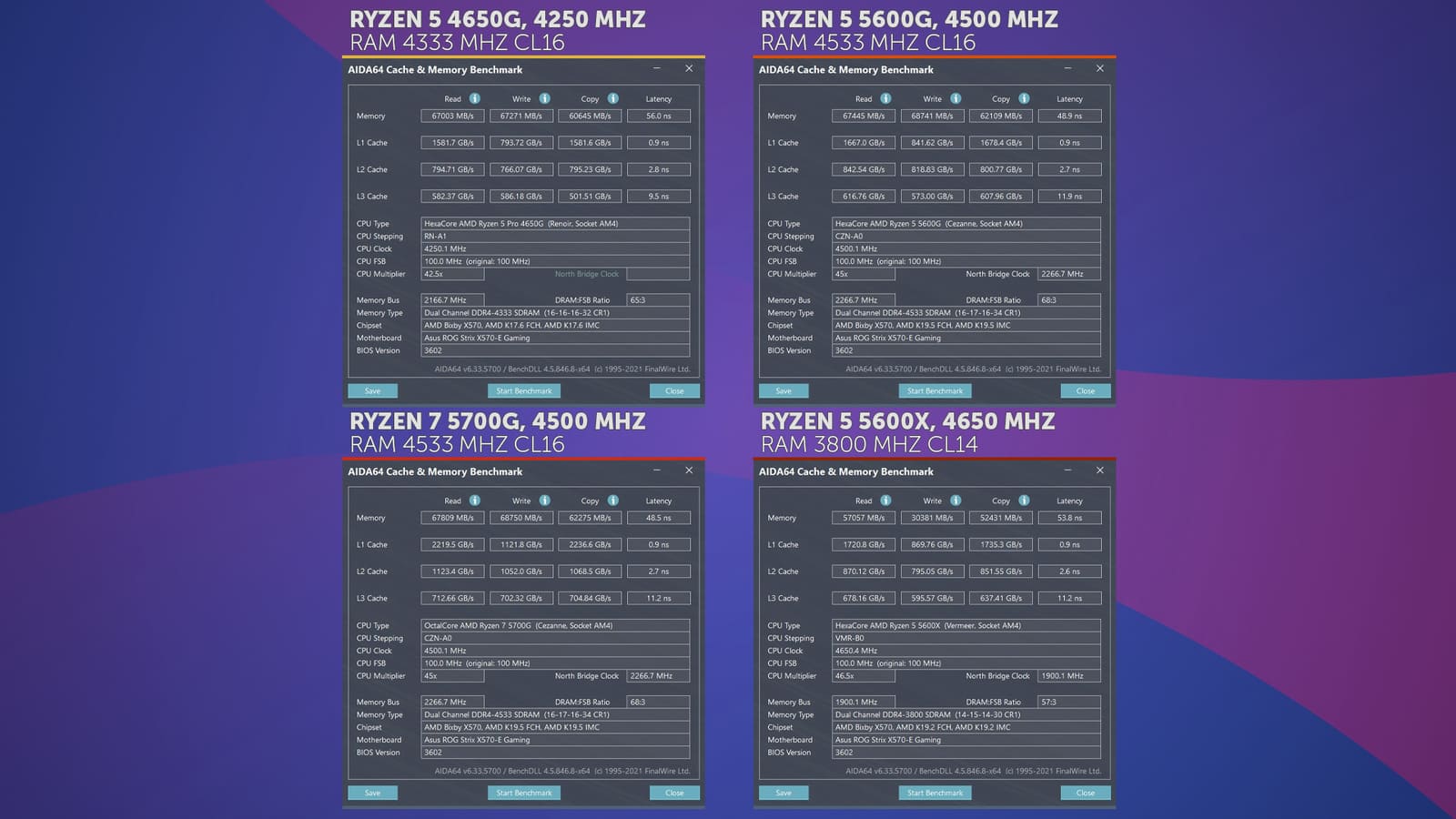
Benchmarks
In Cinebench, the balance of power has not changed. Memory overclocking does not affect here, and core overclocking cannot be called such. It is rather a simple fixation or some kind of undervolt.
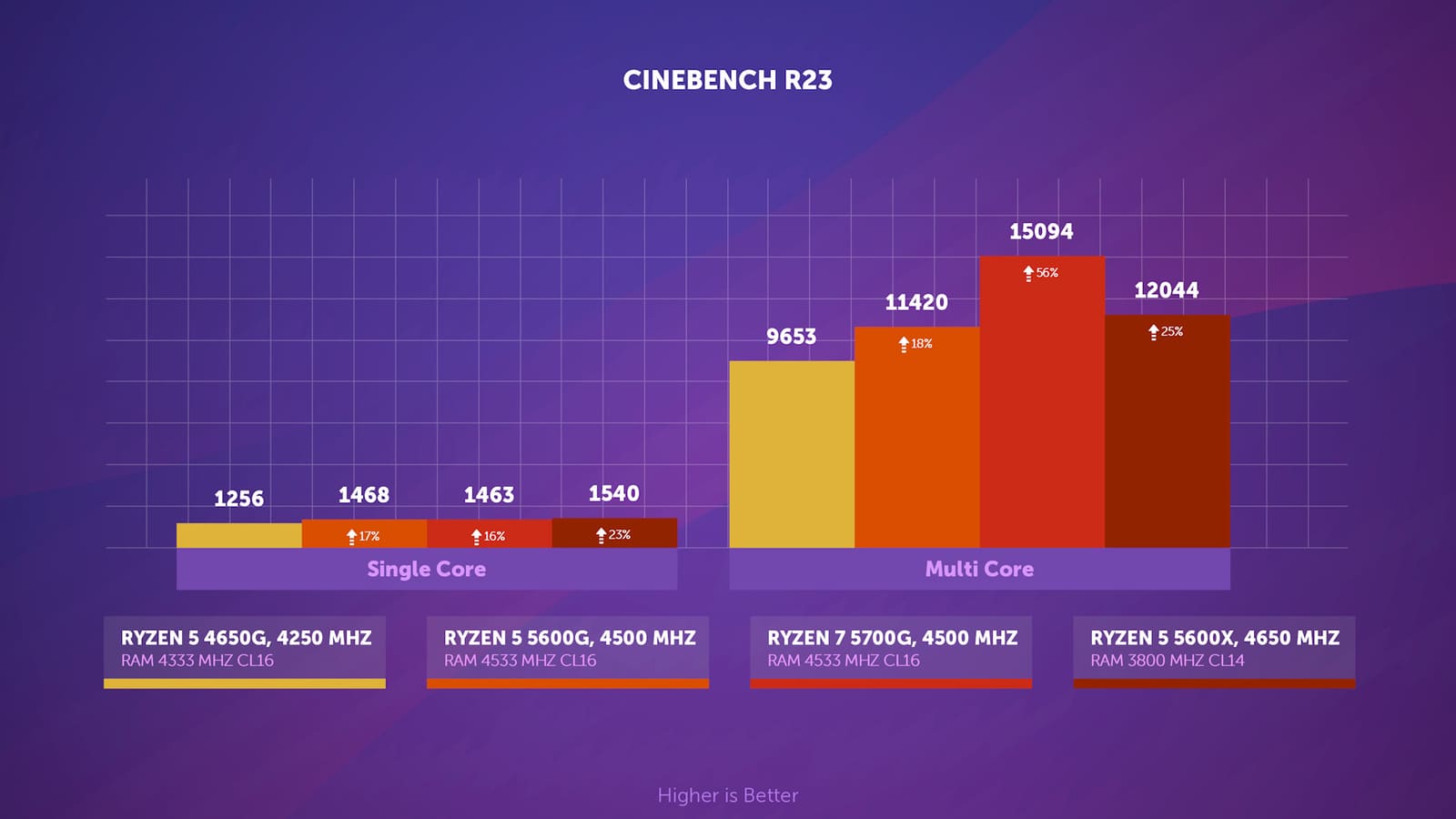
In the gigbench, the 5600X is faster than its namesake with the G index not by 7.5, but by 2.5%. The 5700G, in turn, took the lead.
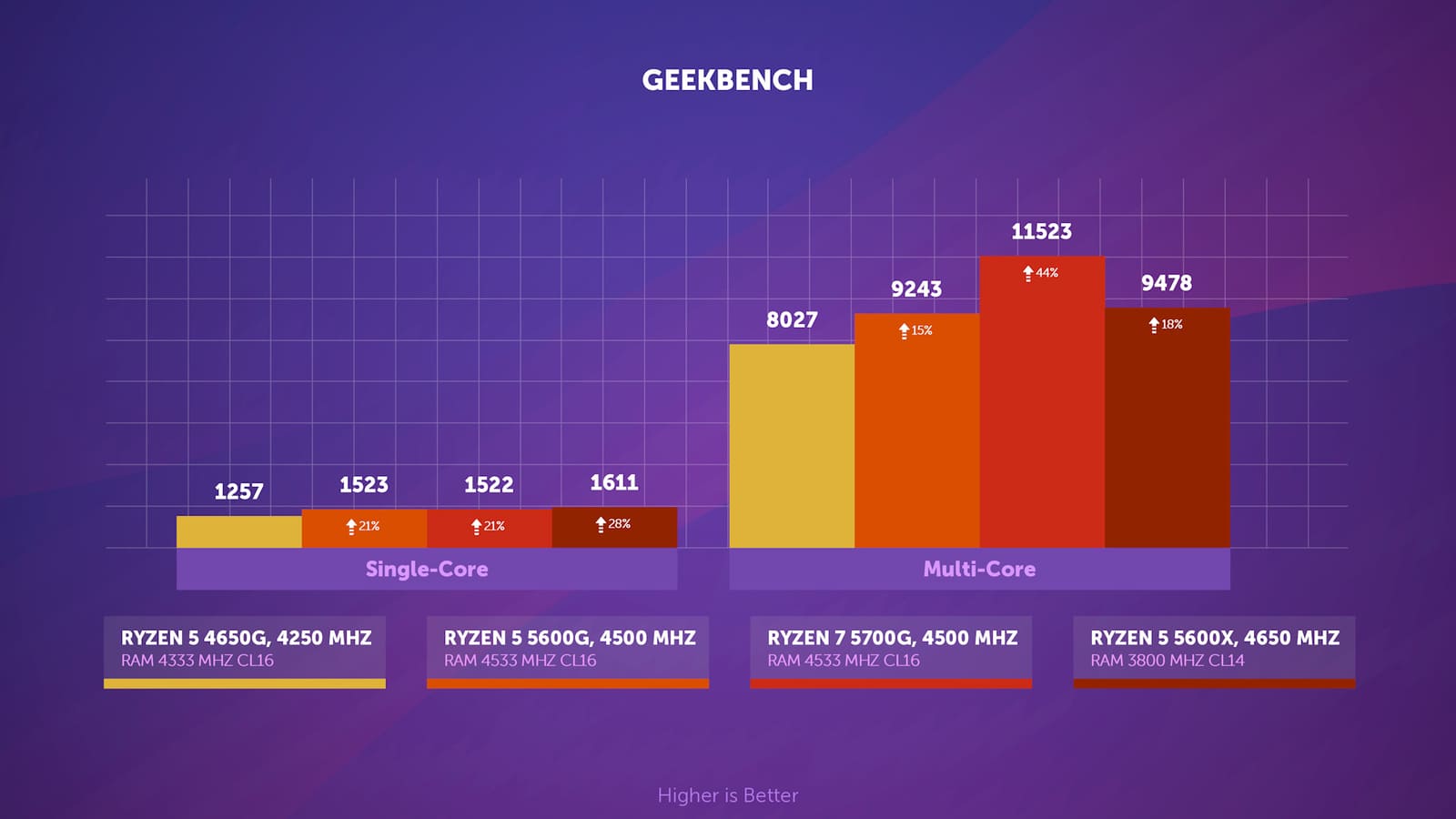
In CPU-Z, the 4650G lost 4 points compared to stock, since its frequency is fixed at 4250 MHz, while with PBO it could reach a value 50 MHz higher, but in multi-thread we got 80 points more.
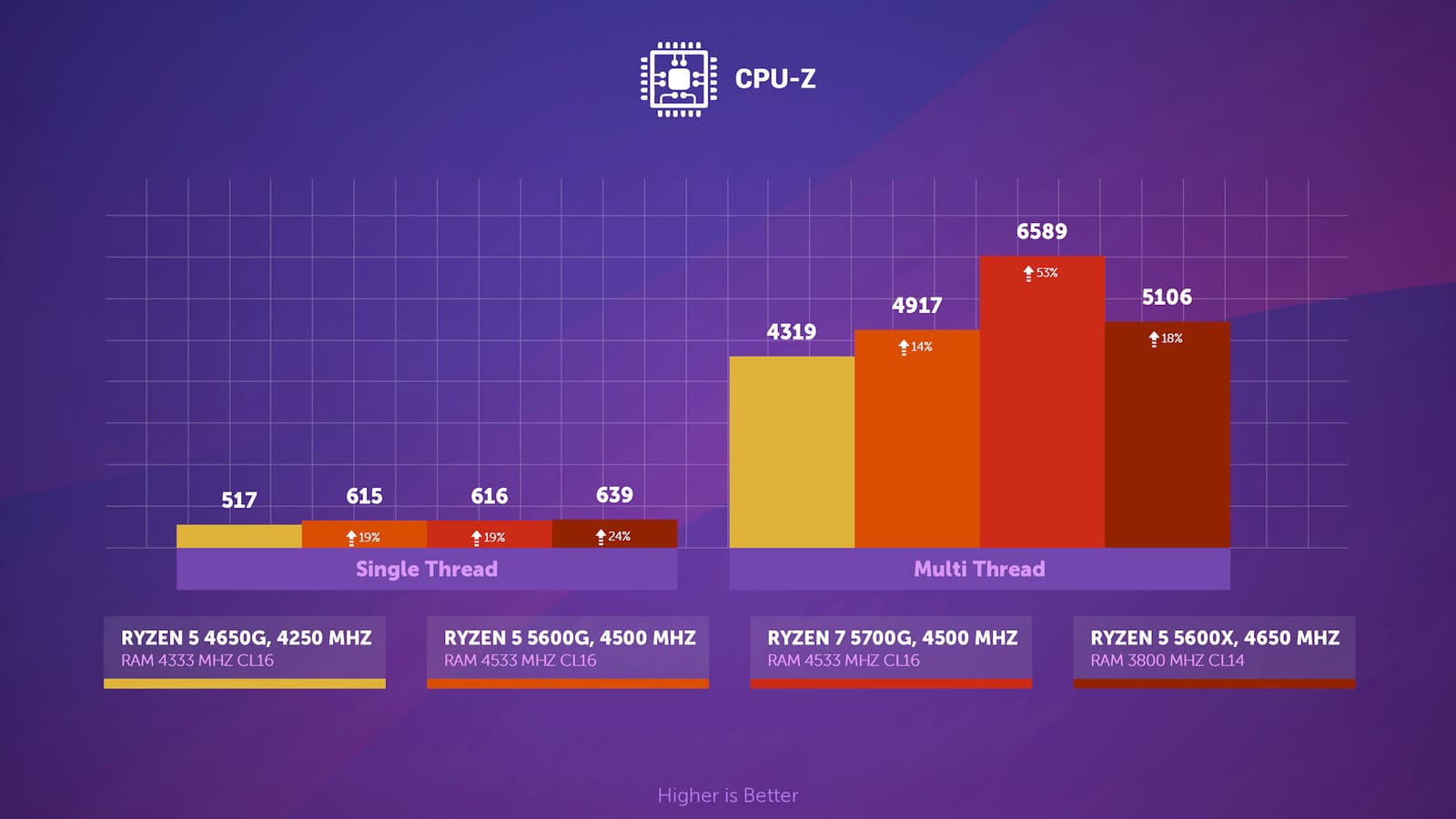
Let’s turn to the blender again to compare processors at the same frequency, voltage and without Power limits. Here’s a surprise: the six-core 5600X is hotter and more power hungry than the 5700G. And compared to the 5800X cores, the 5700G has eight ice cubes inside. There is almost a one and a half times difference in power consumption between them. Good surprise.
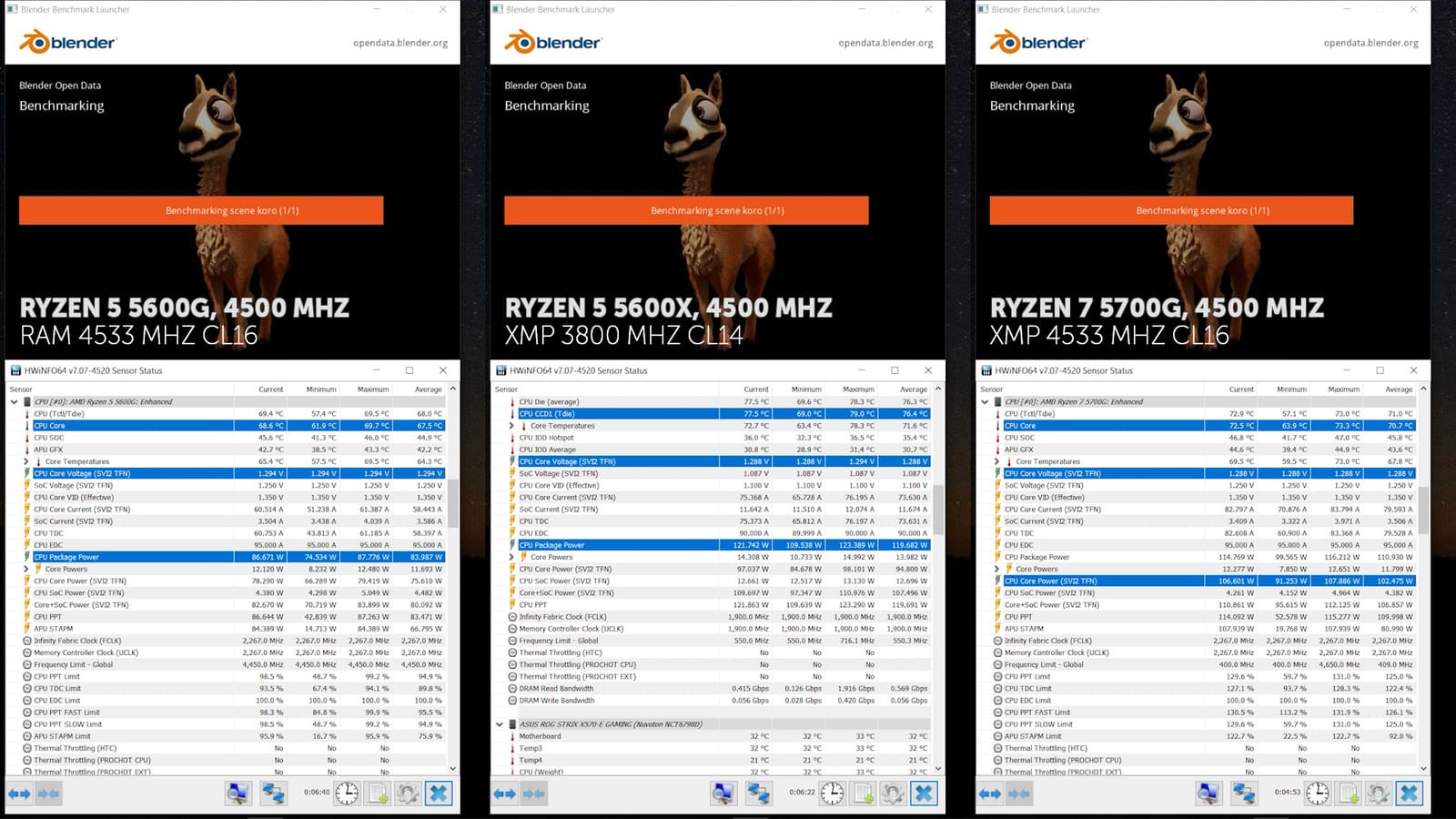
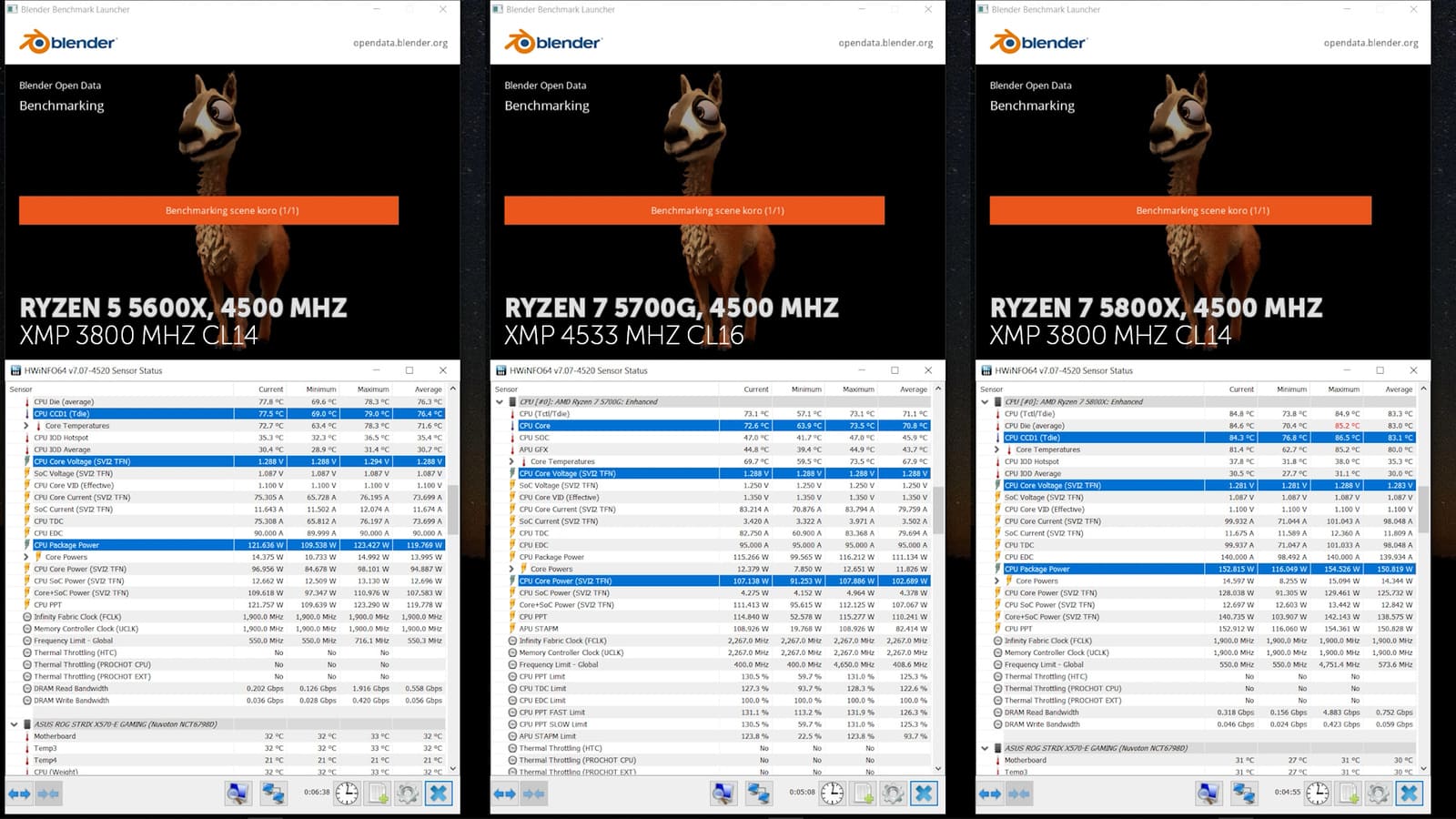
Games
Again we go to cyberpunk and we observe a pleasant picture. The 13% advantage of the 5600X over the 5600G has been reduced to 4%. The processors in the center are on a par, and their lead over the 4650G has increased from 25 to 30%.
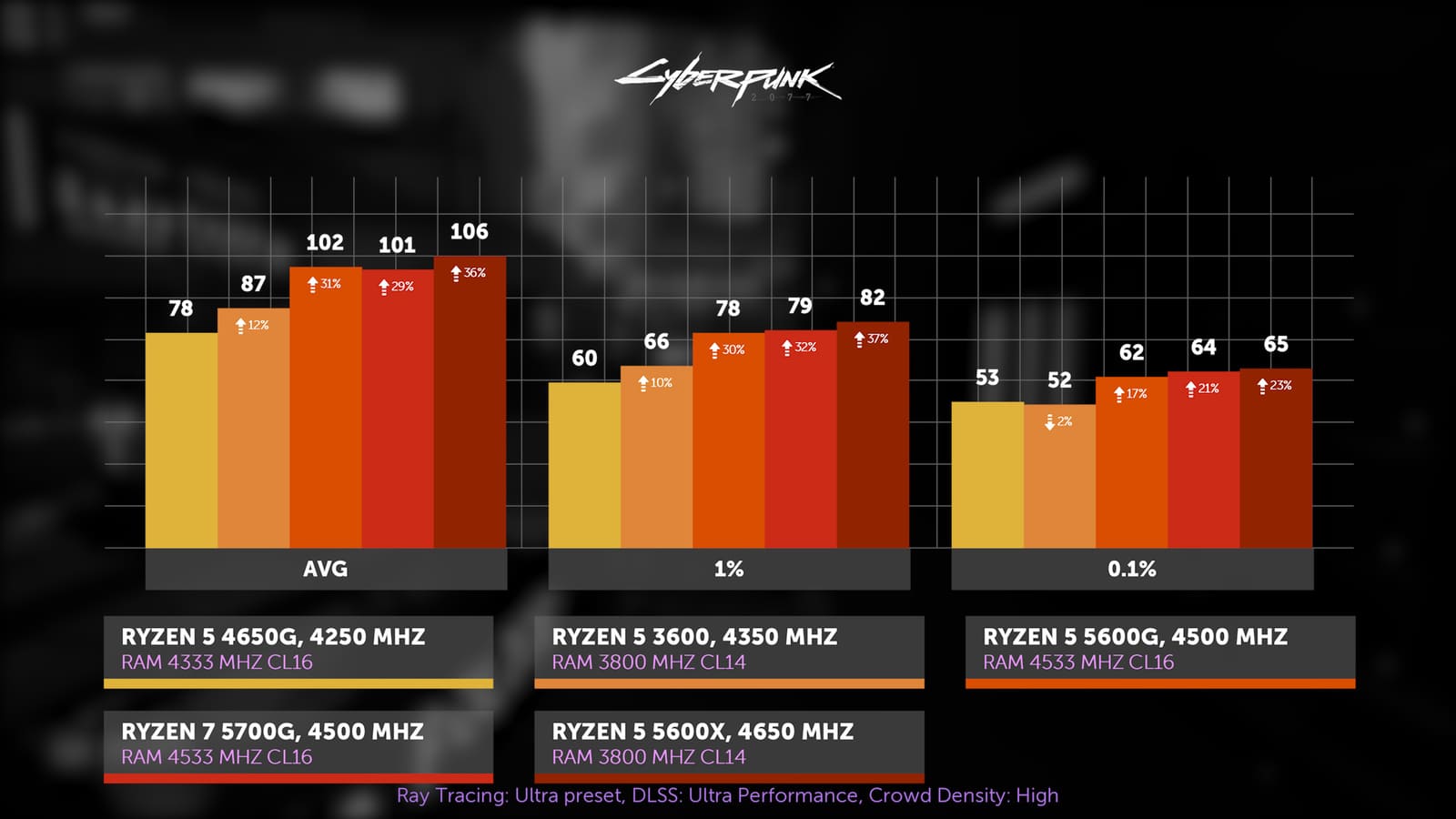
In the chest, the 5600X large cache still dominates, but not with such force. On the other hand, have you noticed that this cache gives a huge increase only in those games where there are already a lot of FPS? Starcraft does not count, there the entire load hangs on two cores. Contra, tanks, DOOM, lara and many other games are already played on such processors with excessive FPS, and in more demanding games like cyberpunk or watch dogs, where you have to choose between ray tracing and normal FPS, the advantage is not so great.
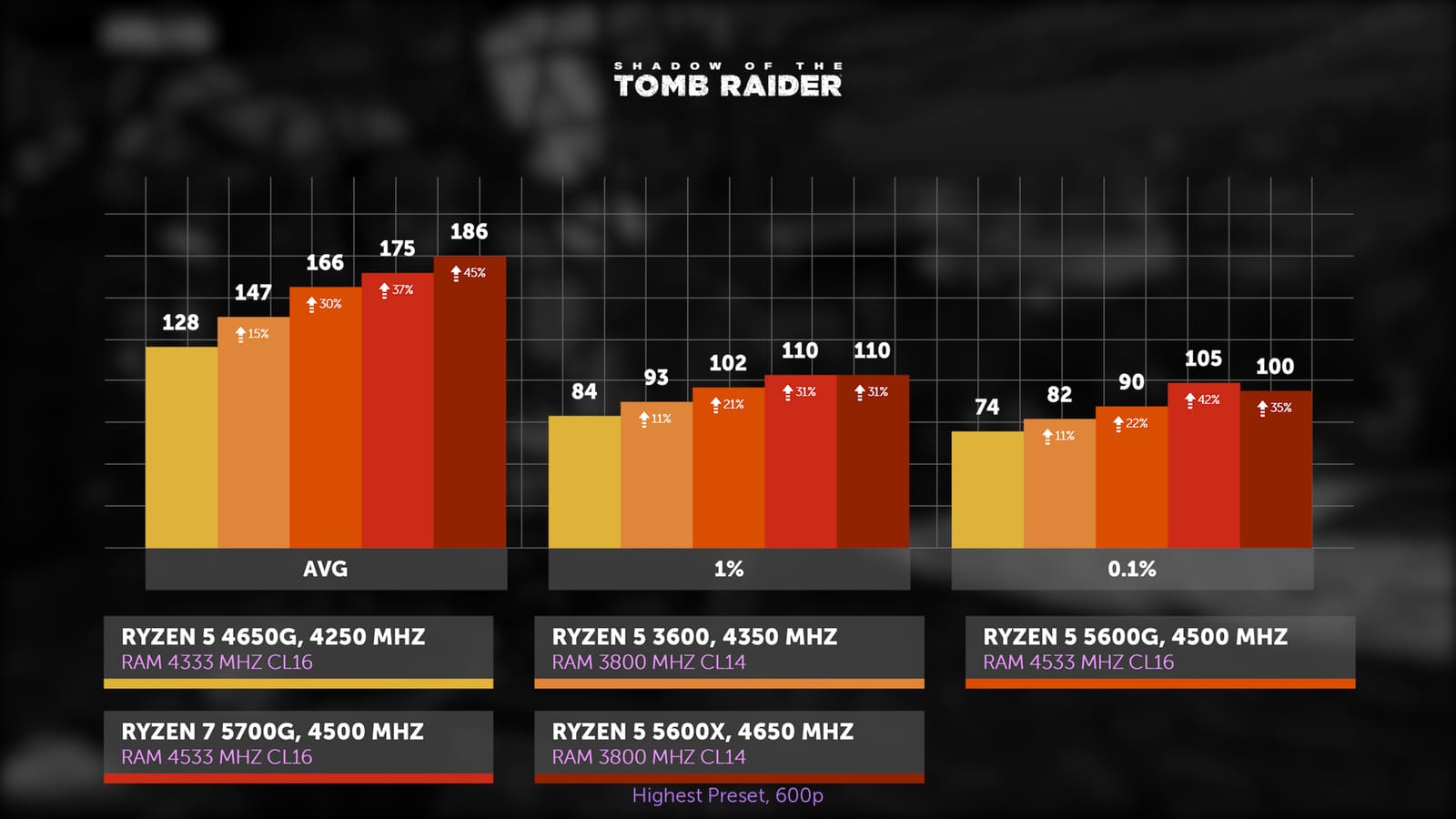
In dogs, the 5700G was finally able to outperform the opponent on the right, while the 5600G is only 5% behind. Moreover, according to the statistics of rare and very rare events, it cannot be said that the difference is radically different. Plus or minus the same thing from game to game, so we don’t pay much attention to it.
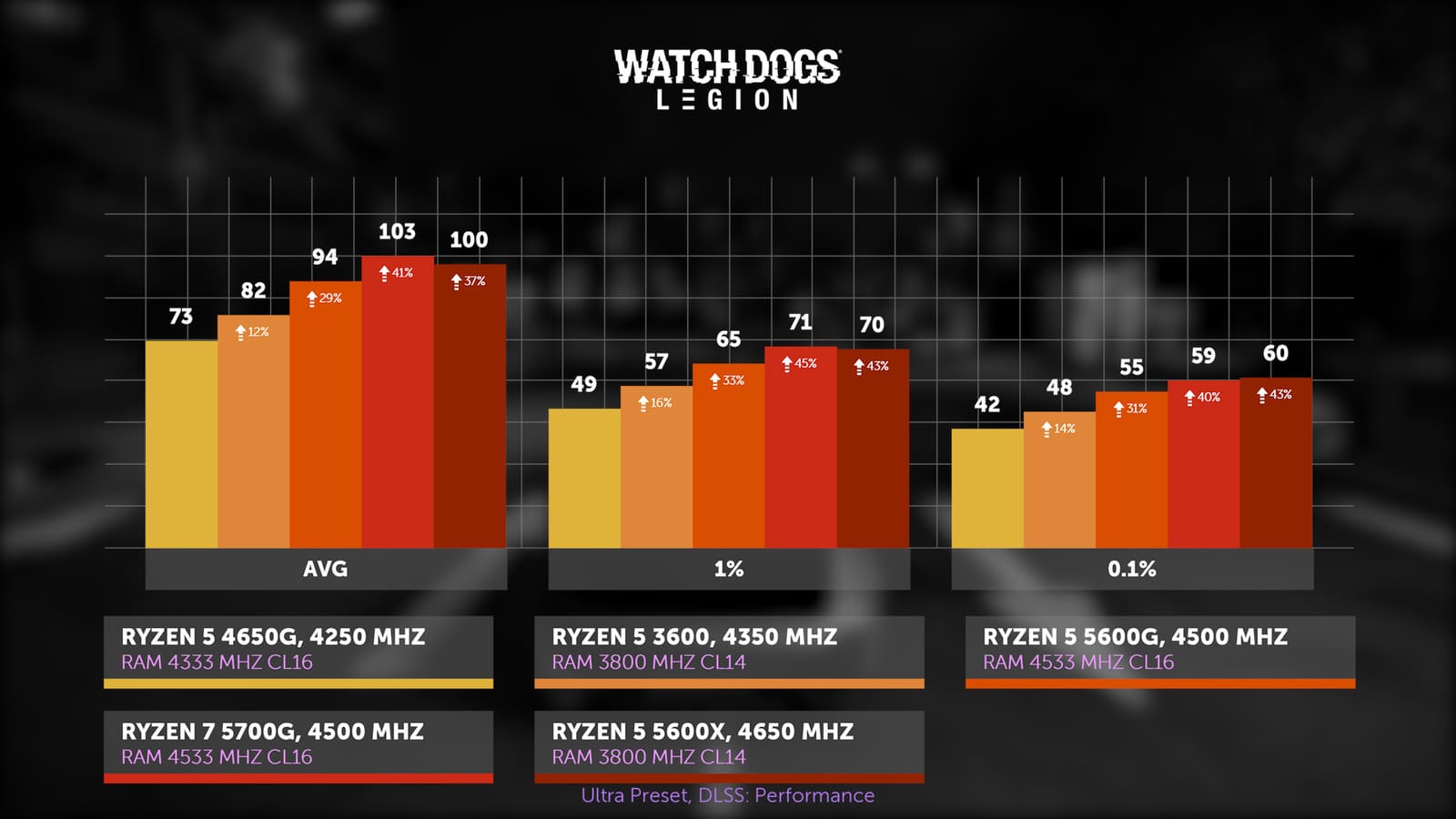
An interesting situation in Starcraft. While the 5600 and 5700G gained 23% and 19% overclocking gains, respectively, the 5600X increased its average FPS by just 5 units. This is only 6%. Yes, APUs have much better memory overclocking, but this situation is quite indicative, because it demonstrates how less often the 5600X has cache misses in this game. For example, in cyberpunk and watchdogs, the increase from overclocking on this processor was 22-23% in average FPS, while in lara it was already 15%, and here it’s only 6.
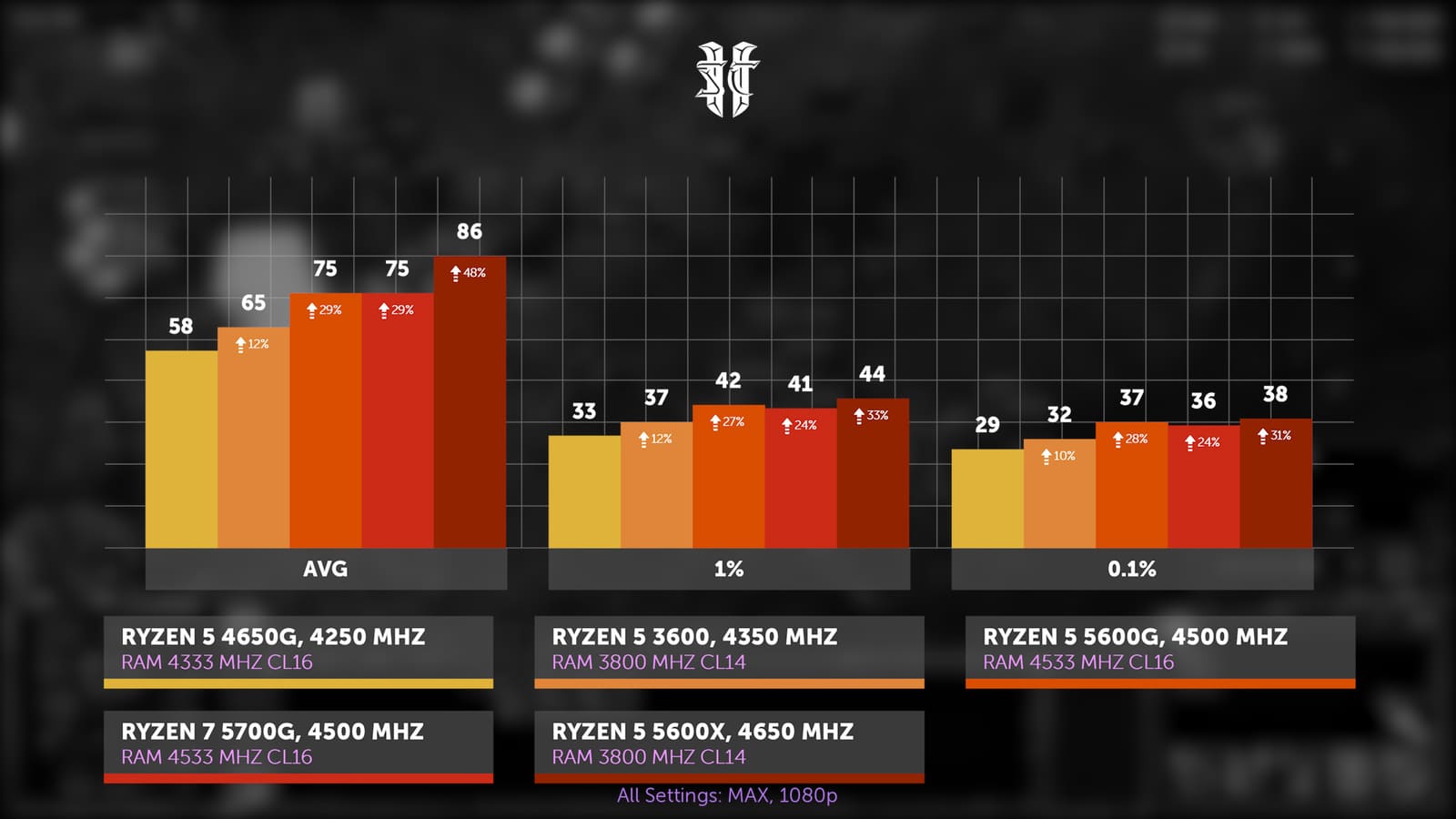
Remember the stock 5700G was only marginally faster than the 5600G and 5600X? It was worth overclocking the memory, and its advantage over the six-core counterpart increased from 12 to 25%. And the 5600X, due to less memory overclocking, almost caught up with the 5600G, but it was more surprising that the 4650G quietly bypassed the ryzen 5 3600.
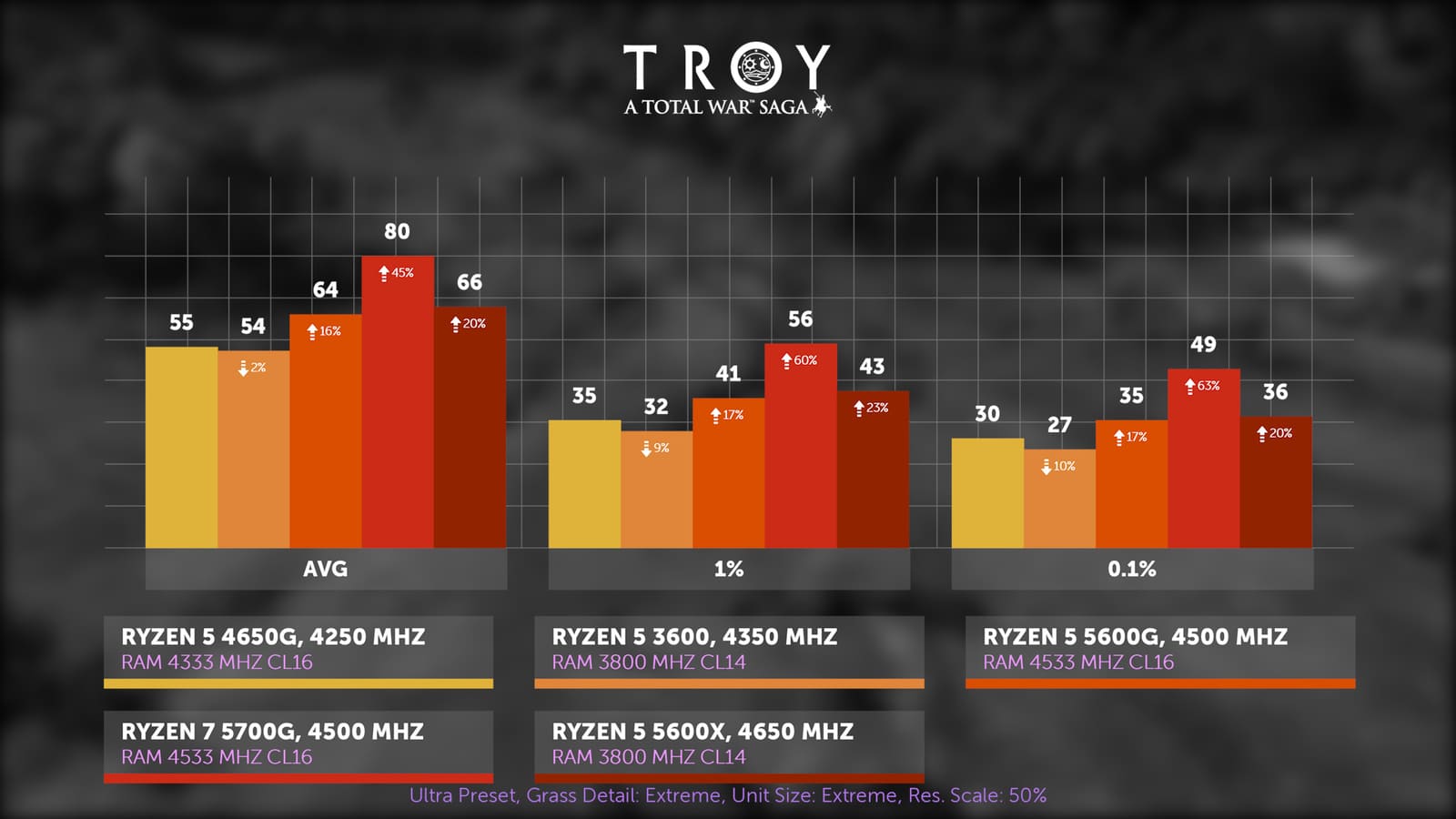
Guess how much overclocking the 5600X got in CS:GO. 20, 10 or 5%? Less – 2.8! Given the measurement error, which varies from launch to launch of the game, this can be entirely the merit of a fixed frequency that does not fall below 4650 MHz. Not to say that APU’s shine with growth. The 5600- and 5700G got 8-9% extra frames, while the 4650G got 13%. Considering that the frequency of the cores did not change much with overclocking, it is noticeable how much higher the gain from overclocking memory becomes for processors with a smaller L3 cache.
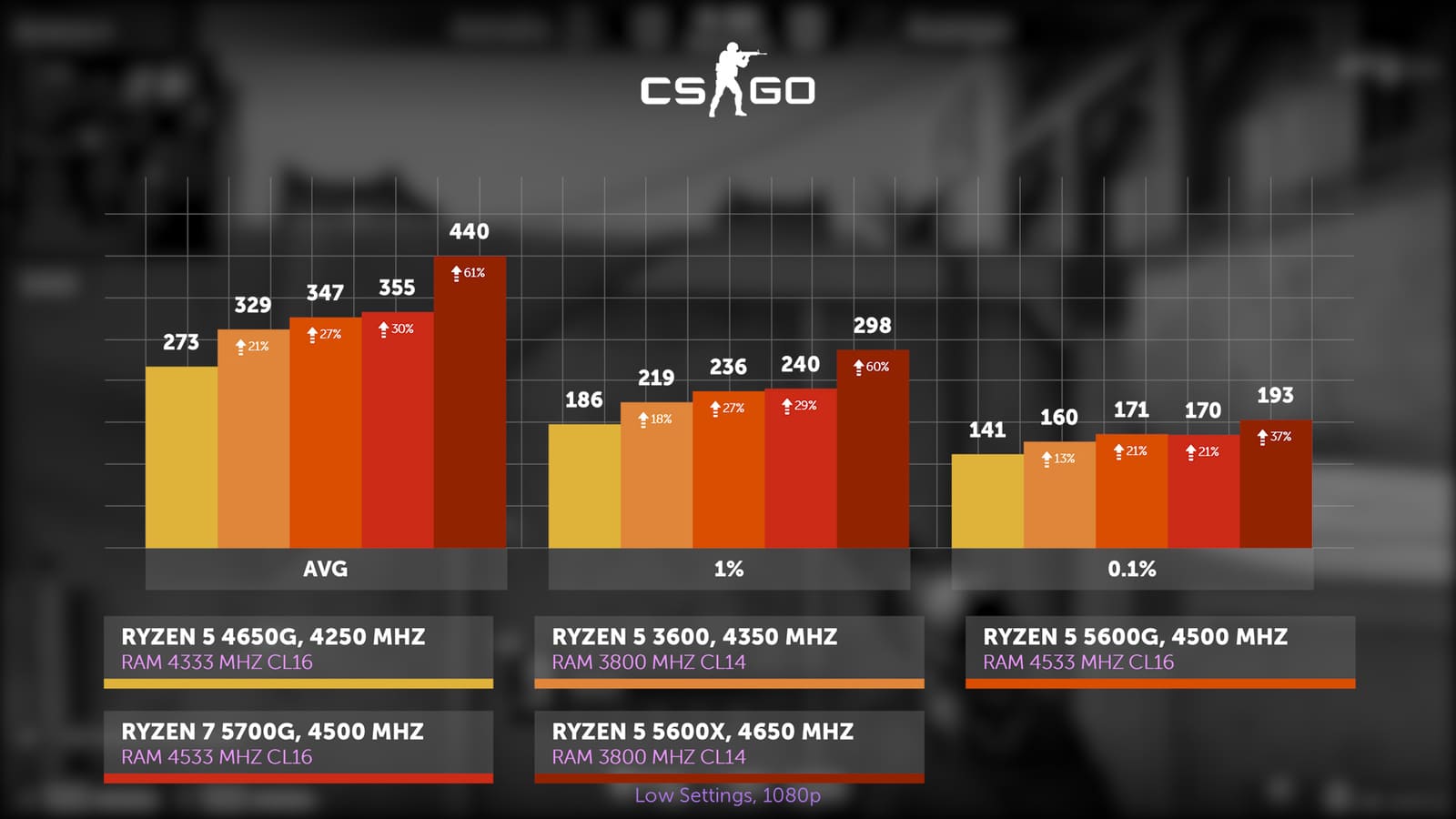
And what do we have on average now? The 5600G is 13% faster than the ryzen 5 3600 and 11% faster than the 5600X than its numbered namesake. It turns out that with good memory overclocking we get something in between 5600X and 3600. We would like more, but the dominance of a solid 32 MB L3 cache in some games played its role. If we were to replace lara, counter and starcraft with games like dogs, troy and cyberpunk, the scales would shift towards APU.
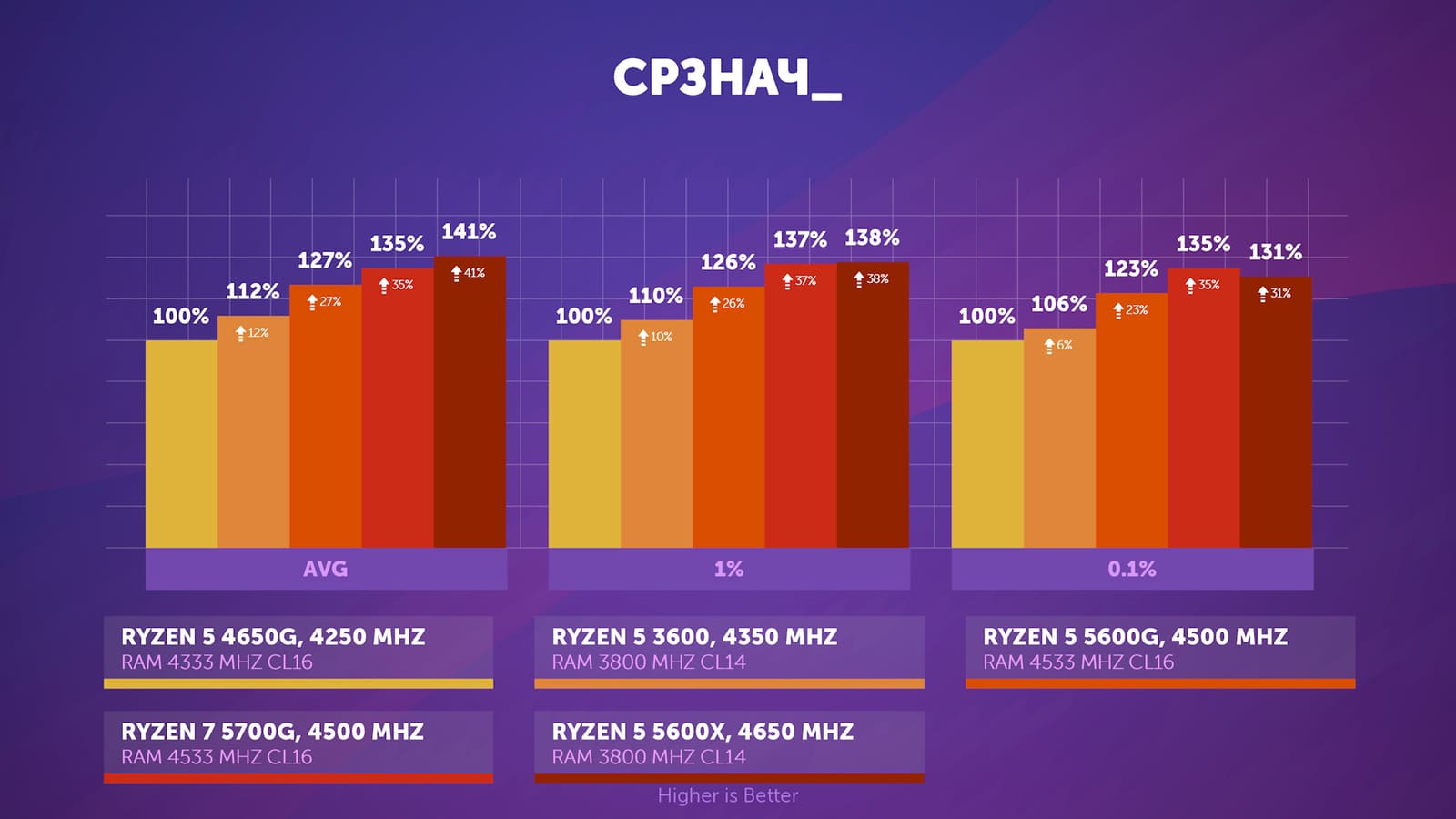
What do two memory controllers give?
It’s interesting to find out how much the two memory controllers and slightly more overclocking potential of the new APUs gave in games that are more apathetic towards the cache. Let’s take a 5600G with three memory settings and compare them in cyberpunk and watch dogs with the 5600X, lowering its core frequency to the same 4500 MHz so that it does not confuse the cards.
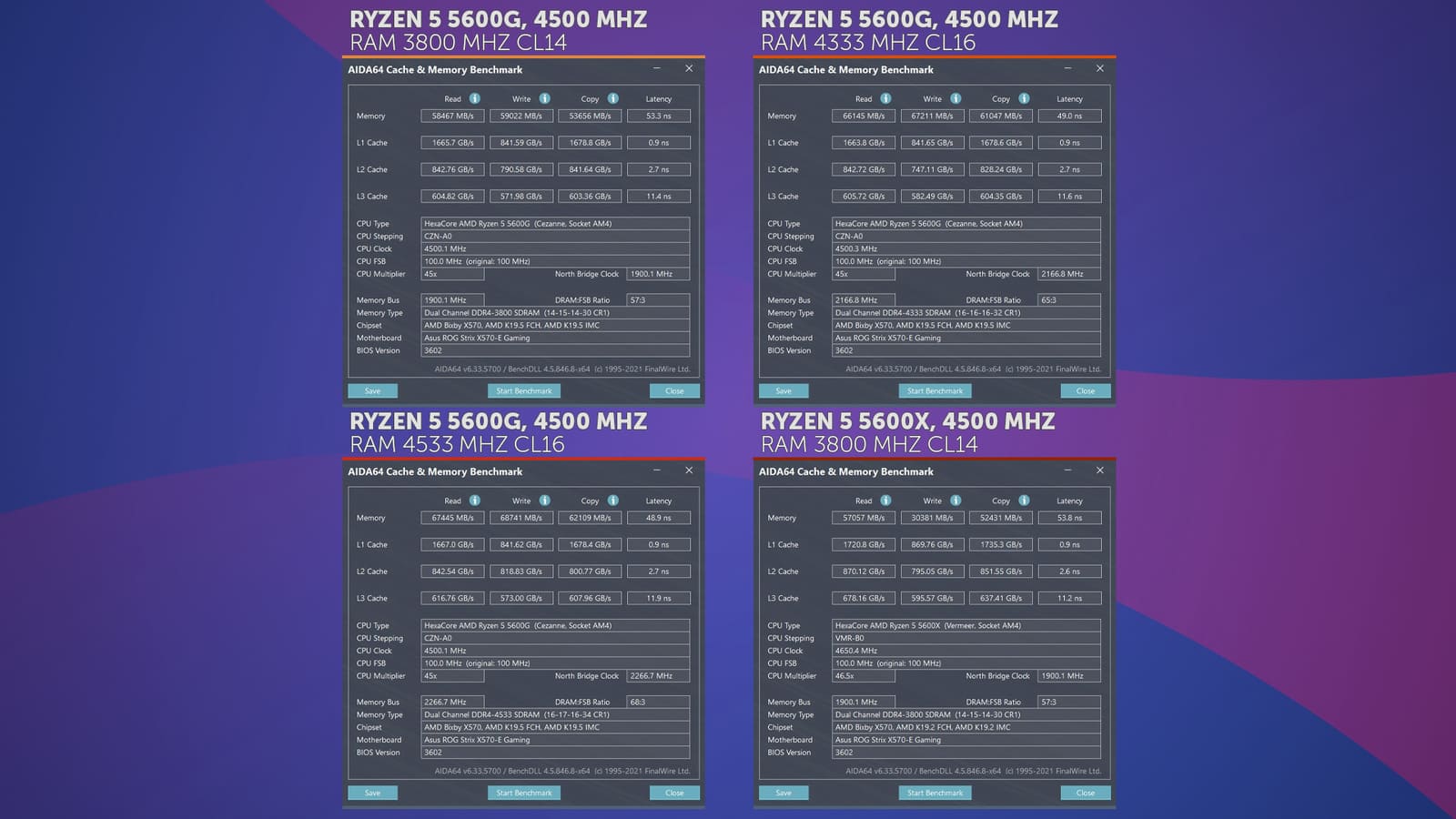
In the first game, 200 MHz did not give anything, since the timings increased slightly with them, reducing the increase to the level of error. However, compared to 3800 MHz, there is already a nice bonus in the form of 9% additional frames on average. And if not for him, then, as in stock, the 5600X would be ahead of the G-version by 12%, and not by 4.
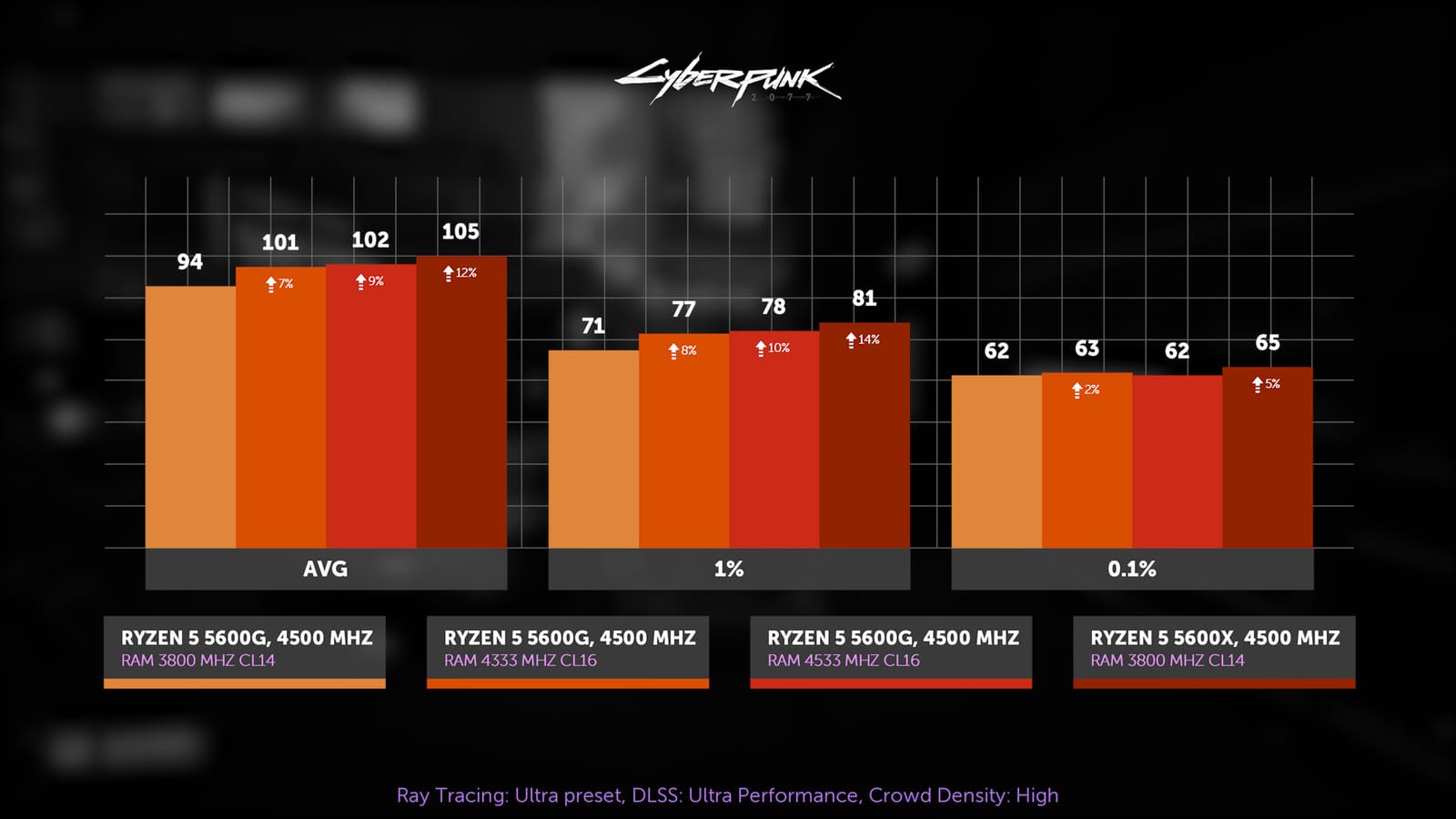
In dogs, the difference is smaller. At 733 MHz, a higher memory frequency with its corresponding timings allows you to get only 6% more FPS on average, and according to the statistics of rare and very rare events, the difference is even smaller. The difference between accelerations in the center once again reminds of the absence of the need to squeeze all the juice out of iron.
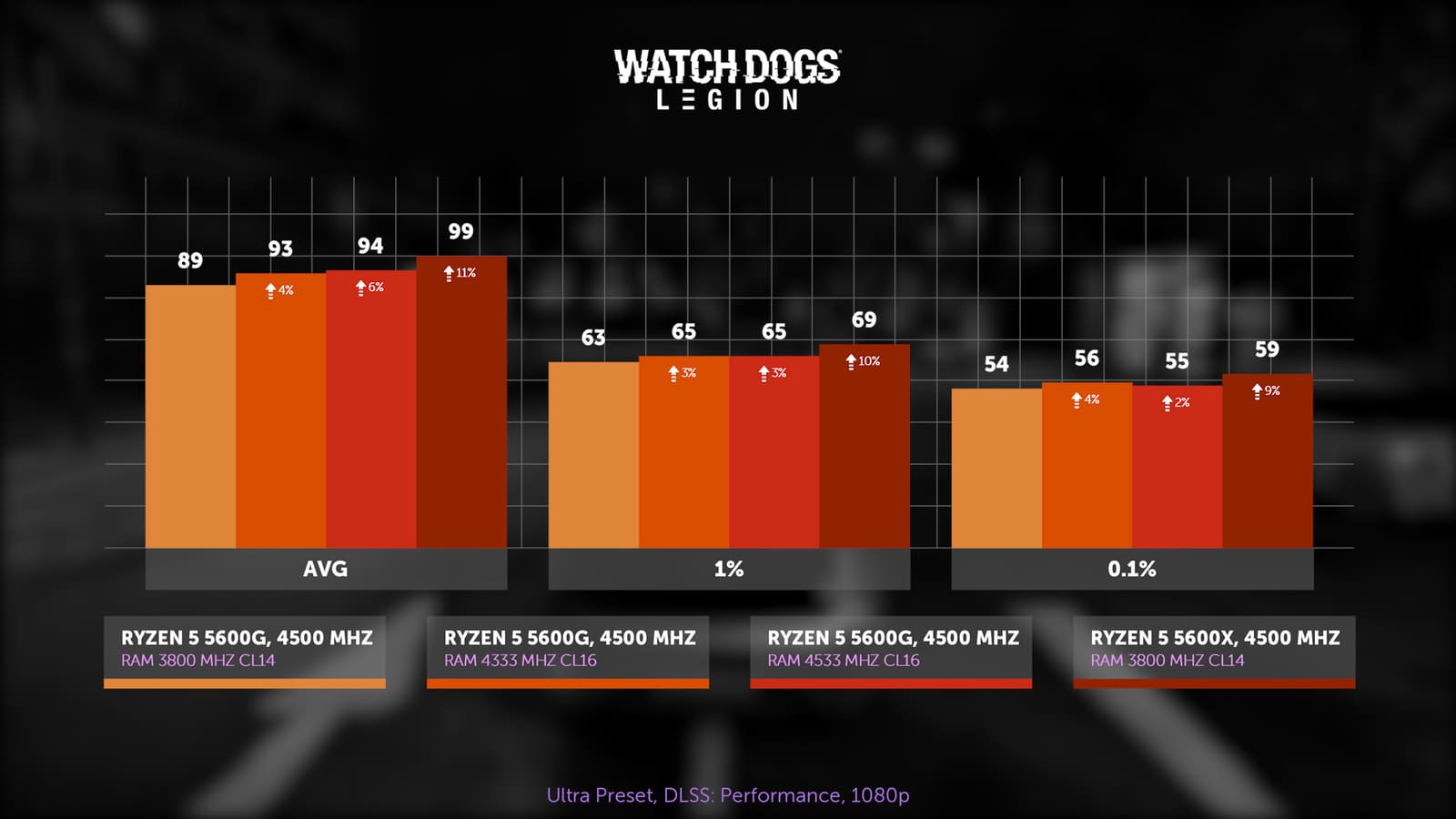
Conclusion
What comes out in the end? The processor part of the APU has remained somewhere between the past and the current generation of conventional ryzen processors, even despite the reduction in the backlog in terms of L3 cache and greater memory overclocking. That is, the 5600G cannot be called an analogue of the 5600X. In any case, the performance is much higher than the 4000 series.
In terms of integrated graphics, there were no changes on paper, but we somehow got a small increase.
The Ryzen 7 5700G is a little disappointing. In terms of gaming, it is practically indistinguishable from the 5600G both in terms of graphics and processor parts, but it costs significantly more. The past tells us that each new generation of Ryzen 600 line outperforms in games or at least not worse than the previous generation 700, but costs less.
The 5700G is revealed in work tasks that involve all threads like the same bluebench.
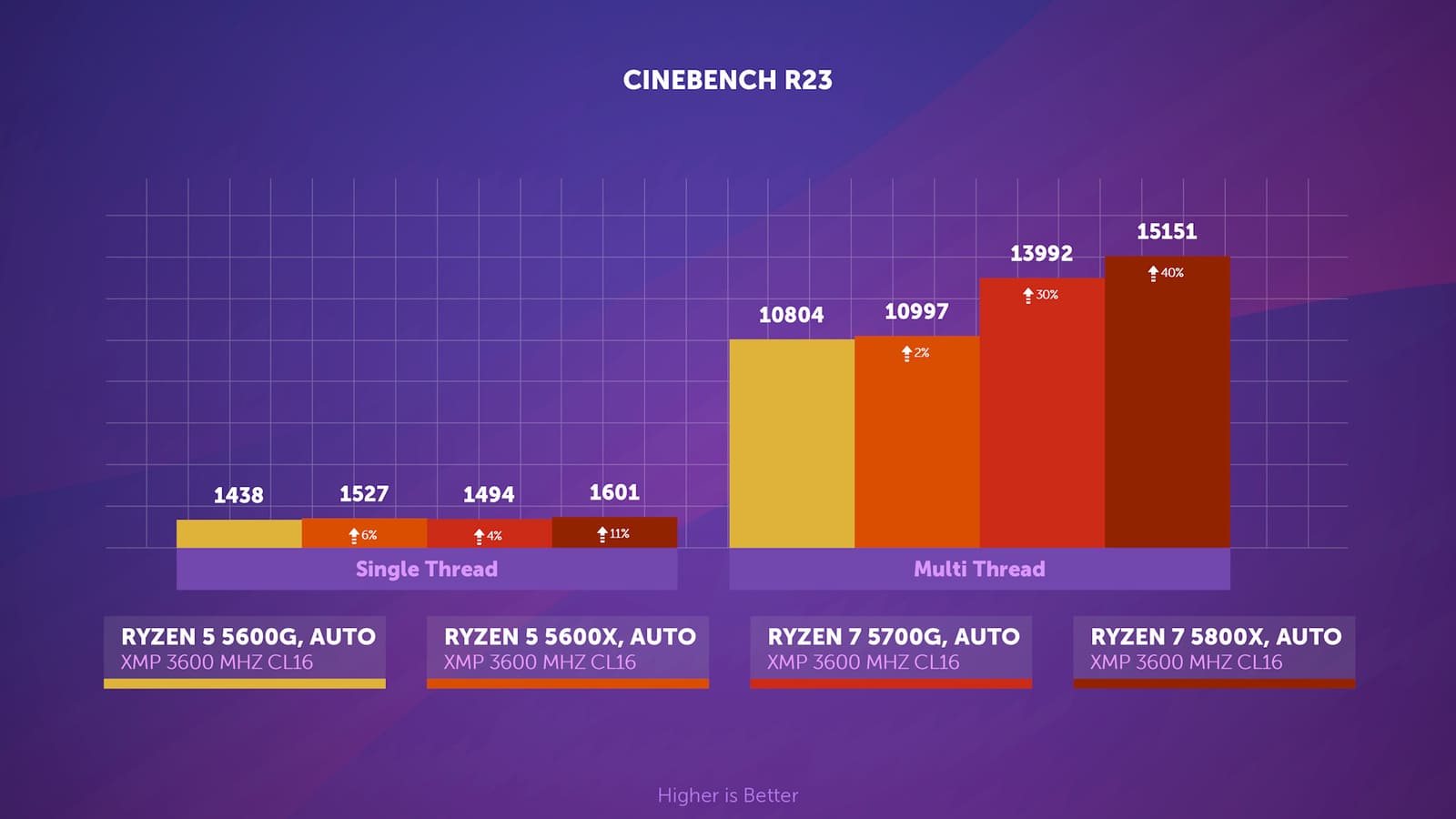
The performance is close to the 5800X (especially if you remove the limits), and the heat dissipation and temperatures are much lower.
And that is all. Thanks for reading, stay safe and see you soon.




